by GardenLover | Aug 19, 2016 | Garden profile, Trendspotting
Twelve Ideas You’ll Dig
By Teresa Woodard
Throughout the heartland this summer, private gardeners have graciously opened their garden gates for public garden tours. Whether it’s a pocket garden, estate landscape or suburban backyards, I always find plenty of inspiration. I jot down notes on new plants to try, clever plant combinations and innovative design details to borrow.
Here are a dozen of my favorites.
1) Design a seating area around a container water garden. It’s a conservation piece, easier to install than an in-ground water feature and adds to the view from indoors.
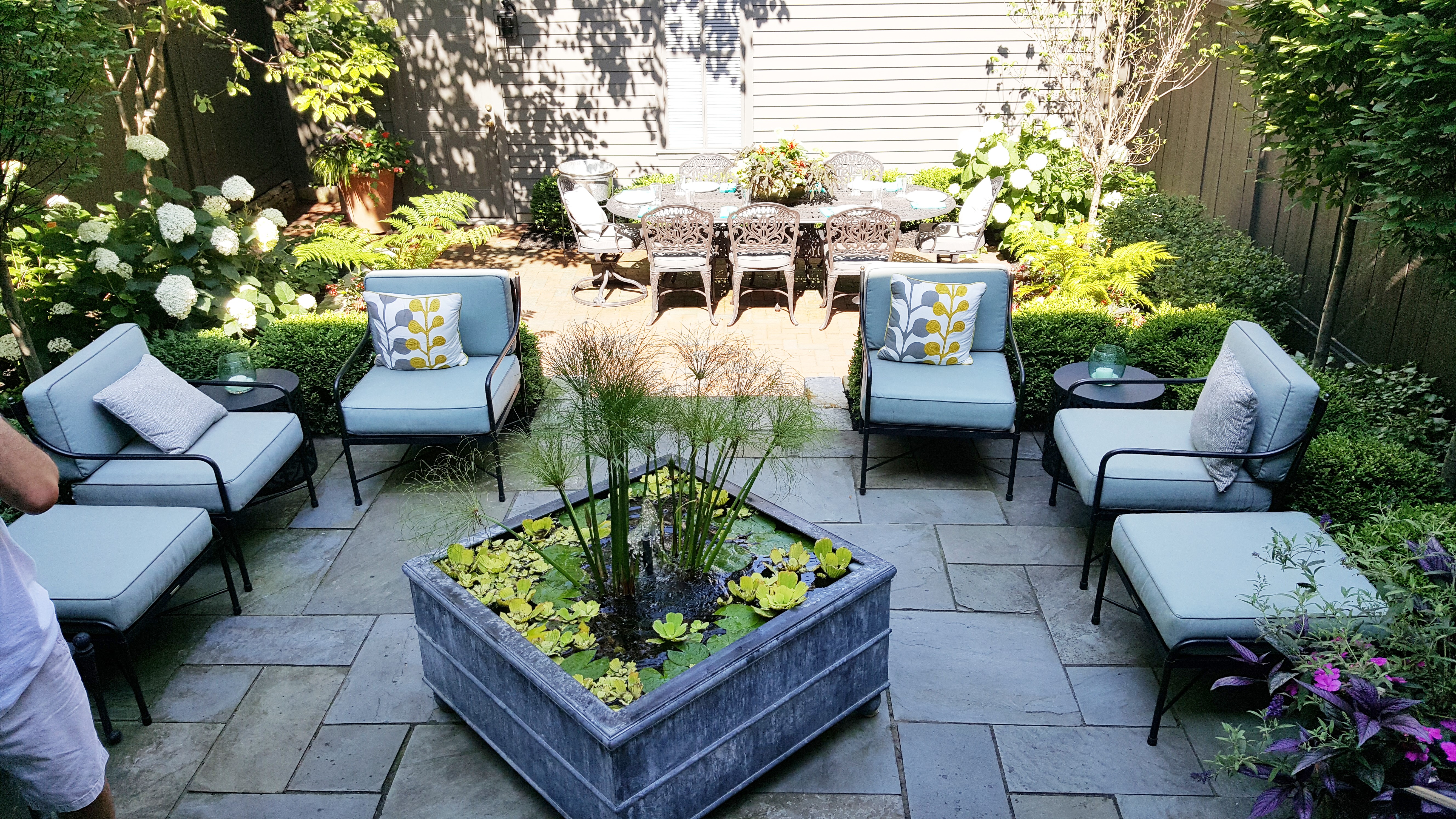
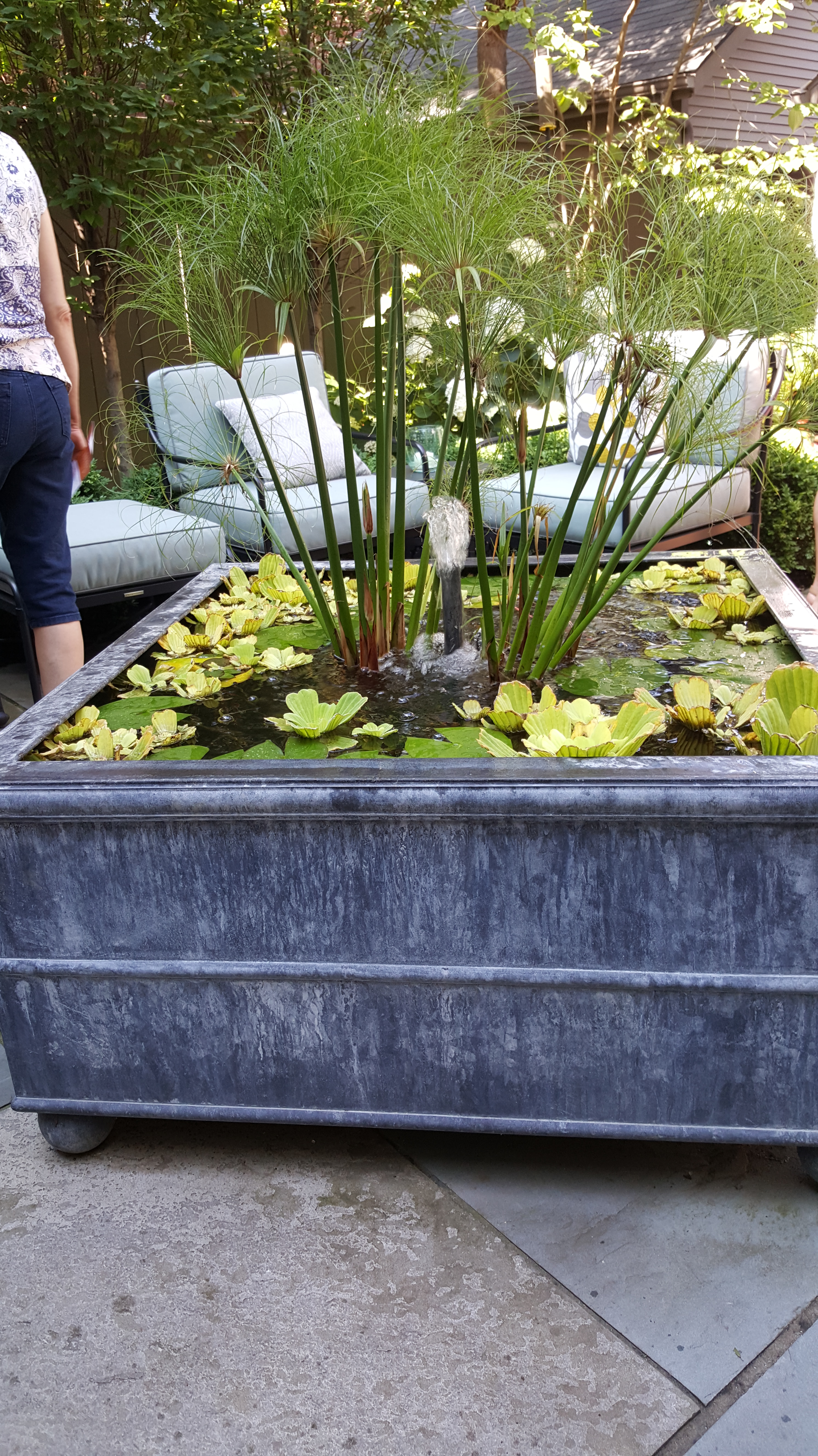 2) Look for a spot to plant an allee of trees like this one of hornbeams.
2) Look for a spot to plant an allee of trees like this one of hornbeams.
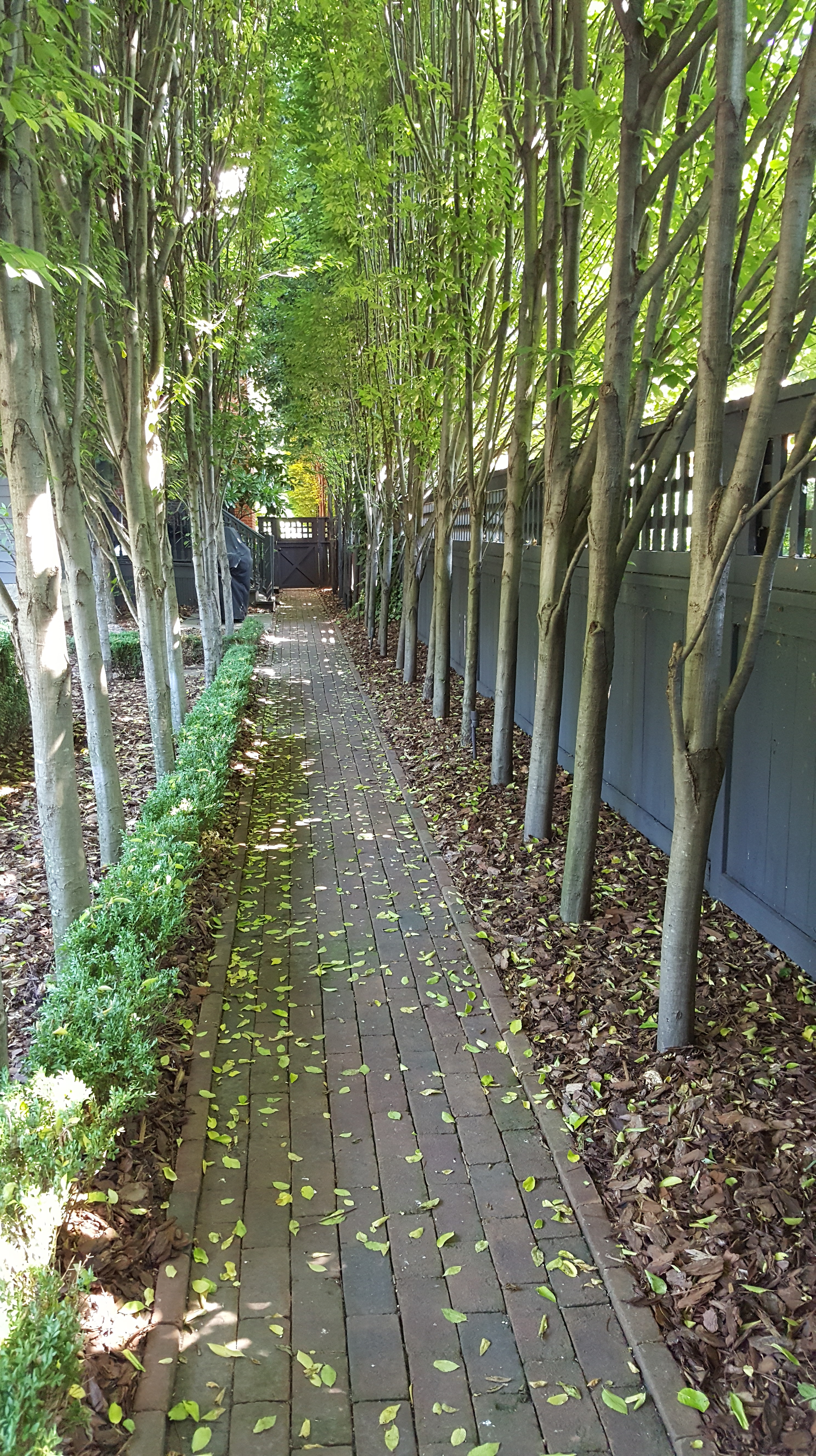
3) Vertical gardening: Whether its a wall with fabric pockets, cement blocks or pots on a fence, these vertical gardening options offer a new way to garden up and maximize tight spaces.
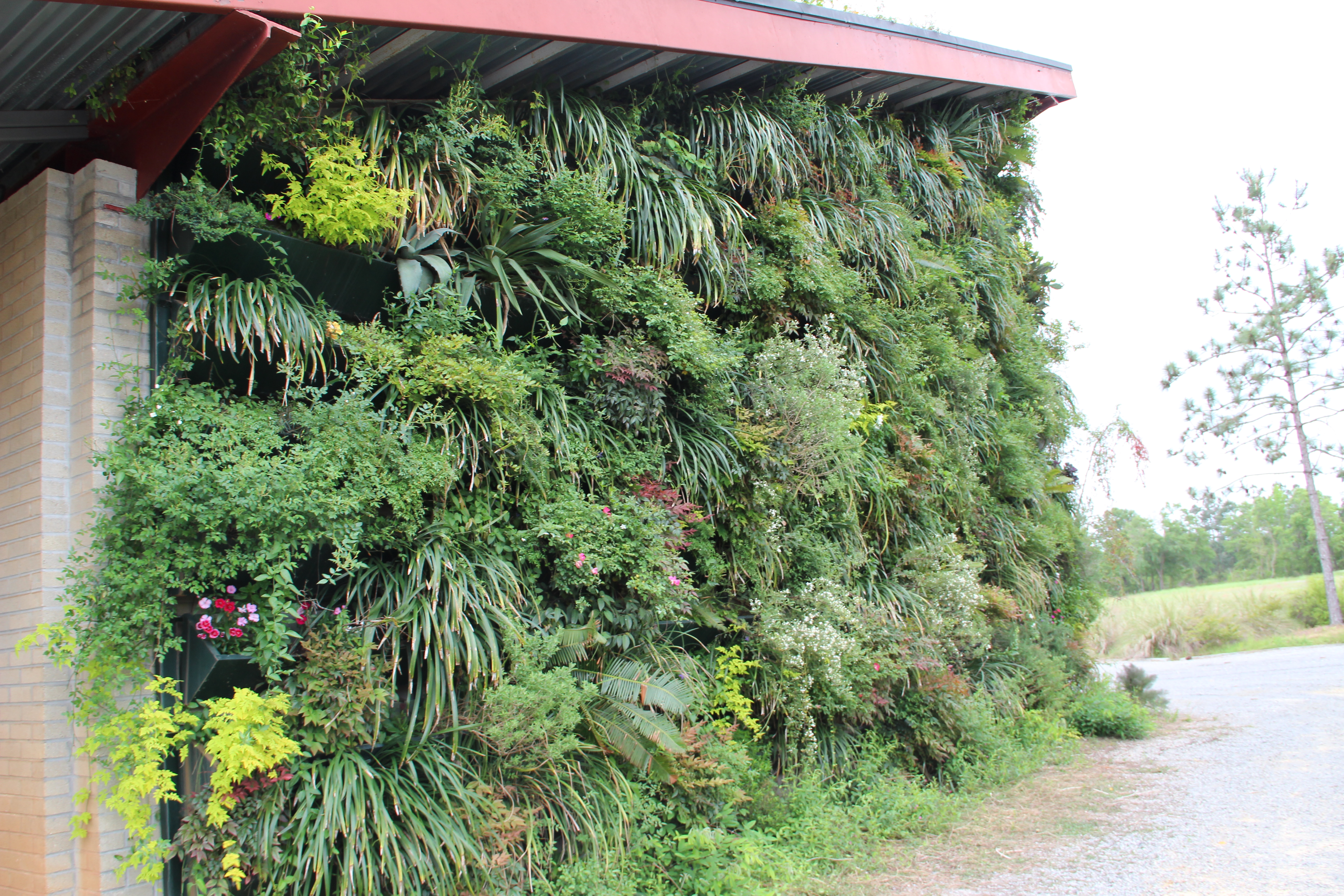
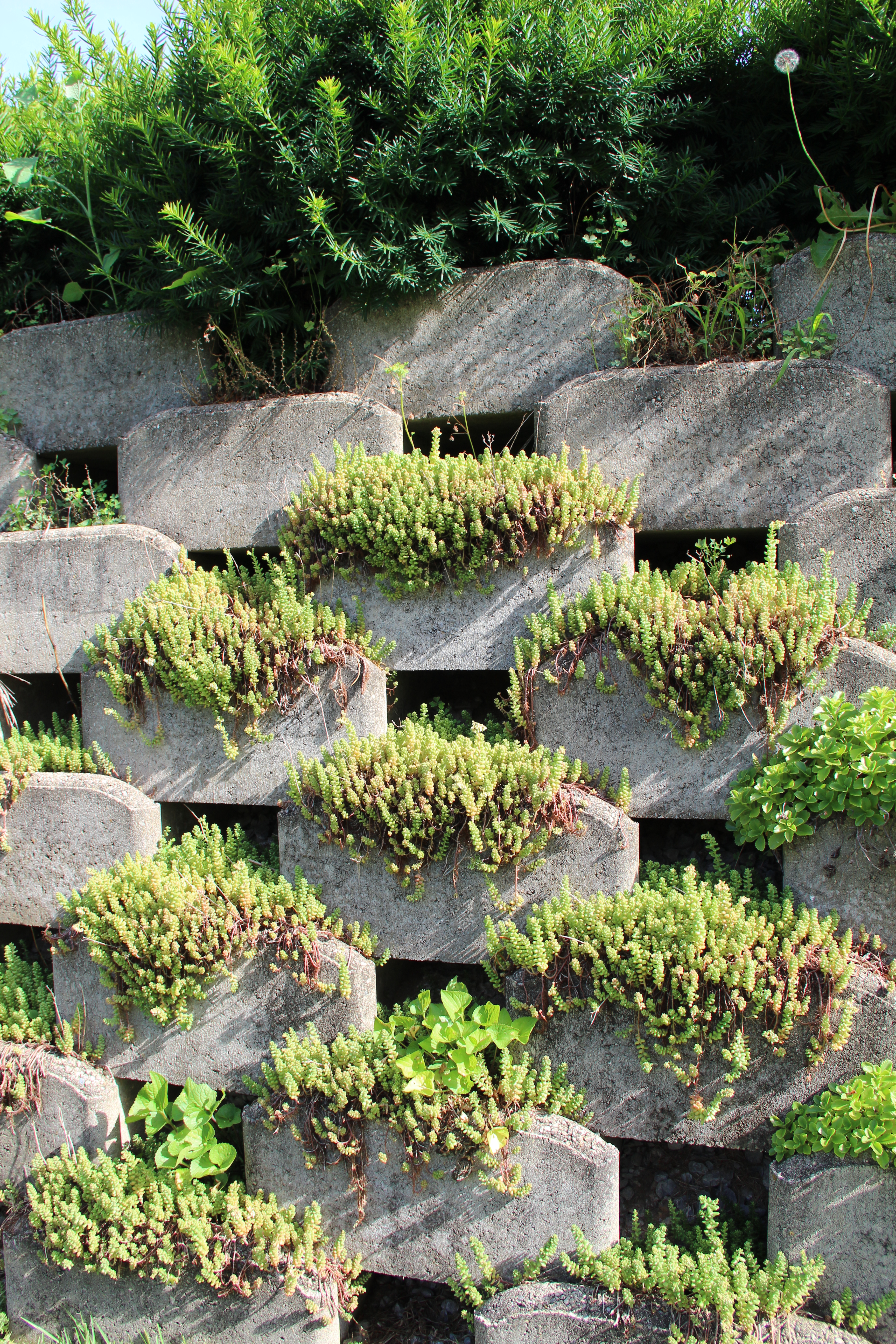
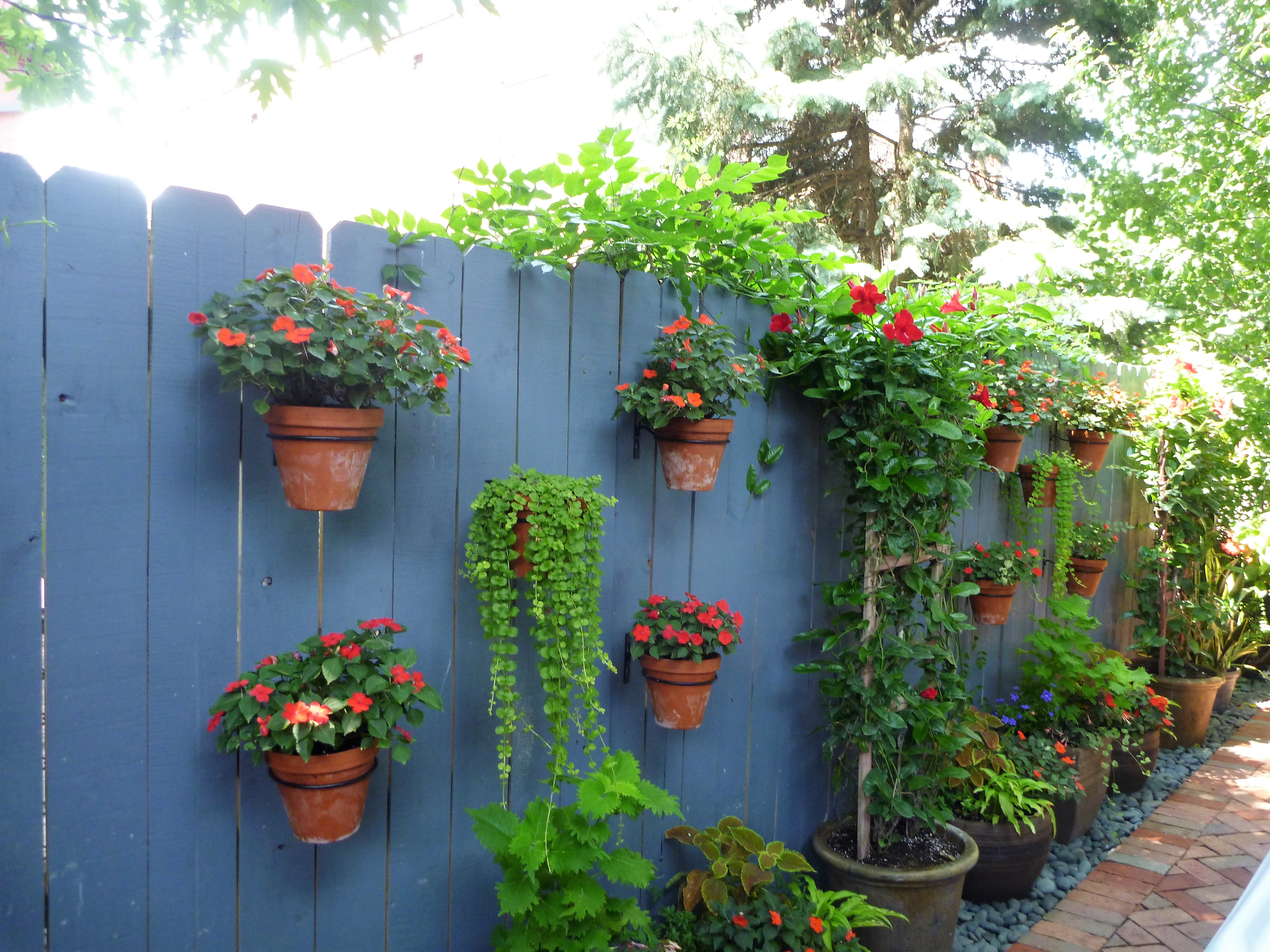
4) Underplant shade tree and garden bench with liriope. The plant blooms purple flowers in the spring and offers an attractive groundcover to thwart weeds. Simply weed-wack the liriope in the late fall or early spring.
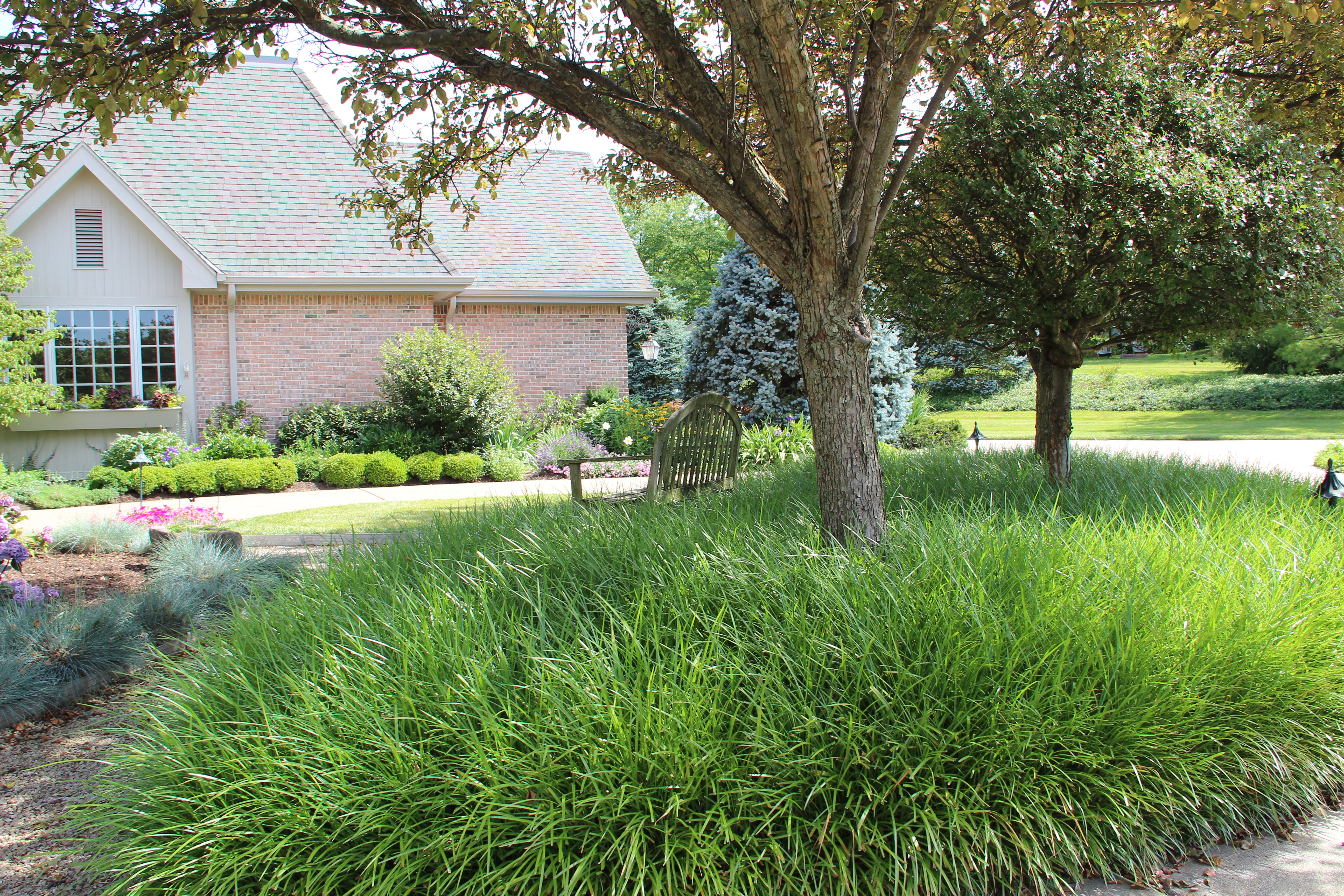
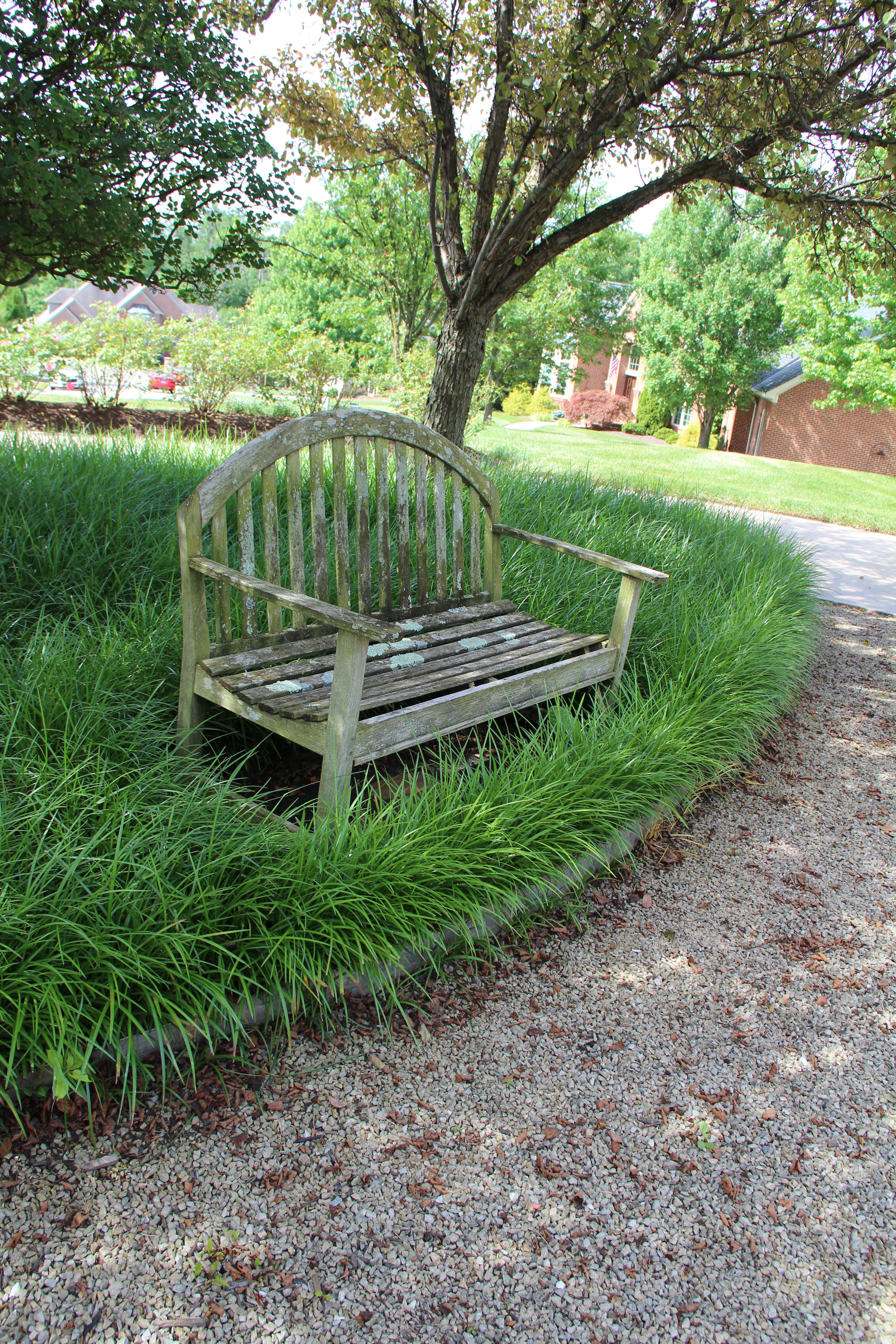
5) Support the craft brew craze and plant some hops.
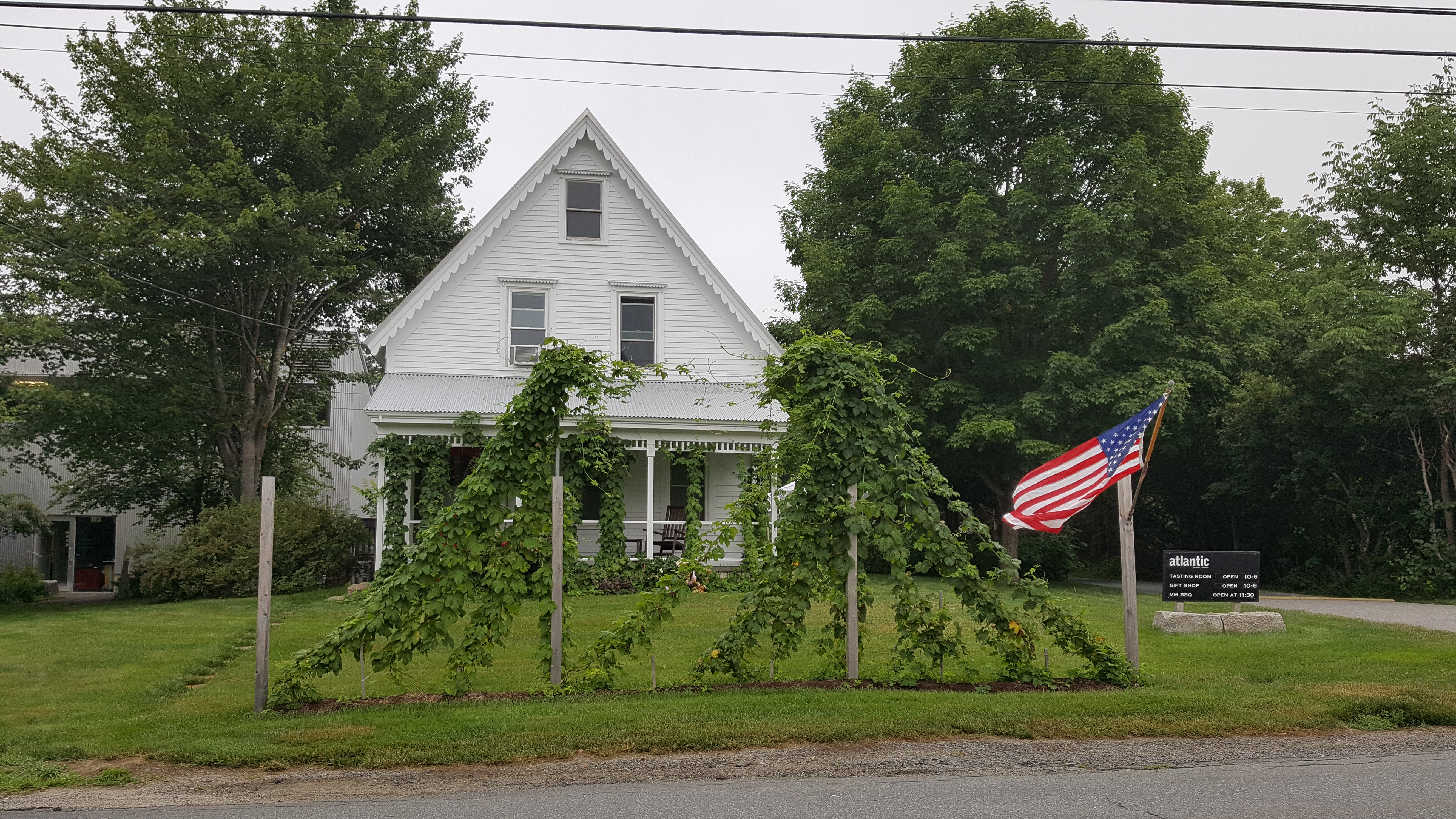
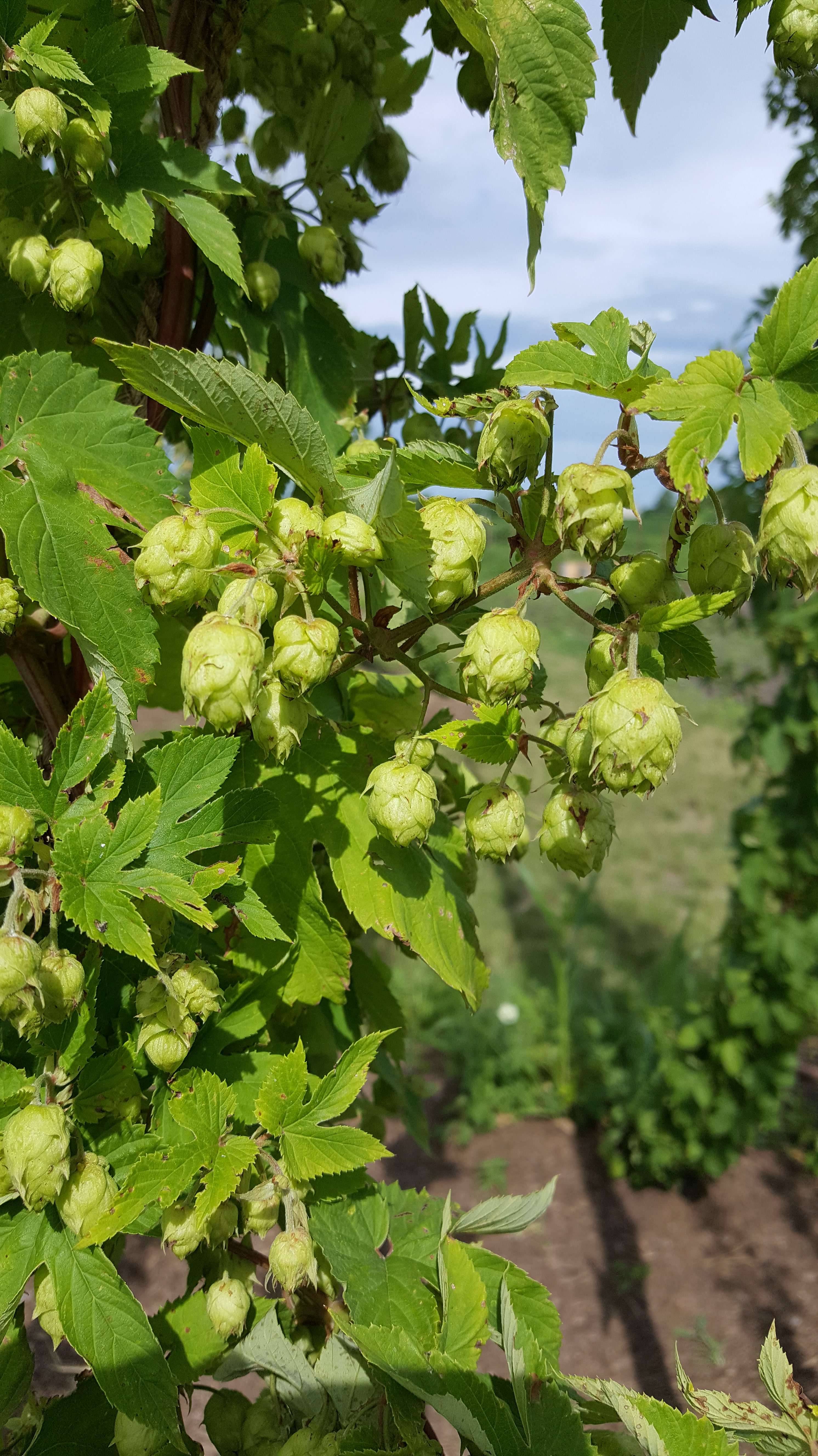
6) Be more creative and try the unexpected.
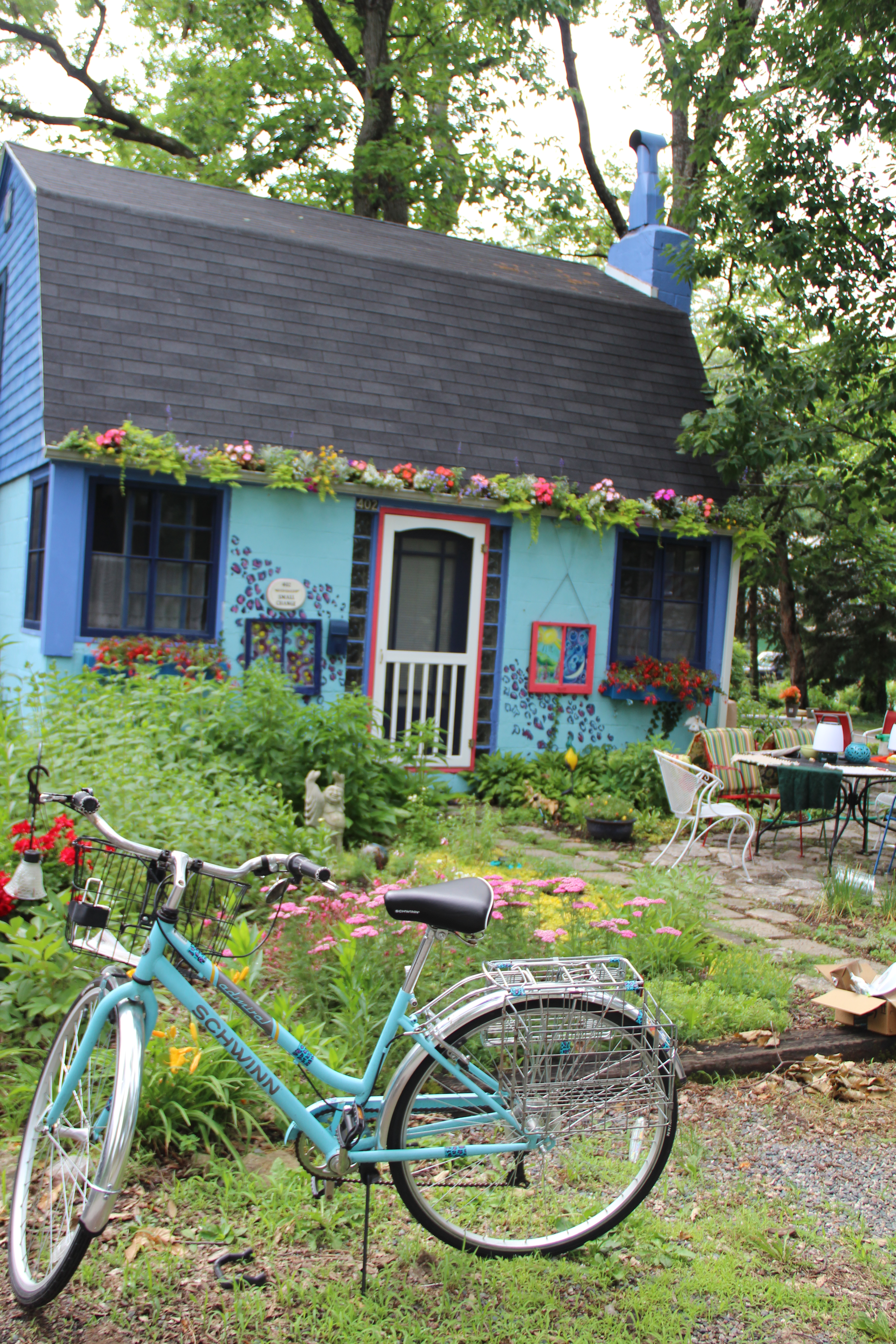
7) Spray paint salvaged finds blue then add them to an all-green landscape bed like this one filled with hostas.
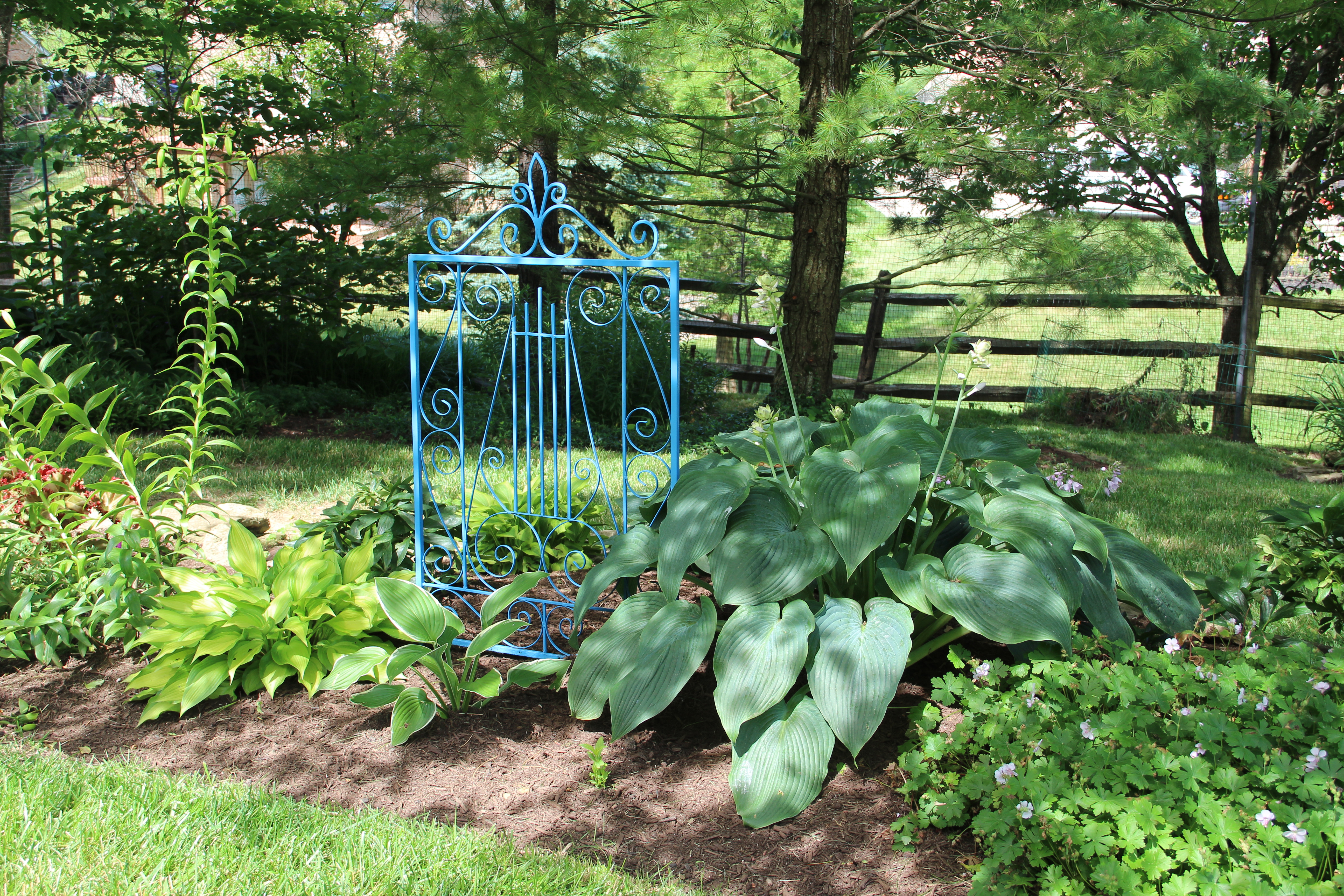
8) Add this native Queen of the Prairie to a moist spot in the yard. I love its showy June blooms.
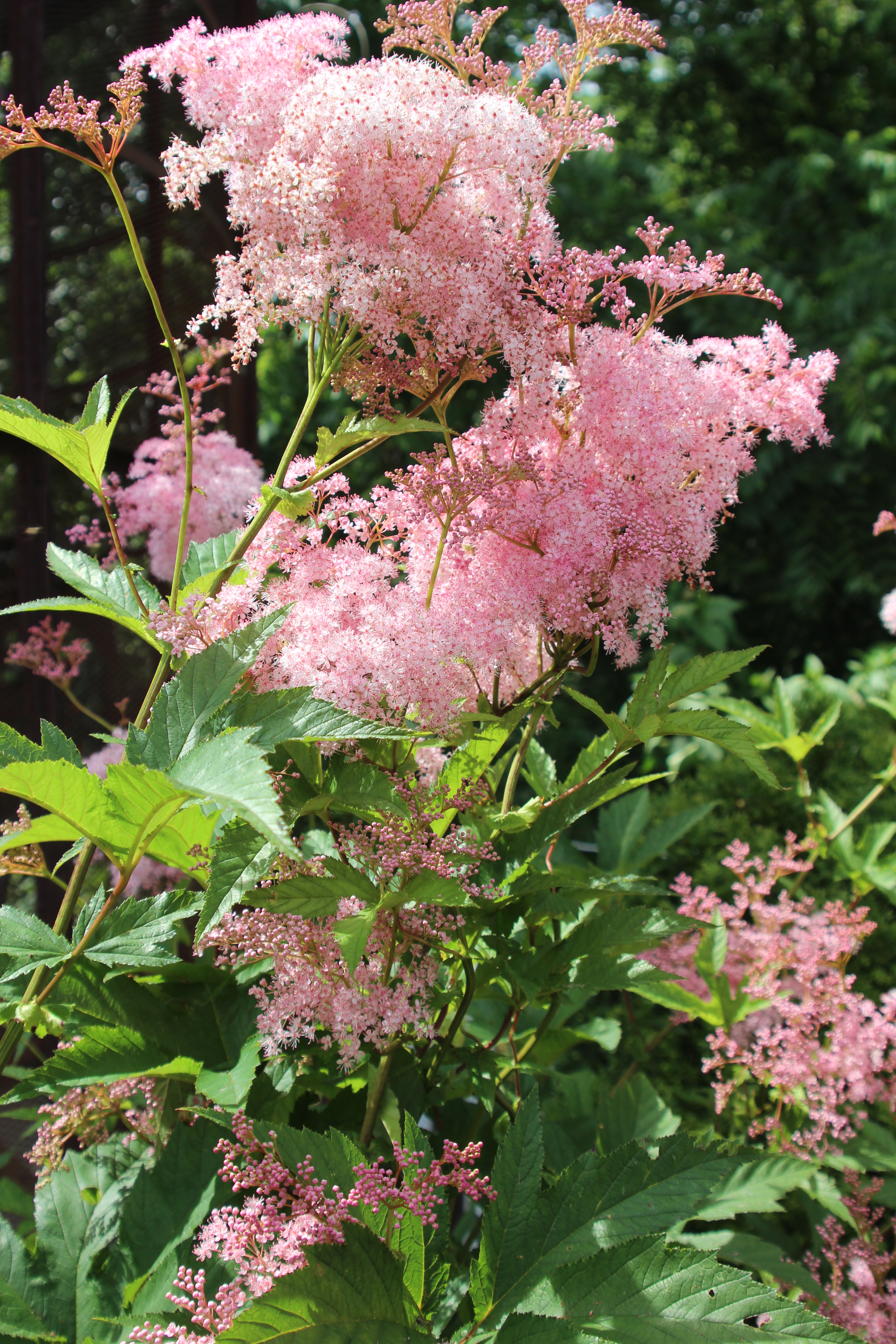
9) Go beyond the conventional turf.
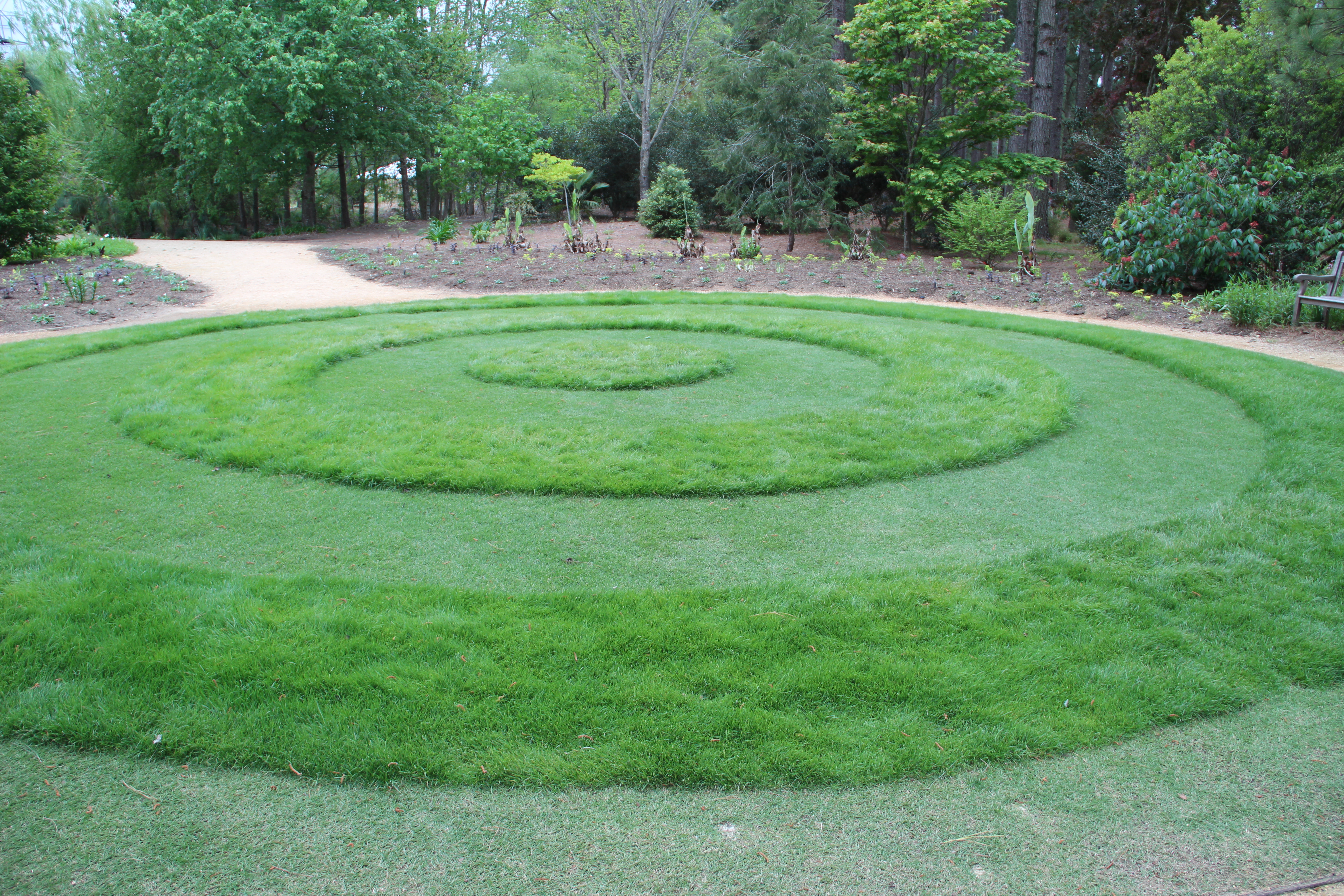
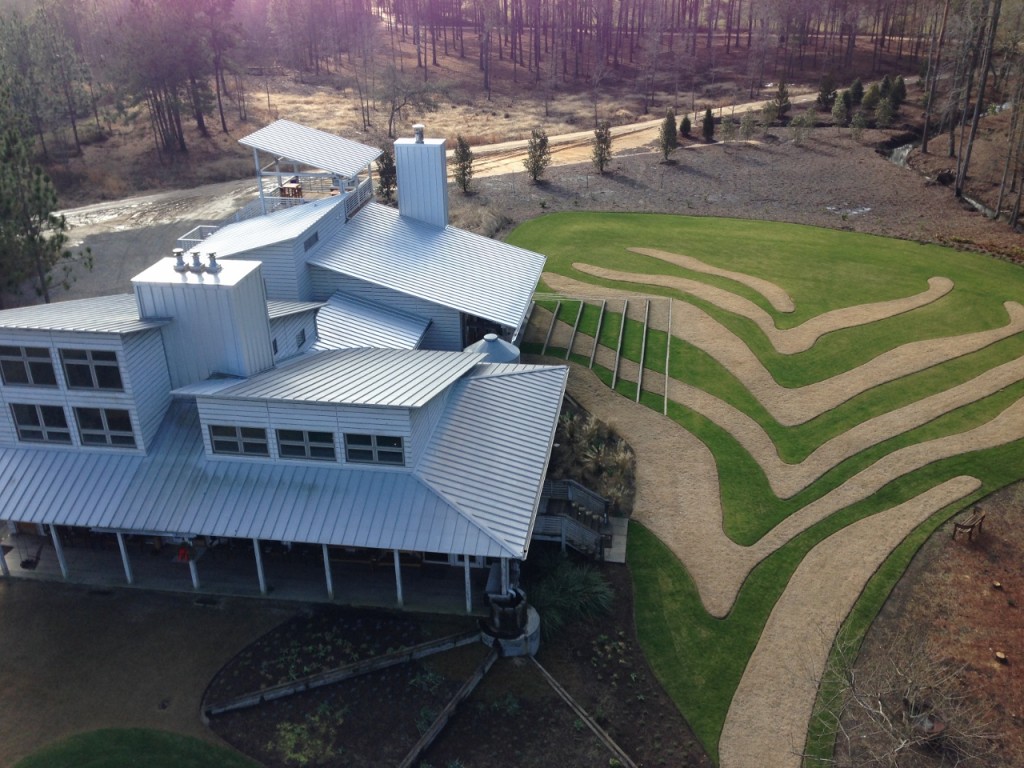
10) Find a spot for water-loving spring primrose.
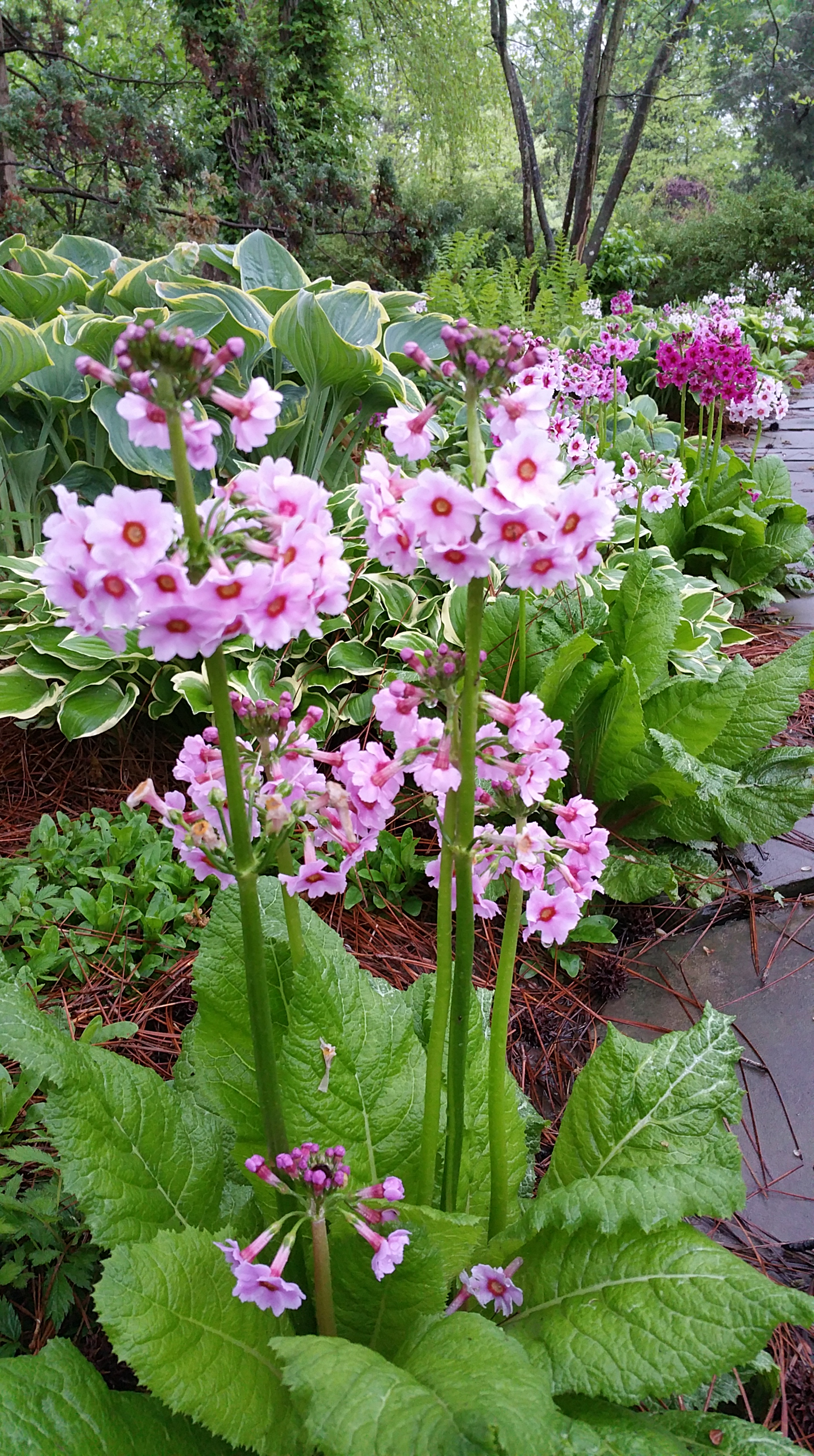
11) Incorporate more annuals. They add seasonal color and fill bare spots in the landscape.
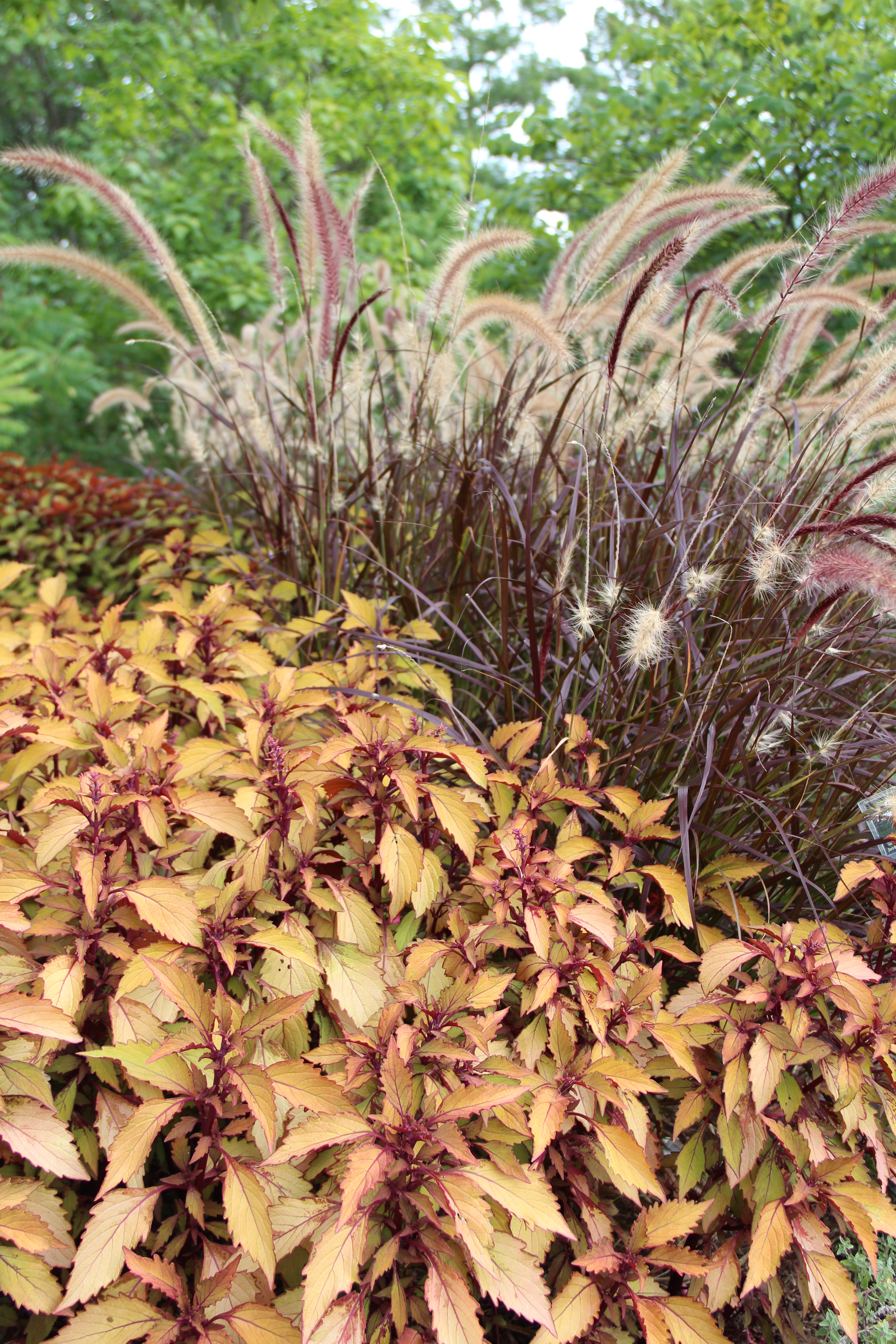
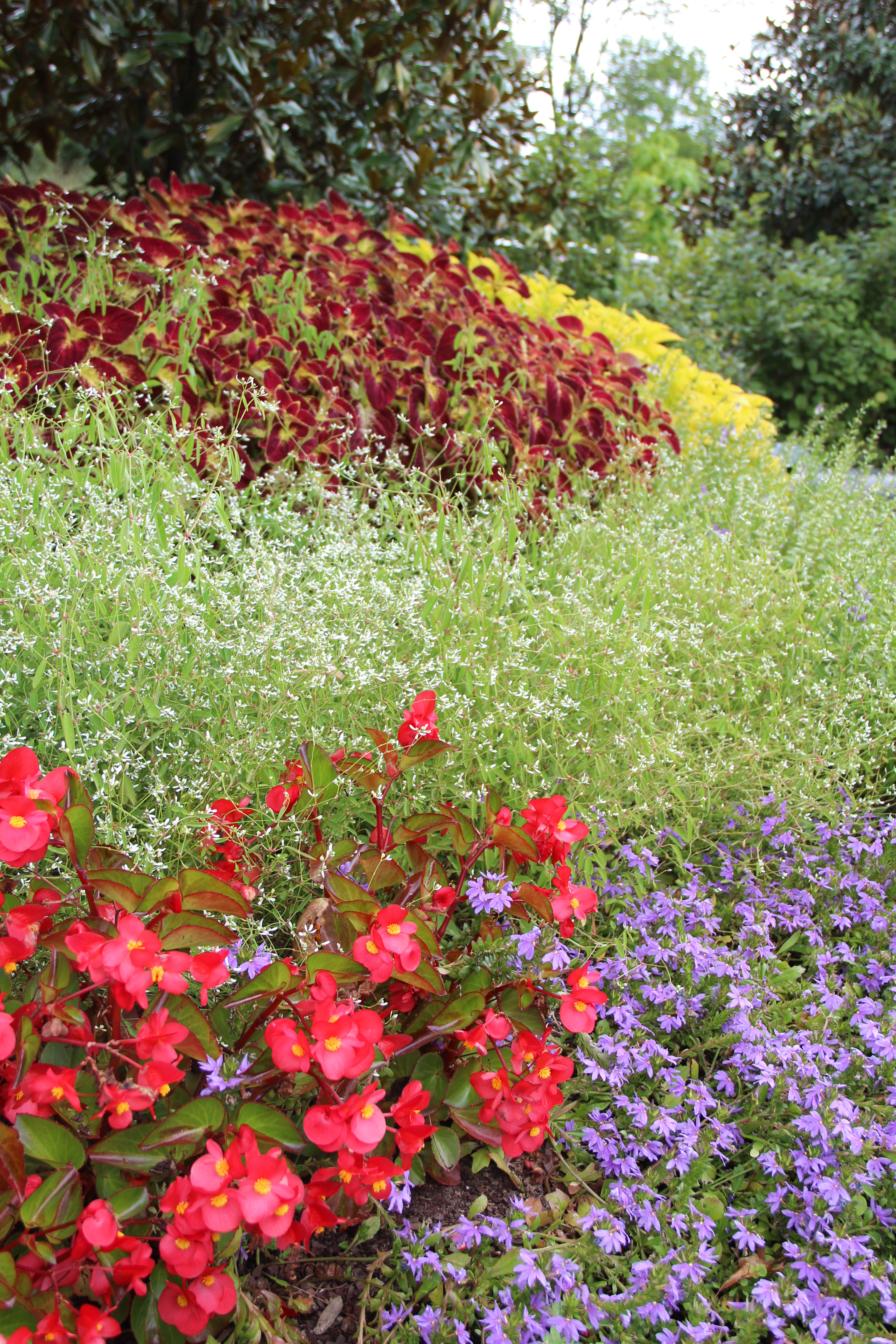 12) Create a small bog garden and fill it with pitcher plants like these.
12) Create a small bog garden and fill it with pitcher plants like these.
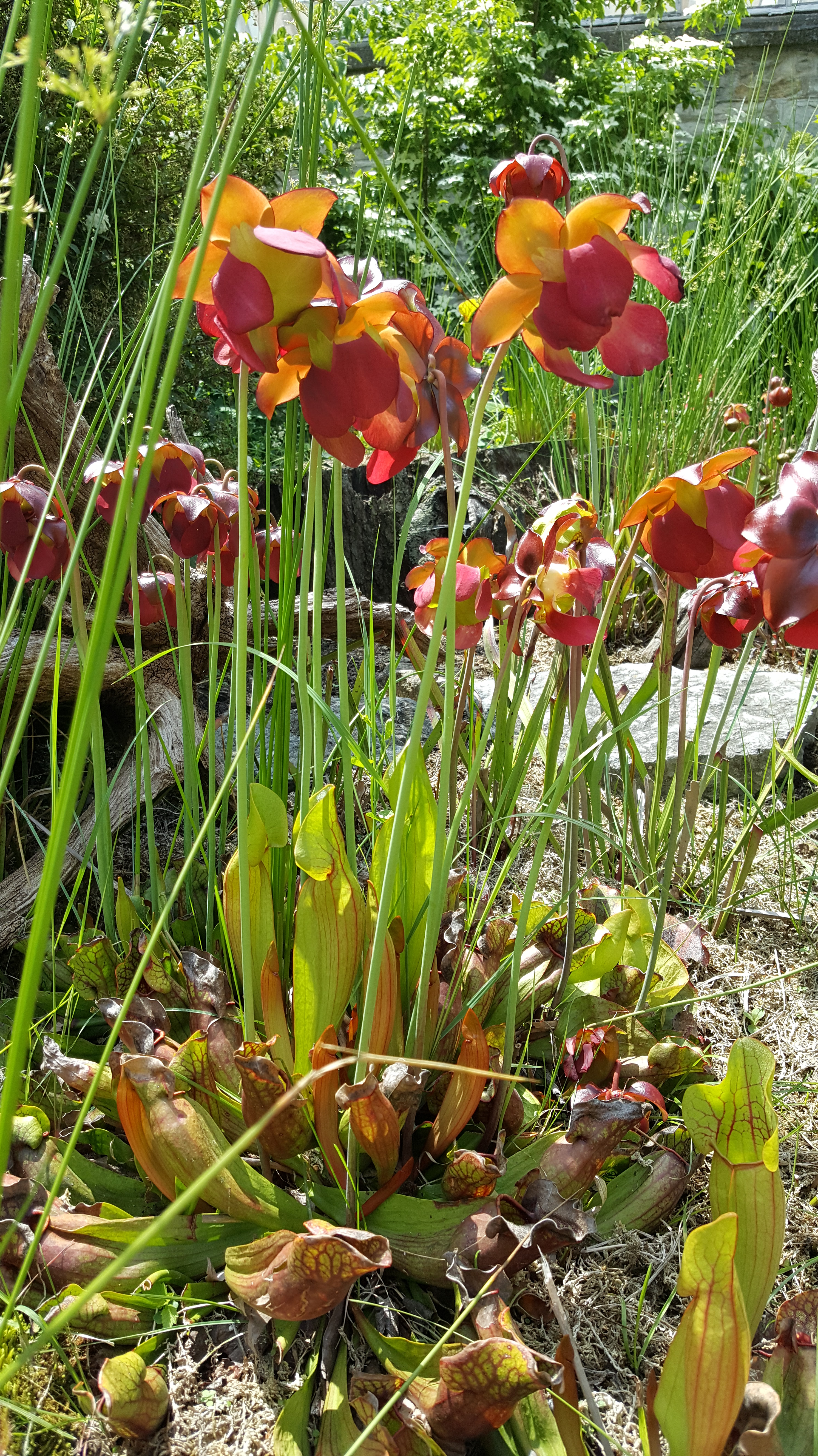
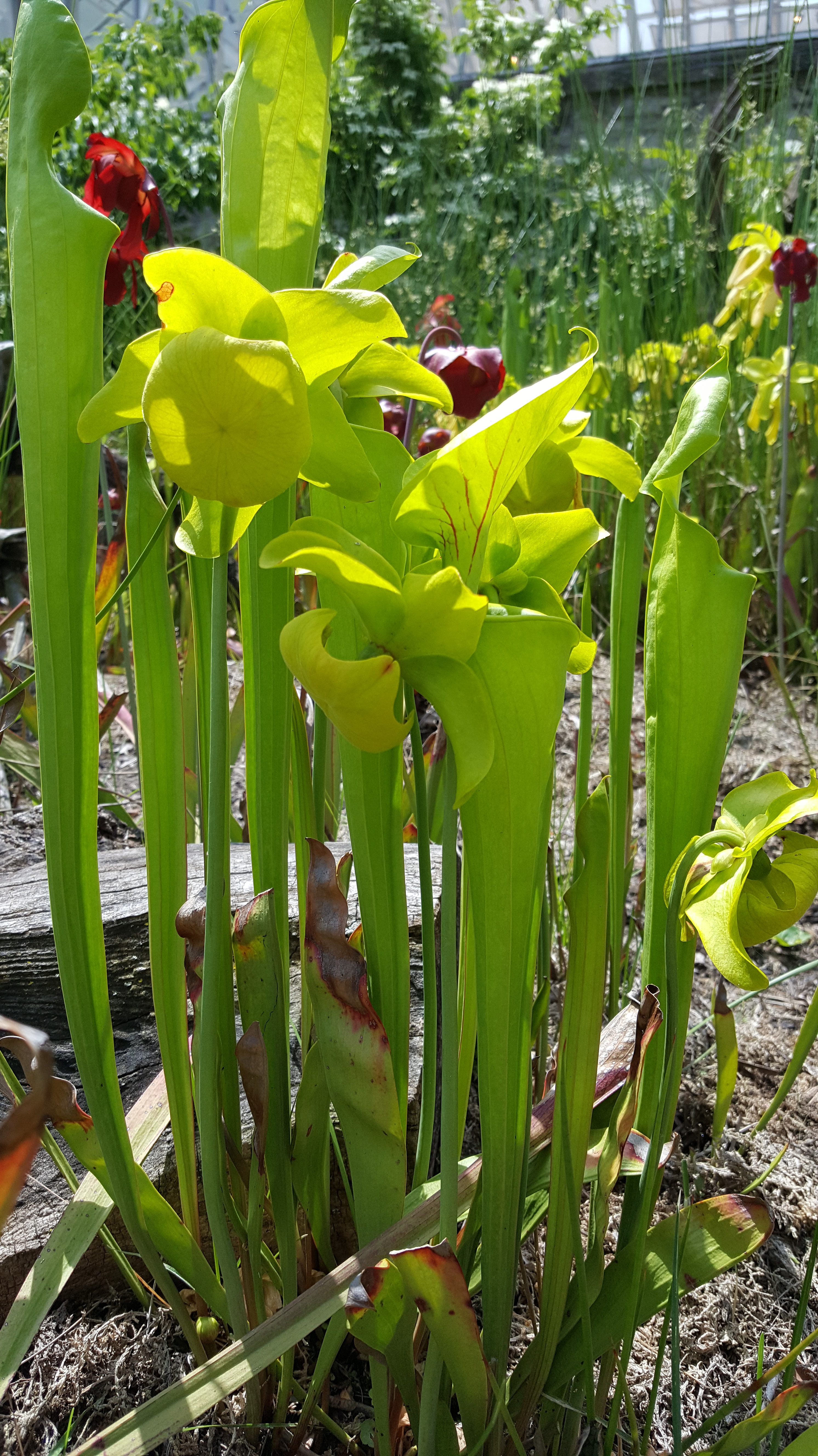
by GardenLover | Nov 10, 2015 | Garden profile, Misc., Special Topic
 Six Timeless Quotes To Inspire Fresh Garden Ideas
Six Timeless Quotes To Inspire Fresh Garden Ideas
By Teresa Woodard
As gardeners reflect on the past season and plan for the next, I thought I’d share these inspiring quotes from painting master Pablo Picasso as they were restated in a recent story in Entrepreneur magazine.
- Bad artists copy. Good artists steal. Just as in the art world, no ideas in the gardening world are new. So, yes, I’ll be stealing lots of ideas — like elements of this massive border — from this summer’s round of garden tours.
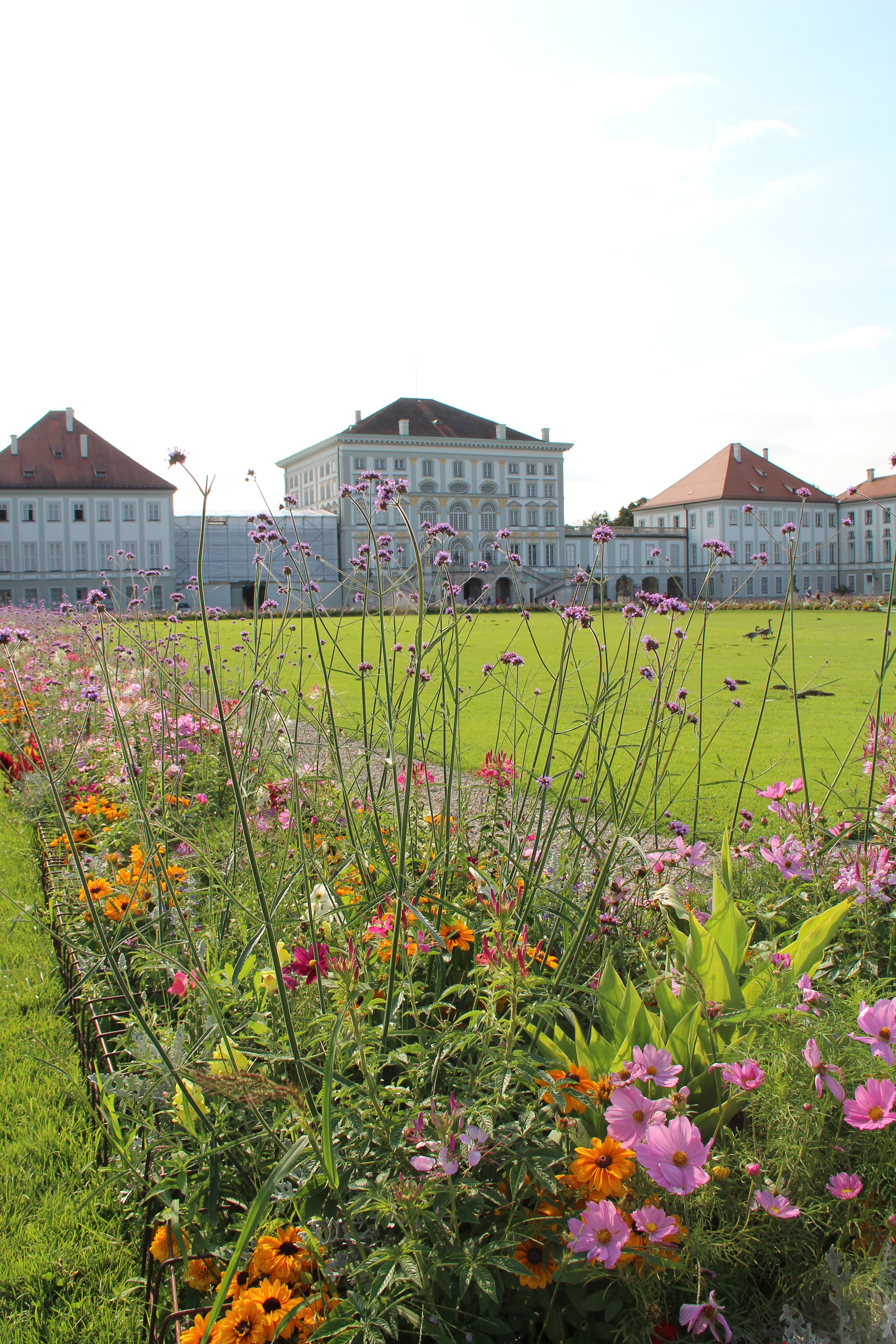
- Everything you can imagine is real. A few gardens I saw this year truly stretched my imagination. For example, King Ludwig’s underground garden grotto or the Bellagio Conservatory’s crane topiary may seem a bit surreal, but they do inspire big thinking.

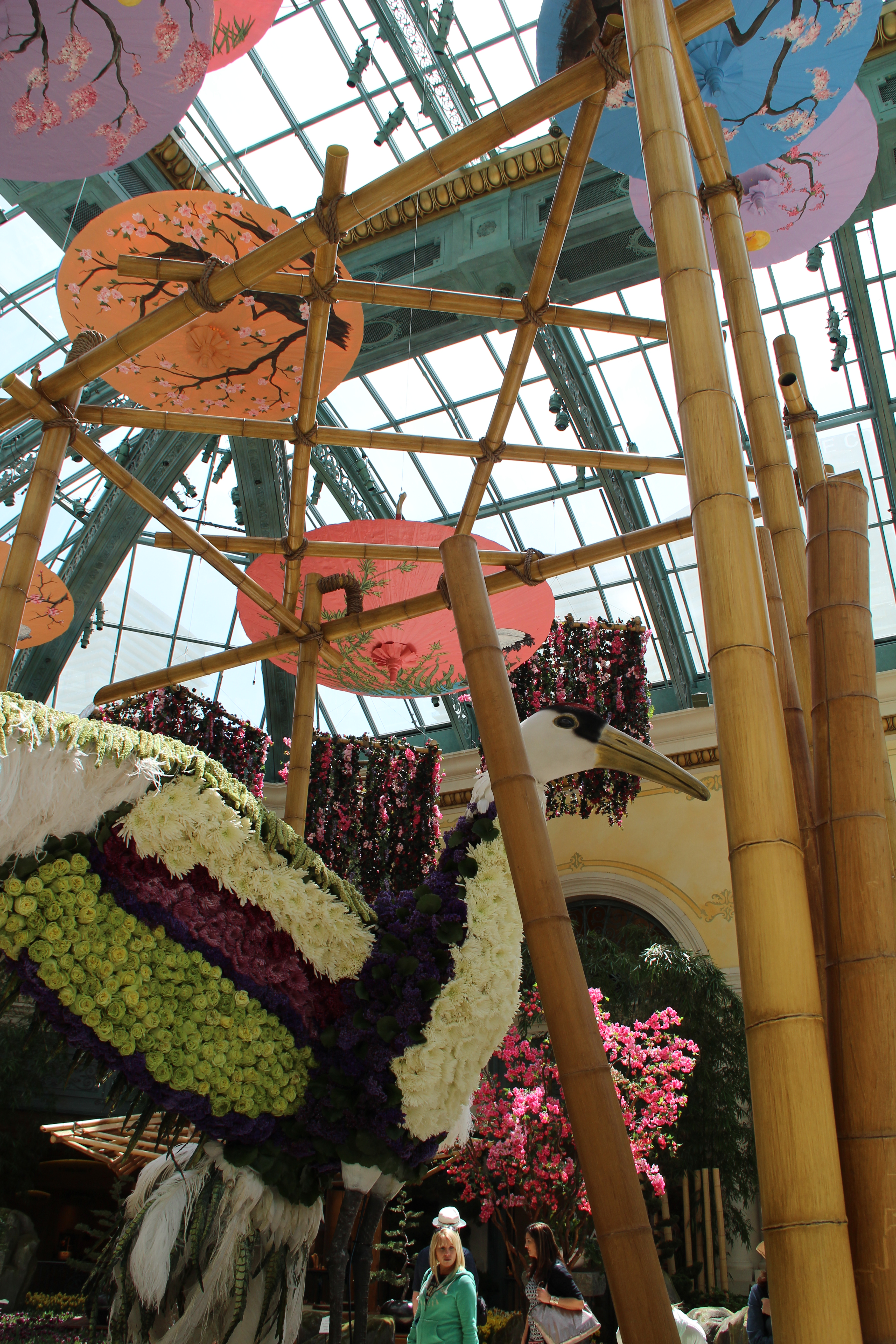 Art is the elimination of the unnecessary. As a garden writer, I tend to collect too many different plants which often creates a cluttered look in my garden. So, a goal for next season is to accumulate more of the most dazzling plants and donate those unnecessary ones to the Master Gardener Volunteers’ spring plant sale. One day, I’m envisioning rivers of plants like these Adrian Bloom designs
Art is the elimination of the unnecessary. As a garden writer, I tend to collect too many different plants which often creates a cluttered look in my garden. So, a goal for next season is to accumulate more of the most dazzling plants and donate those unnecessary ones to the Master Gardener Volunteers’ spring plant sale. One day, I’m envisioning rivers of plants like these Adrian Bloom designs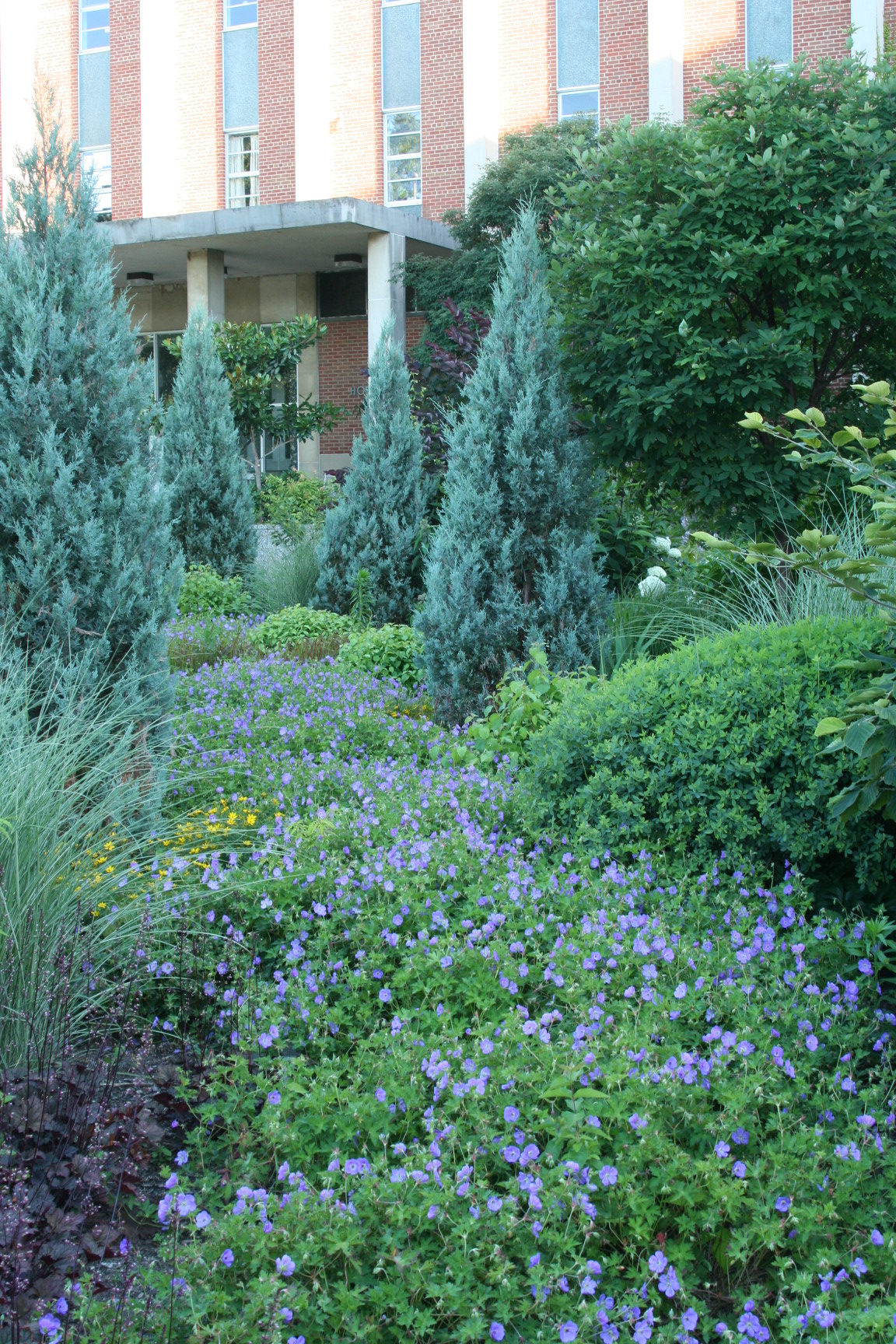
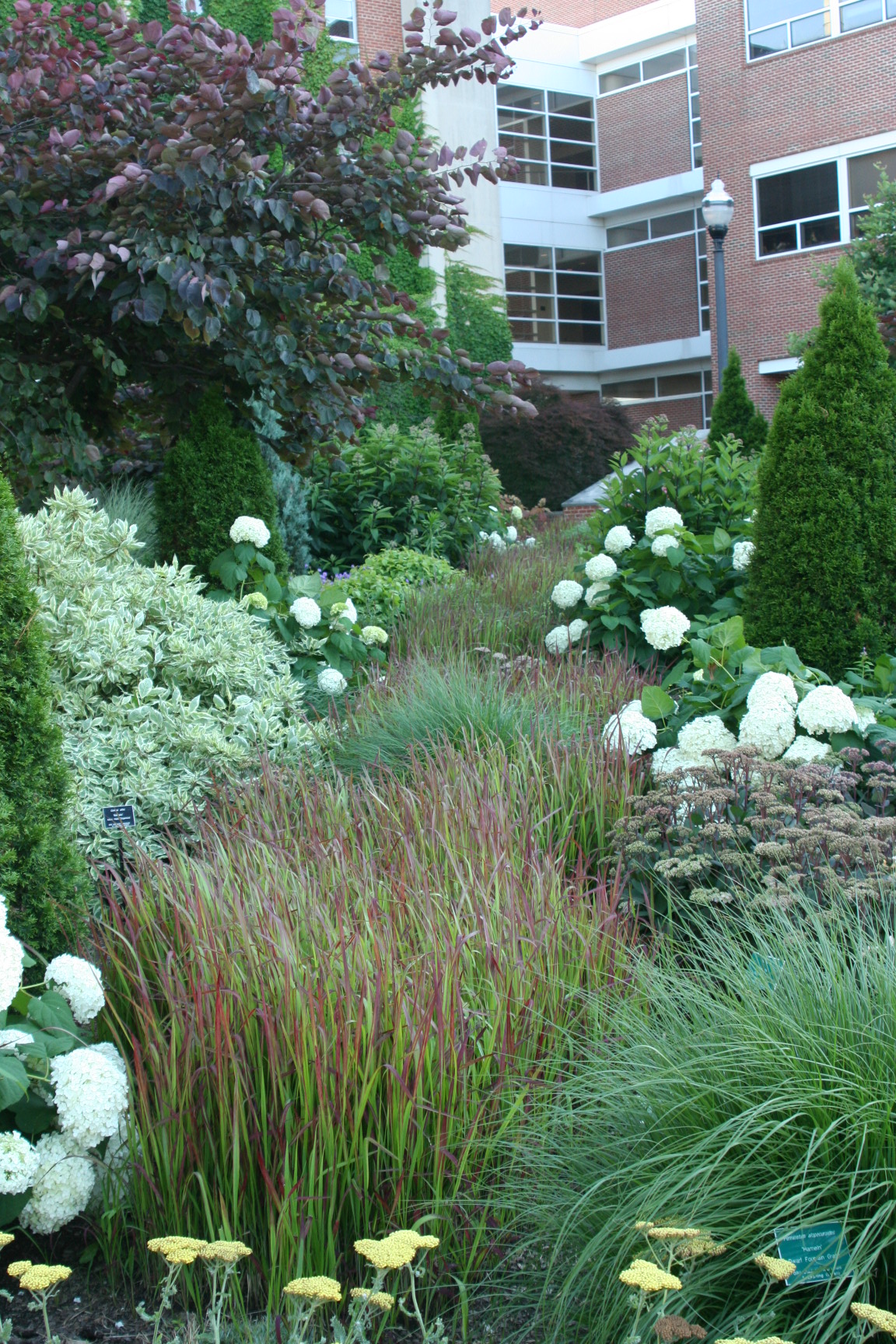 at Chadwick Arboretum.
at Chadwick Arboretum.- Action is the foundational key to all success. Can I hear an “Amen”? This truth undoubtedly applies to gardening and anything else in life. So, check back with me in a year, and see if I took action on the 10 new ideas in my journal to-do list.
 All children are artists. The problem is how to remain an artist once we grow up. I’m grateful to have teenagers and young neighbors to bring their youthful spirit to the garden. Thanks to them I planted peanuts, apple gourds, ghost peppers and crazy succulents. Some ghost peppers even ended up in the high school cafeteria and caused several dared friends to lose their lunch as they choked them down whole.
All children are artists. The problem is how to remain an artist once we grow up. I’m grateful to have teenagers and young neighbors to bring their youthful spirit to the garden. Thanks to them I planted peanuts, apple gourds, ghost peppers and crazy succulents. Some ghost peppers even ended up in the high school cafeteria and caused several dared friends to lose their lunch as they choked them down whole.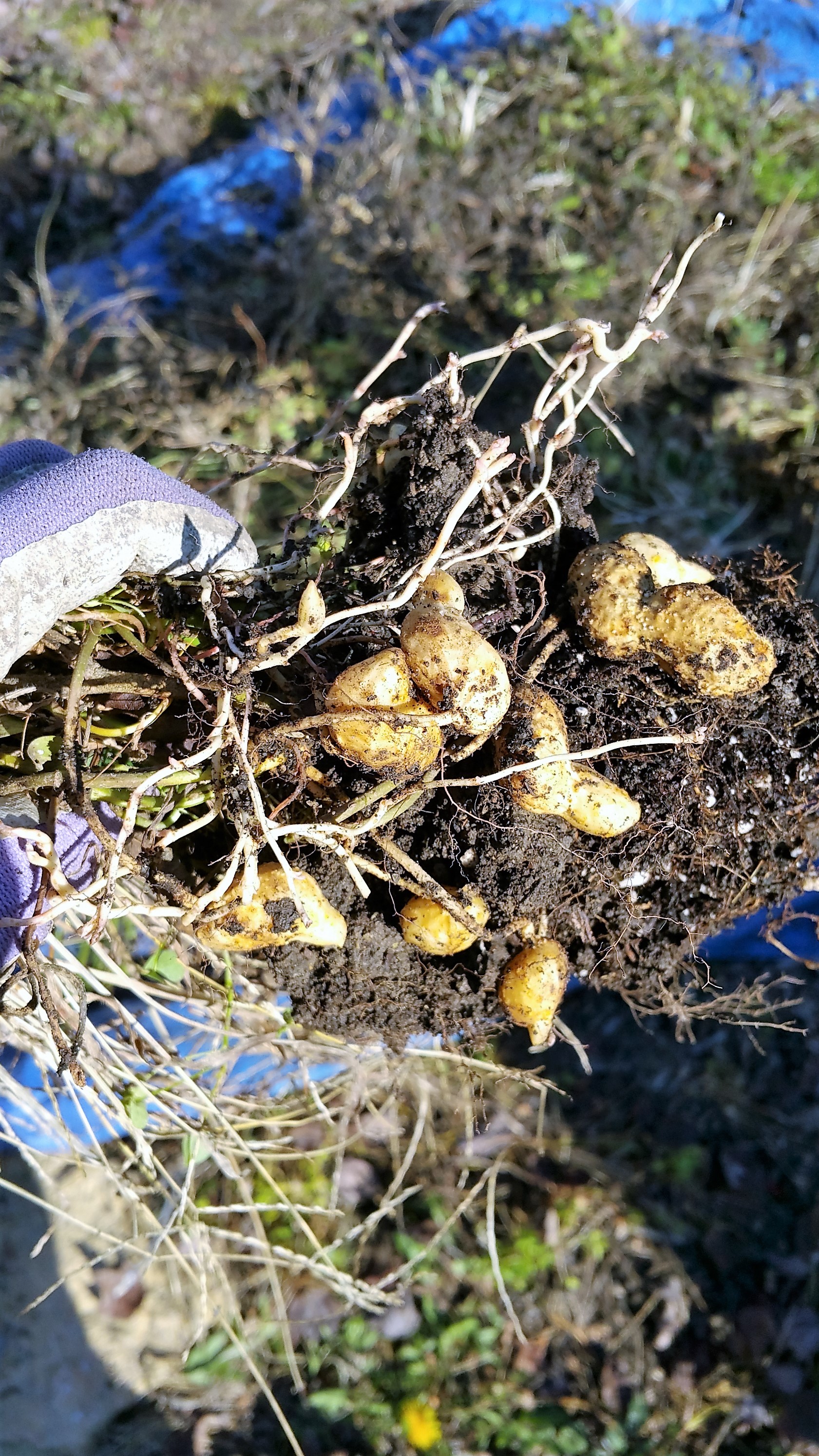 I paint objects as I think them, not as I see them. As I hack ideas from great garden designs, I can bend them to my own vision for my space, budget, growing zone and personal style. Here, I’ve planted hundreds — not thousands — of Spanish bluebells (Hyacinthoides hispanica) to achieve my own scaled-back version of this spectacular tulip display.
I paint objects as I think them, not as I see them. As I hack ideas from great garden designs, I can bend them to my own vision for my space, budget, growing zone and personal style. Here, I’ve planted hundreds — not thousands — of Spanish bluebells (Hyacinthoides hispanica) to achieve my own scaled-back version of this spectacular tulip display.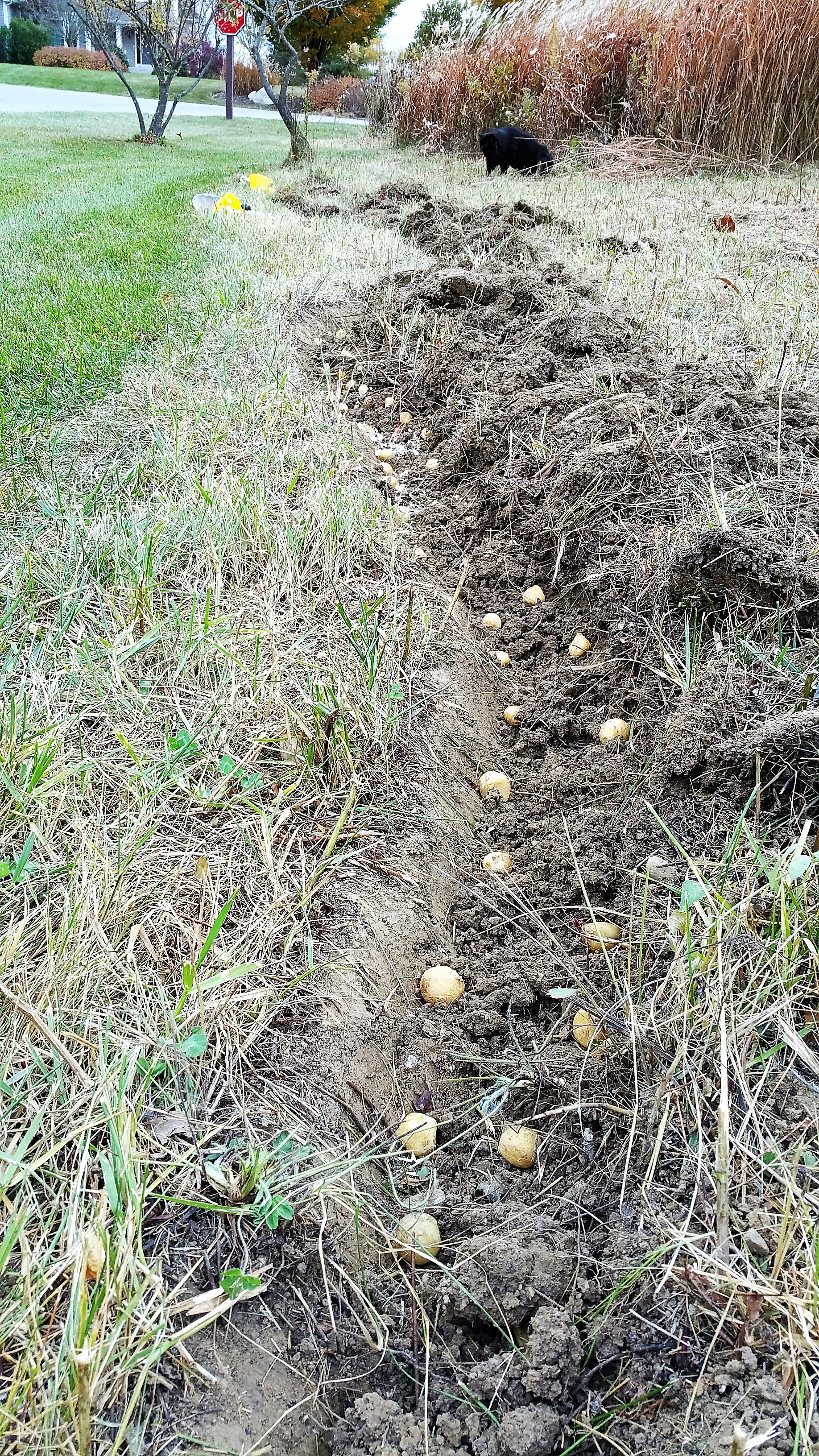
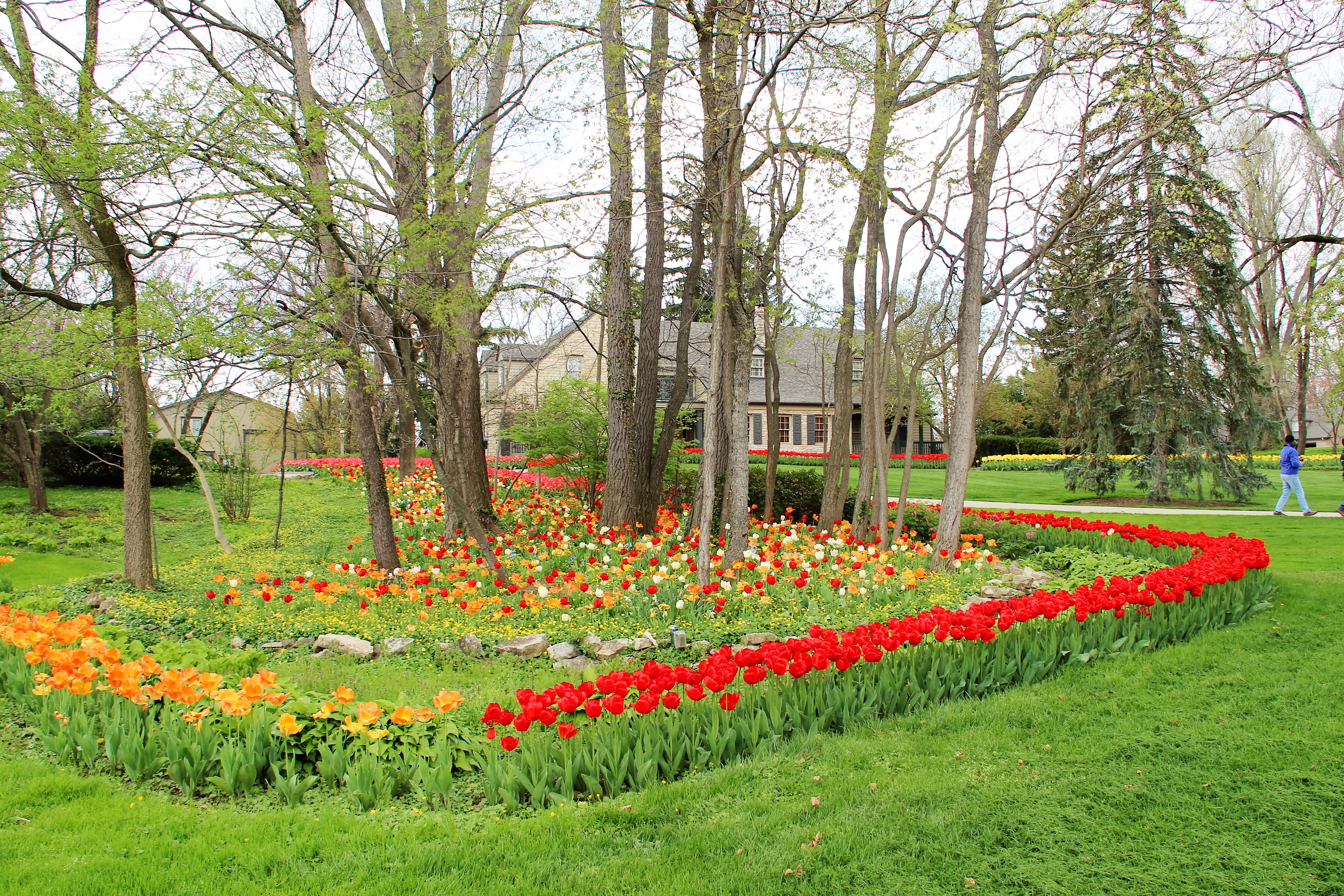
Check out the After Picasso: 80 Contemporary Artists at the Wexner Center for the Arts, through Dec. 27.
by GardenLover | Oct 9, 2015 | Garden profile, Snapshots, Special Topic
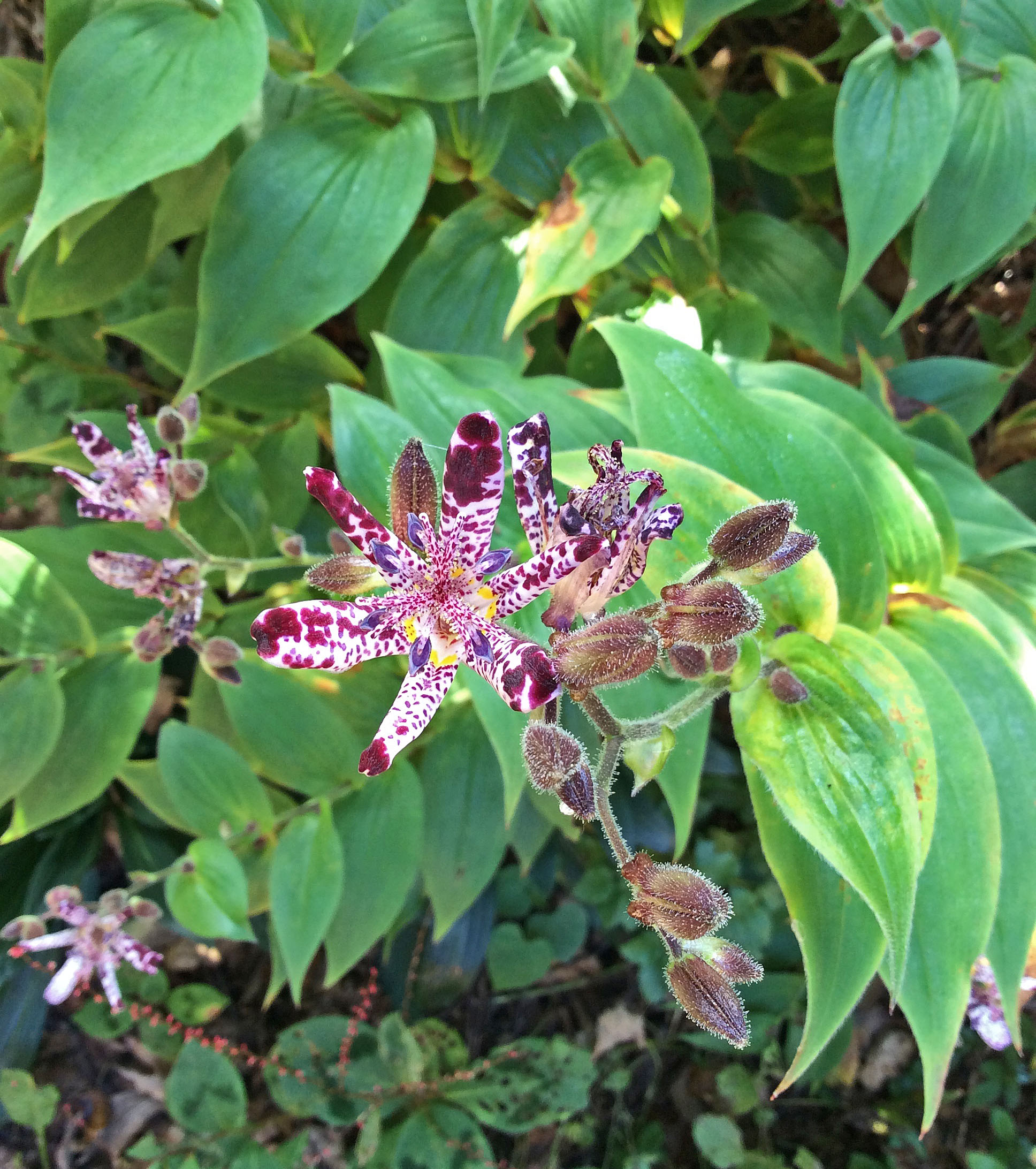 By Debra Knapke
By Debra Knapke
I’ve often heard the complaint that autumn is dull, and all we have is mums and pumpkins. Well, I recently went searching for jewels in my autumn garden and found not only jewels, but a plentiful array of flowers. Below is a glimpse of these treasures.
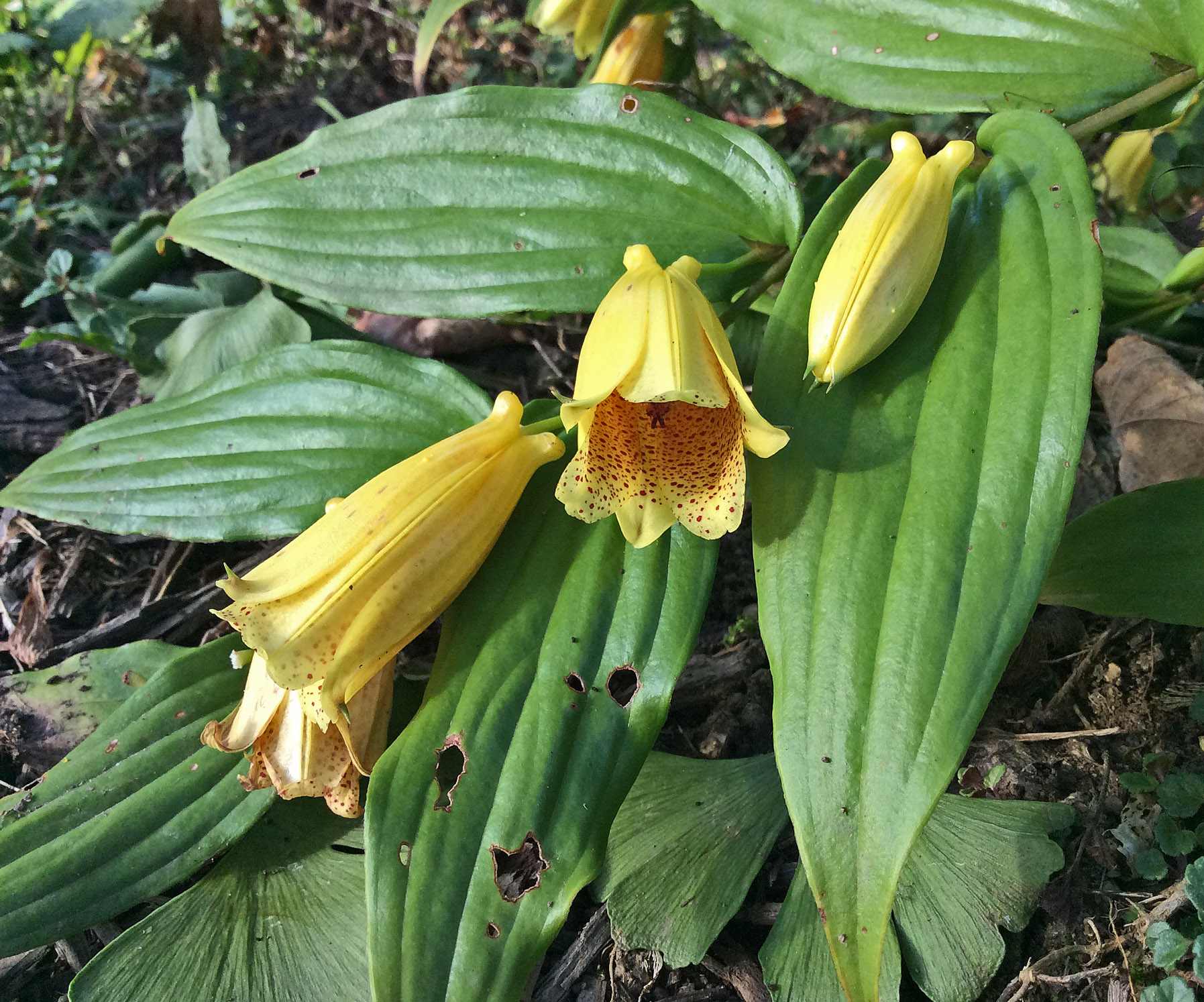
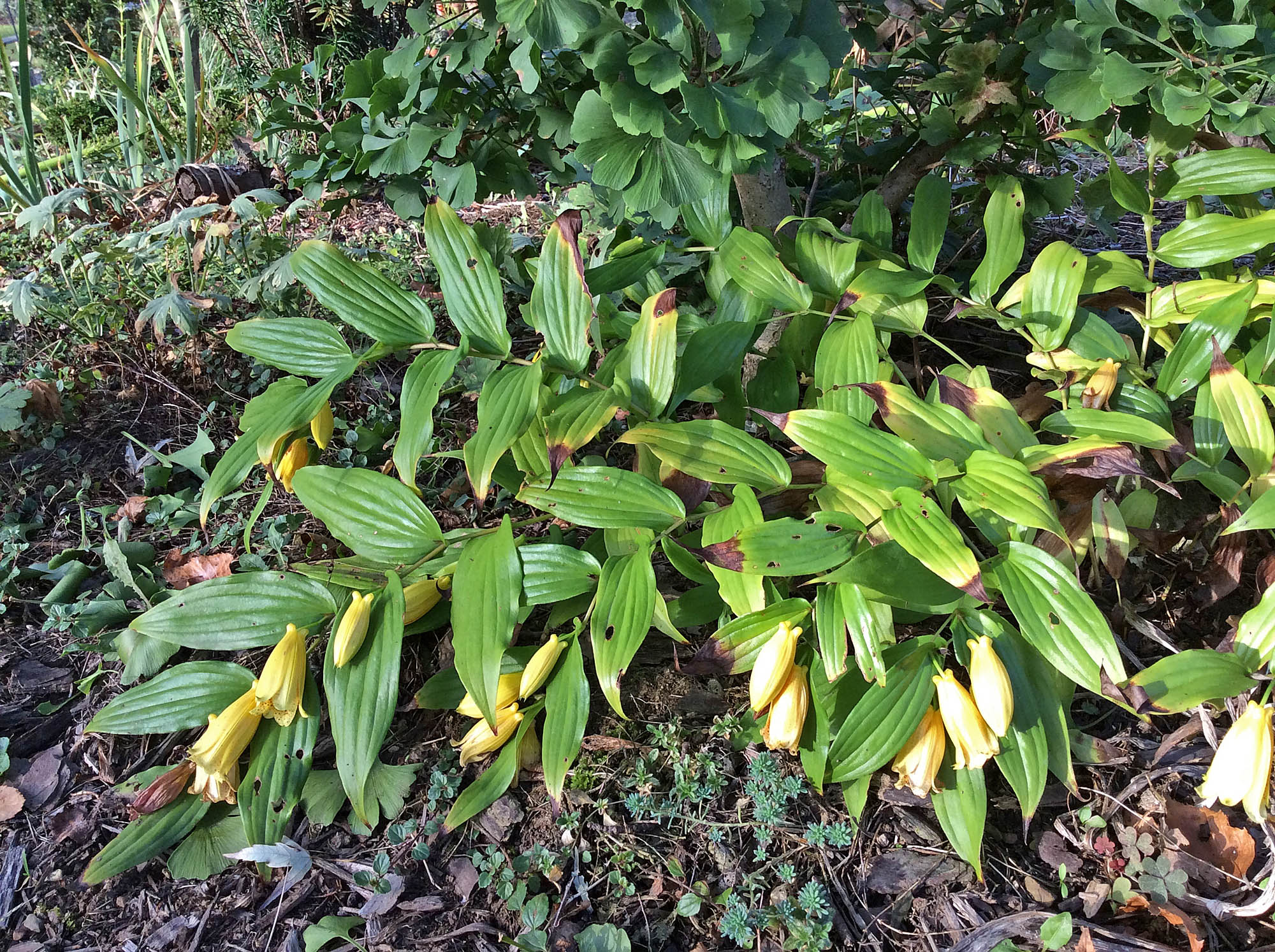 This weeping toadlily, Tricyrtus micrantha, is a rare jewel in a Central Ohio garden. In my garden since 2007, it has been a shy bloomer. But my patience was rewarded this year with this gorgeous display of 1 ½” golden bells.
This weeping toadlily, Tricyrtus micrantha, is a rare jewel in a Central Ohio garden. In my garden since 2007, it has been a shy bloomer. But my patience was rewarded this year with this gorgeous display of 1 ½” golden bells.
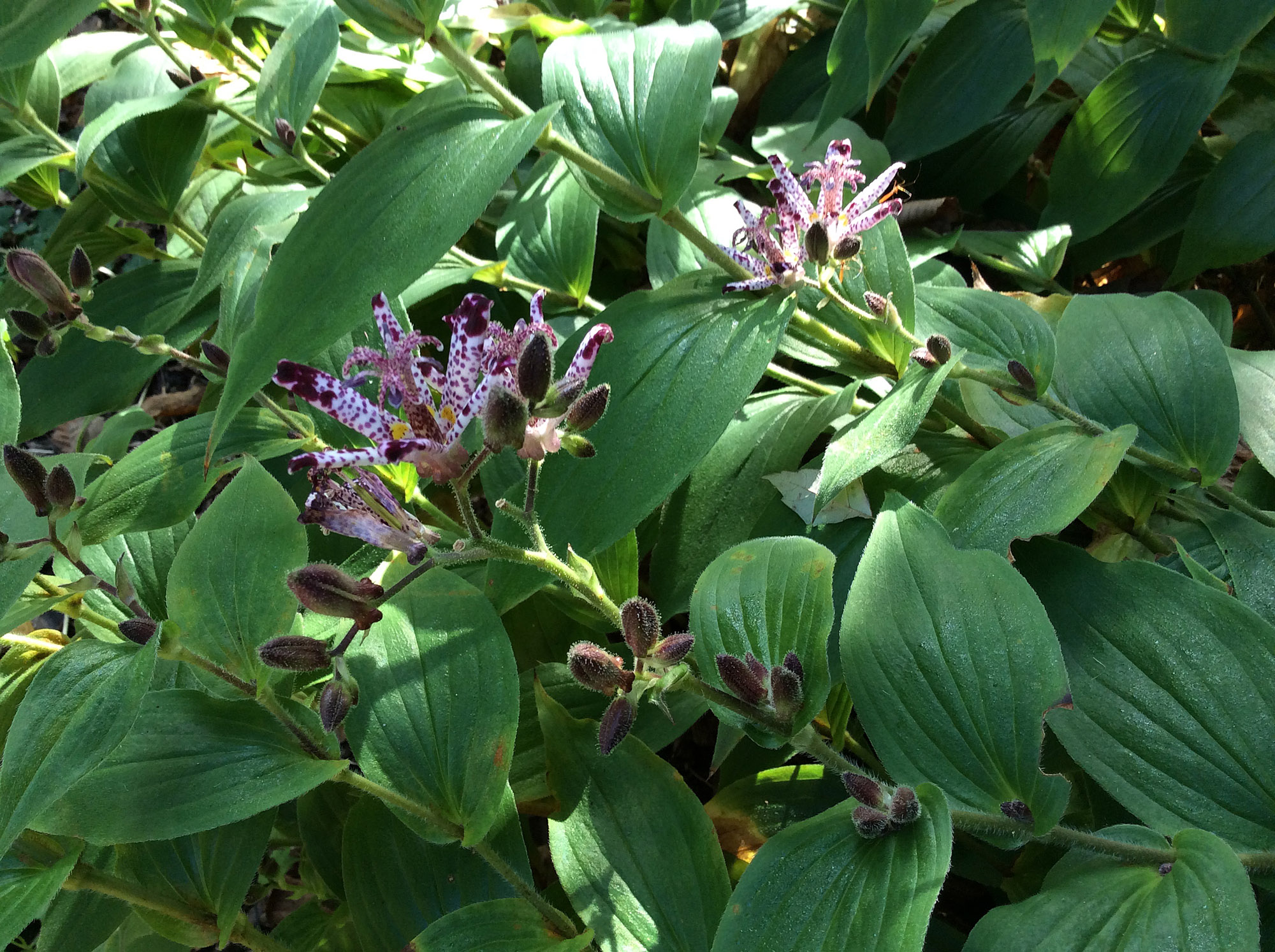 The more typical flower form of a toadlily is an open six-pointed star with six stamens (male reproductive structures) fused to a six-lobed pistil (female reproductive structure). If you look closely at the buds and stems you can see how Tricyrtis hirta became known as the hairy toadlily.
The more typical flower form of a toadlily is an open six-pointed star with six stamens (male reproductive structures) fused to a six-lobed pistil (female reproductive structure). If you look closely at the buds and stems you can see how Tricyrtis hirta became known as the hairy toadlily.
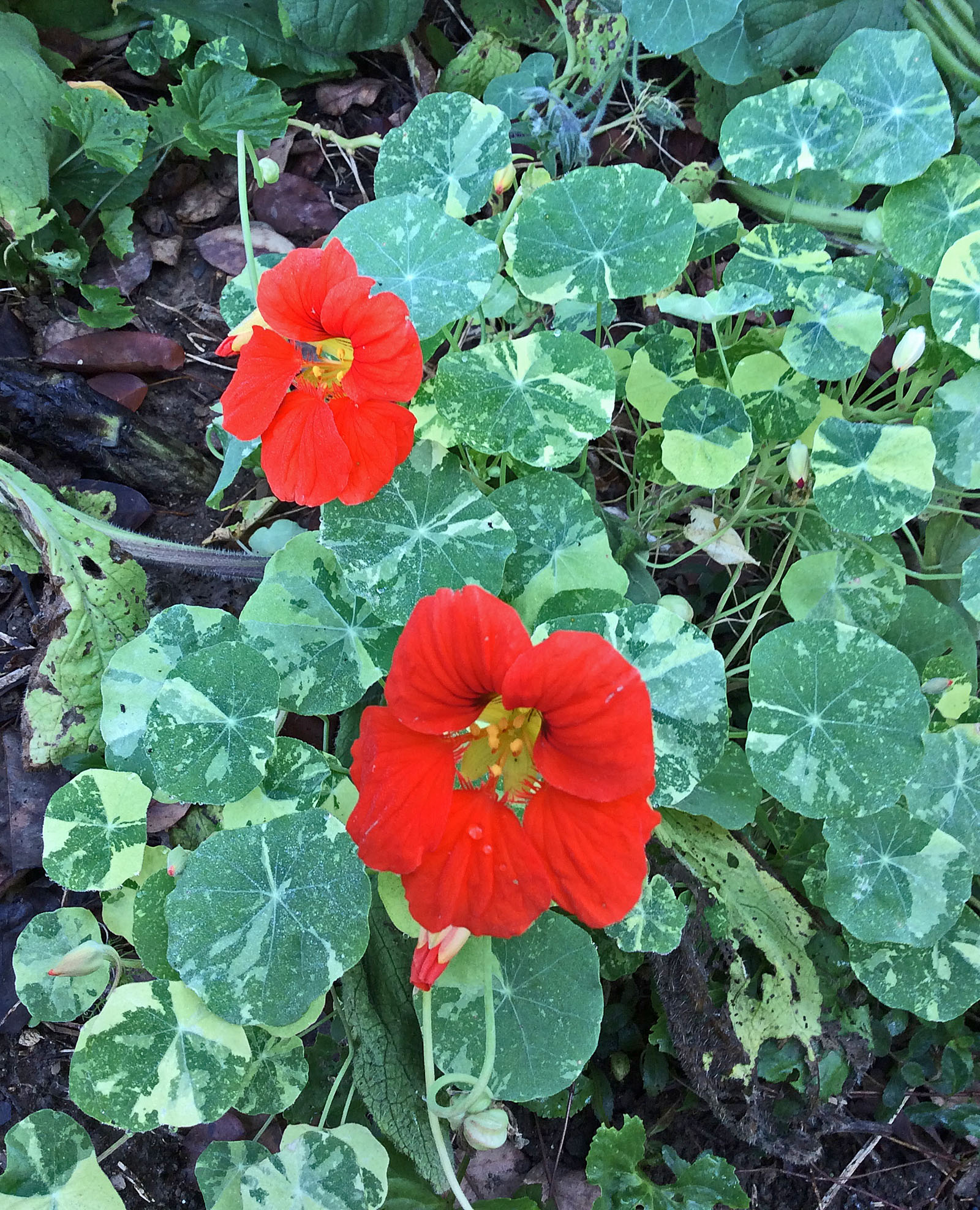
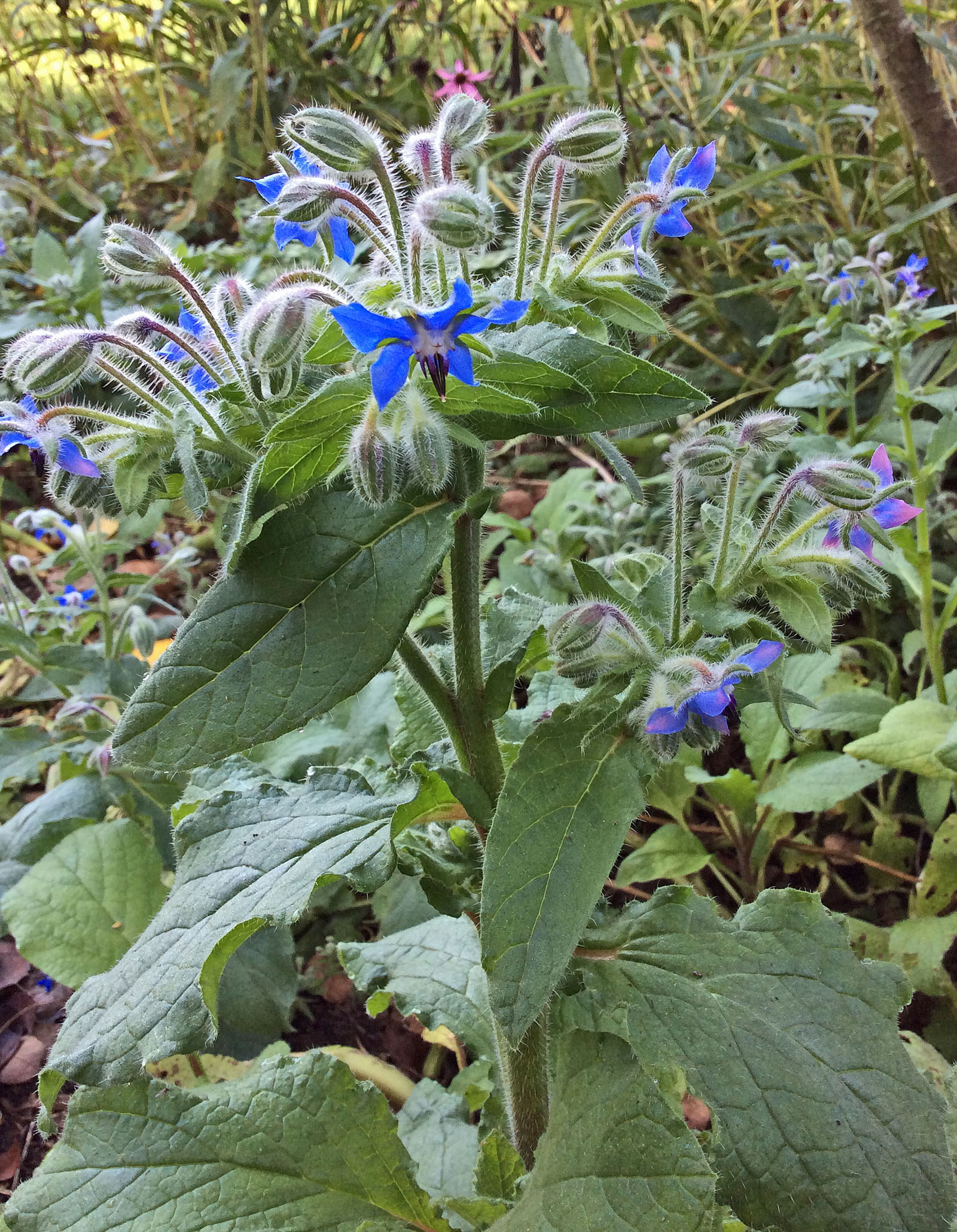 I do not have Michael’s zinnias, but this nasturtium (Tropaeolum majus ‘Alaska Mix’) offers a zing of orange which contrasts beautifully with its variegated leaves. An added bonus: the flower petals and leaves are edible. Borage (Borago officinalis) offers another edible flower; imagine a cool whisper of cucumber flavor. The blue flower is also a complimentary color to the orange nasturtium flower. I often plant them together as I find it to be a pleasing color combination.
I do not have Michael’s zinnias, but this nasturtium (Tropaeolum majus ‘Alaska Mix’) offers a zing of orange which contrasts beautifully with its variegated leaves. An added bonus: the flower petals and leaves are edible. Borage (Borago officinalis) offers another edible flower; imagine a cool whisper of cucumber flavor. The blue flower is also a complimentary color to the orange nasturtium flower. I often plant them together as I find it to be a pleasing color combination.
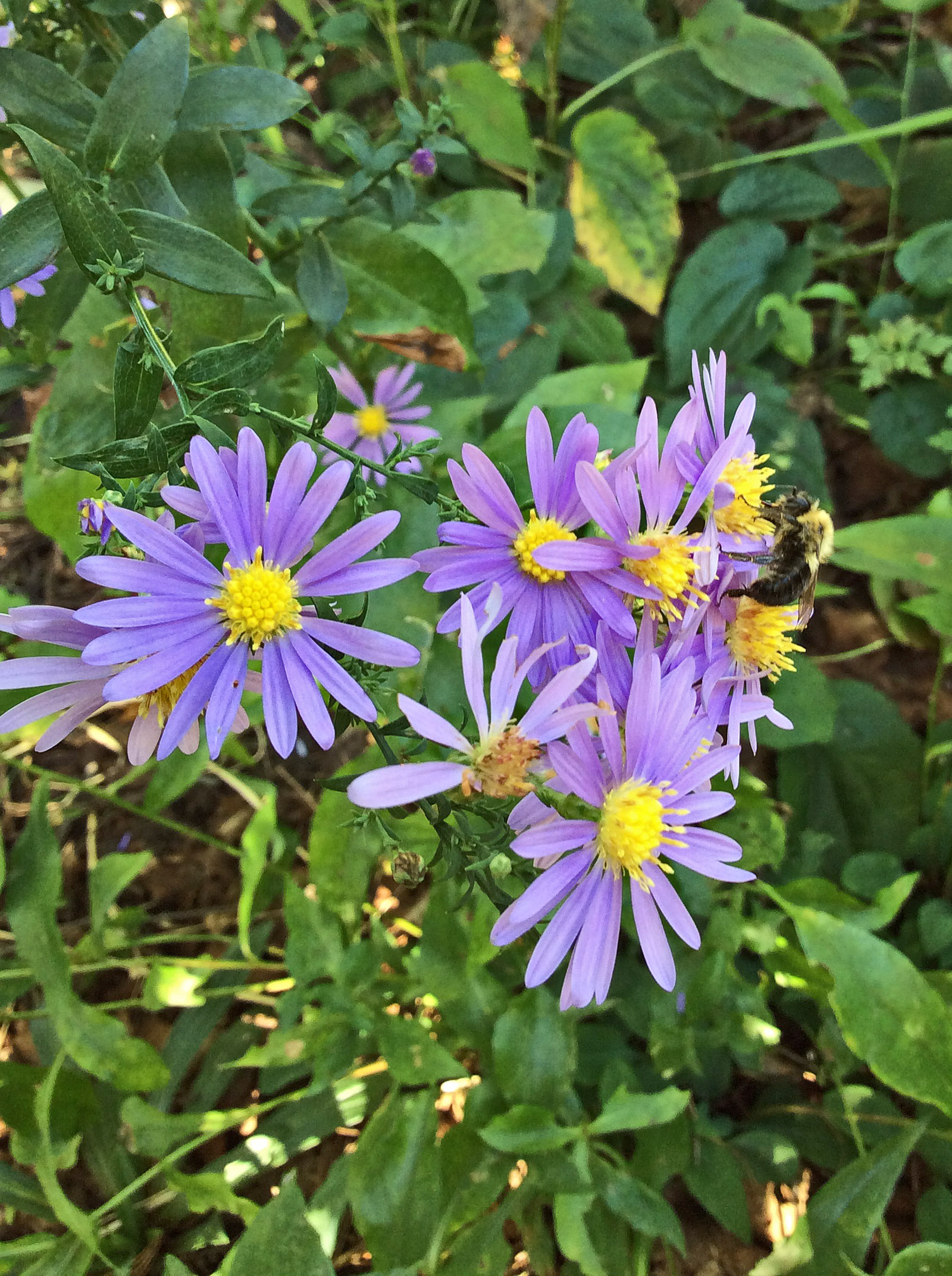 The smooth aster (Symphyotrichum laeve ‘Bluebird’) is one of many asters in my garden. Asters supply food to bees, butterflies and later, birds. Two asters I can’t show you, since they don’t bloom until late October. Perhaps, a last drink for pollinators?
The smooth aster (Symphyotrichum laeve ‘Bluebird’) is one of many asters in my garden. Asters supply food to bees, butterflies and later, birds. Two asters I can’t show you, since they don’t bloom until late October. Perhaps, a last drink for pollinators?
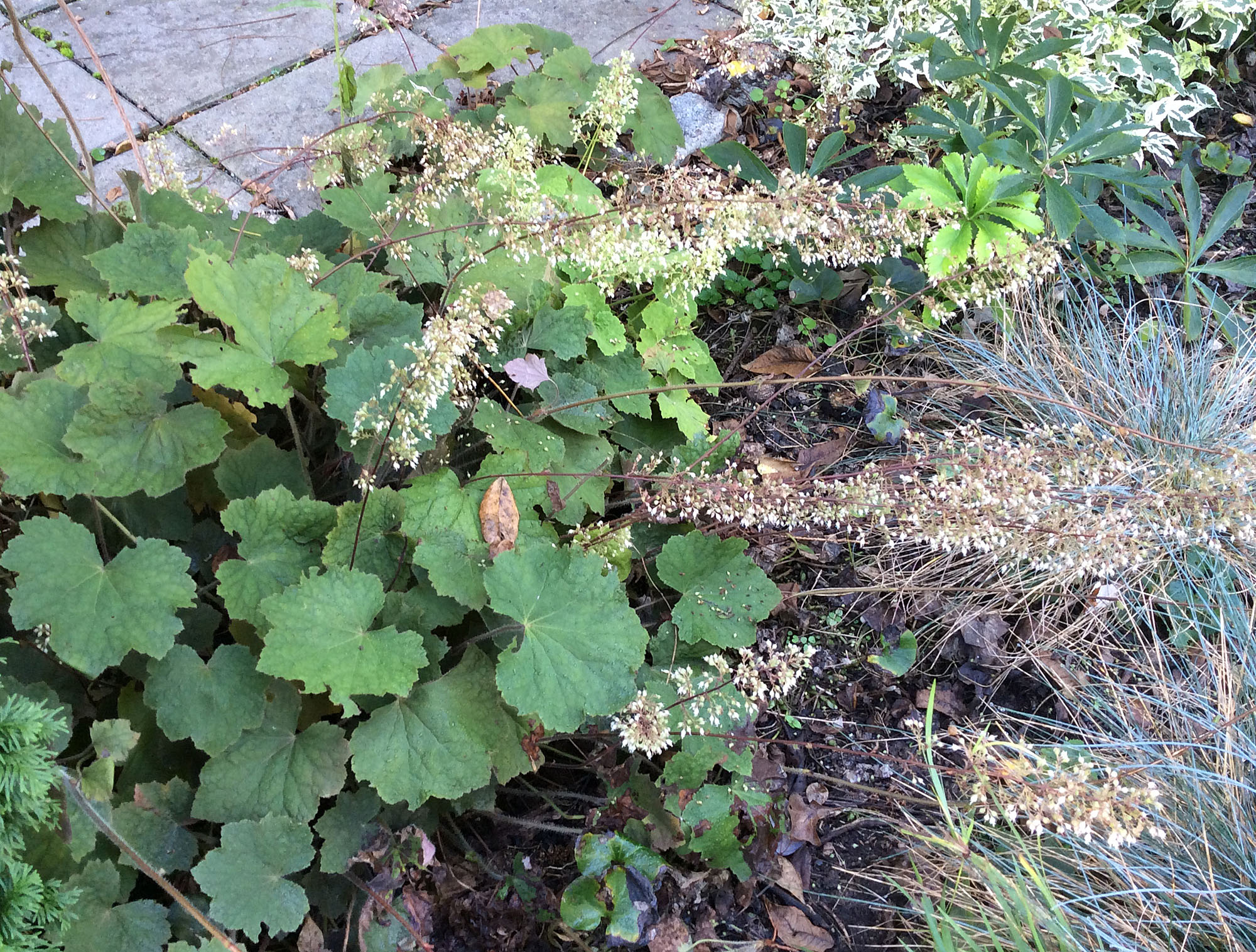 Our beautiful native Heuchera villosa and its cultivars (above is ‘Bronze Wave’) have become one of my favorite shade to part shade plants. Tolerant of dry shade once it is established, it offers a bold foliage effect and long-lasting flowers that bloom in August until frost. The inflorescences are so heavy that they gracefully bend and intermingle with other plants. Watch for hummers when heucheras are in bloom.
Our beautiful native Heuchera villosa and its cultivars (above is ‘Bronze Wave’) have become one of my favorite shade to part shade plants. Tolerant of dry shade once it is established, it offers a bold foliage effect and long-lasting flowers that bloom in August until frost. The inflorescences are so heavy that they gracefully bend and intermingle with other plants. Watch for hummers when heucheras are in bloom.
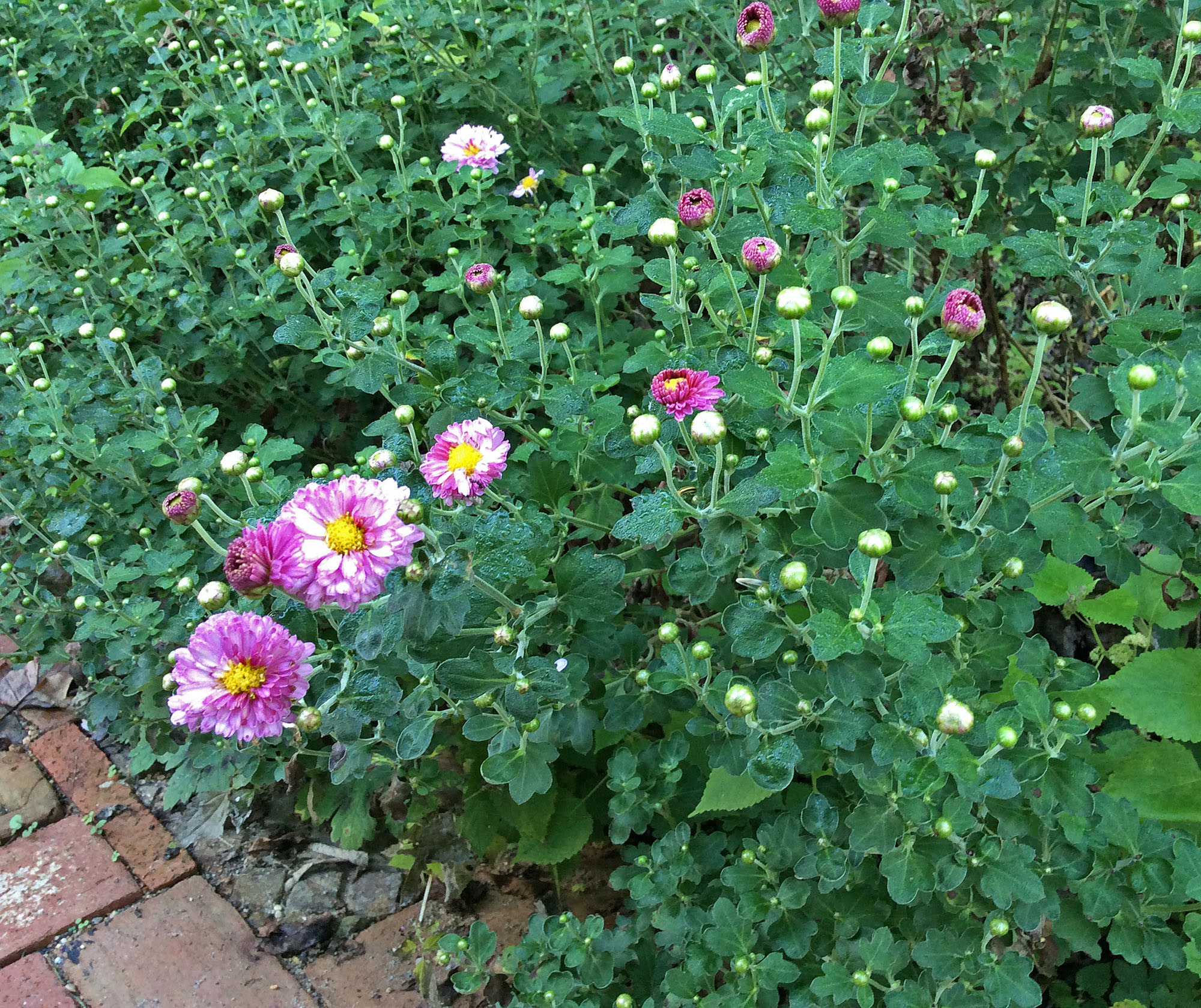 Last, but certainly not least, are the hardy mums. This is an old hybrid, Chrysanthemum ‘Mei Kyo’, which has graced my garden for 20 years. Its flowers are just starting to open. I will have flowers to bring inside until a hard frost sends this mum “to bed”.
Last, but certainly not least, are the hardy mums. This is an old hybrid, Chrysanthemum ‘Mei Kyo’, which has graced my garden for 20 years. Its flowers are just starting to open. I will have flowers to bring inside until a hard frost sends this mum “to bed”.
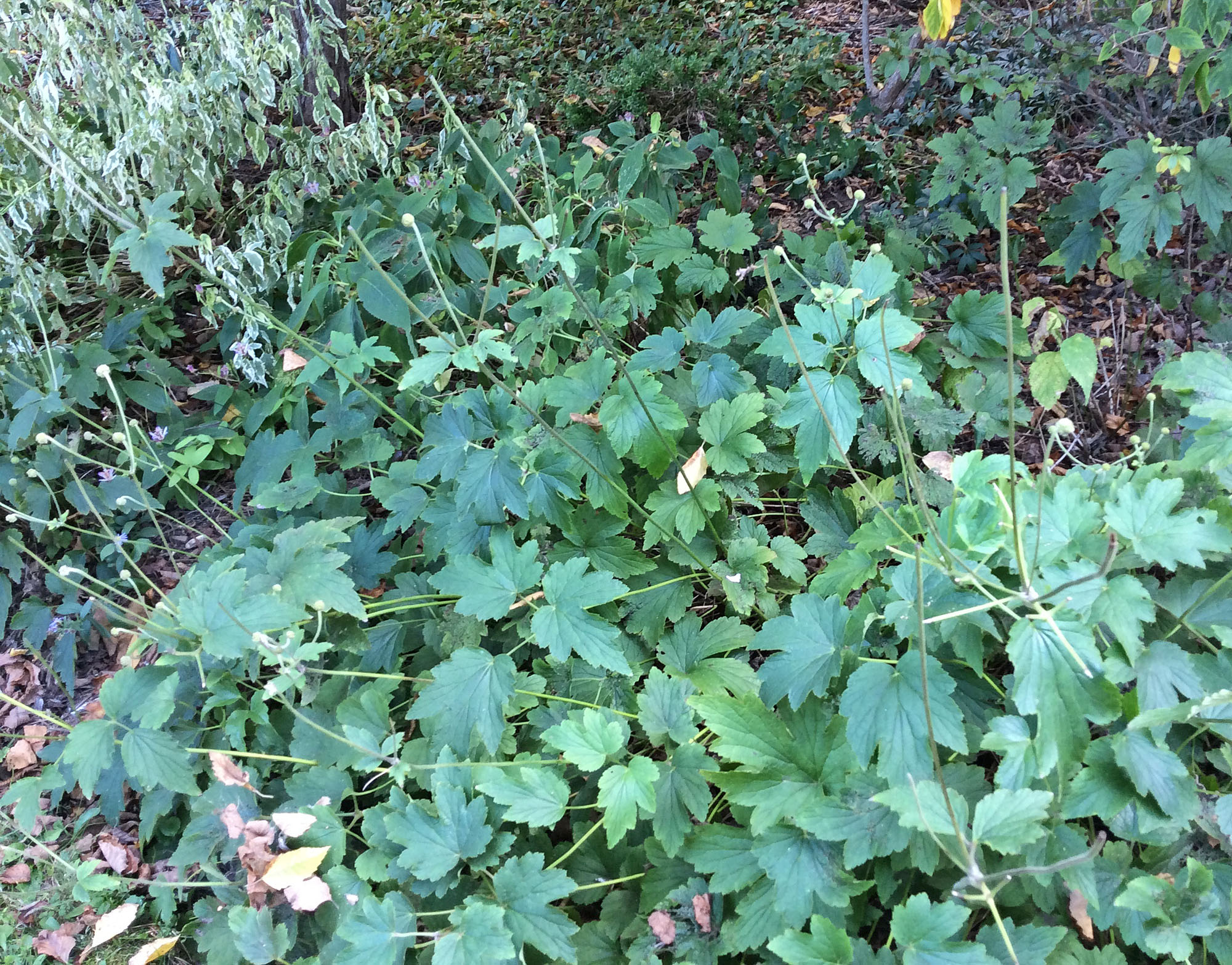 Where are the beautiful hybrid anemones that often grace an autumn garden? Well, in my garden the buds and flowers have become choice edibles for my herd of deer. I did not protect the flowers so I have beautiful leaves and naked stems adorned with a few seedheads of flowers that got away.
Where are the beautiful hybrid anemones that often grace an autumn garden? Well, in my garden the buds and flowers have become choice edibles for my herd of deer. I did not protect the flowers so I have beautiful leaves and naked stems adorned with a few seedheads of flowers that got away.
‘Wishing you a beautiful and creative fall!
by GardenLover | Oct 5, 2015 | Garden profile
Late Season Gifts from Nature
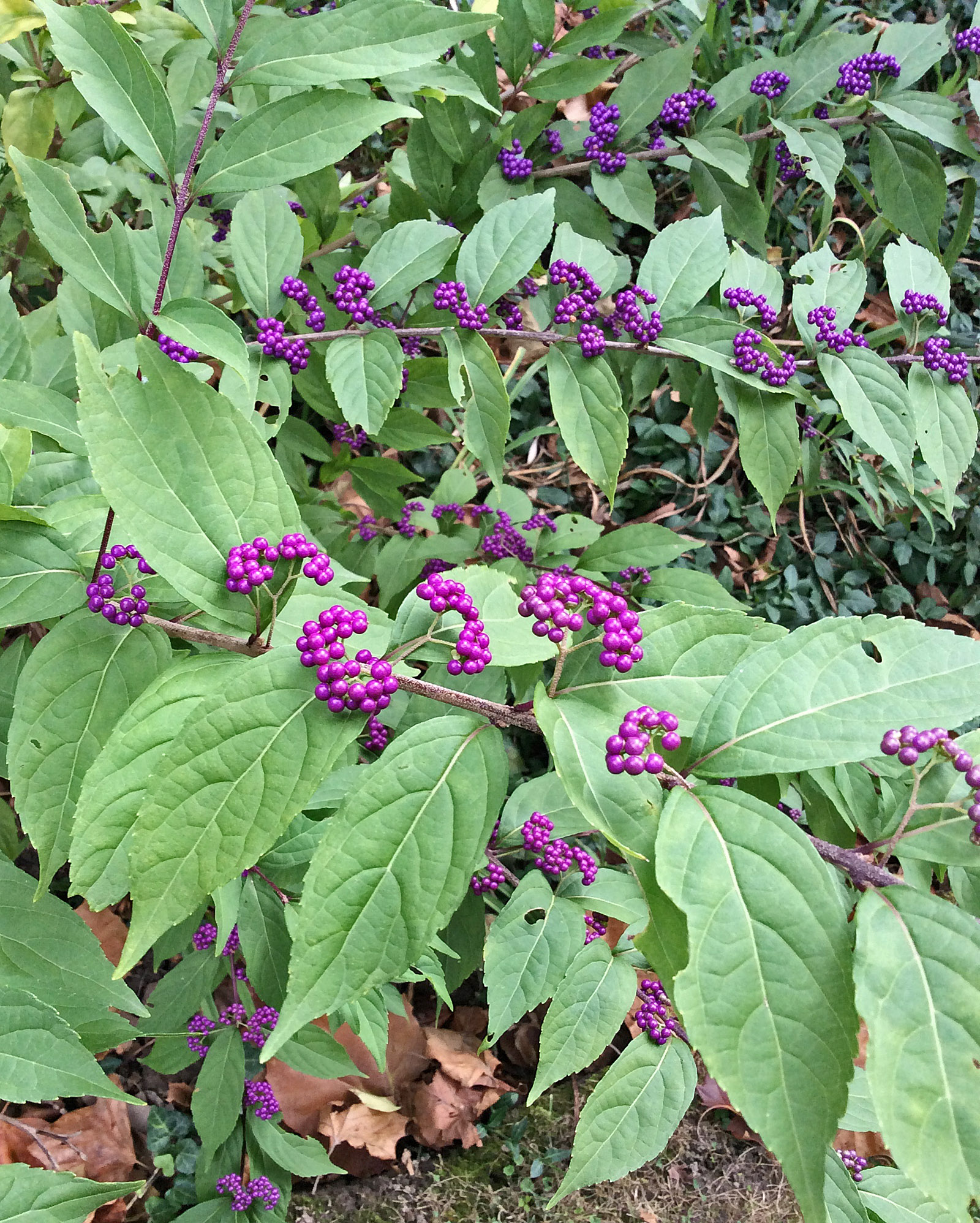 Debra Knapke
Debra Knapke
Teresa, Michael and I meet periodically to talk about the blog: its direction and ideas for posts. We always take a walk in the garden before we sit with our coffee (Michael and Teresa) and tea (me) and plan. This time I couldn’t resist taking quick pics of what I think of as “jewel-moments” in the garden. Yes, winter is coming, but fall is my favorite time of the year, and I revel in what the garden has to offer as it moves toward sleep.
Anyone who has seen beautyberry (Callicarpa americana) seldom forgets it. The bright purple fruit clusters truly look like jewels as they float above the branches.
Michael’s has several crabapples (Malus) in his garden. Here are two that not only offer a visual treat, but feed the birds as well. Professor Sprenger crabapple (left) is covered in orange-red fruits. Candied Apple (right) crabapple has a weeping form. The branches of glossy red fruits are suspended between other plants. Imagine beautiful streamers of soft pink to white flowers in the spring.
I have always loved the seedheads of Queen Anne’s lace (Daucus carota). Here goldenrod (Solidago canadensis) provides a lovely contrasting background. I have recreated this combination in my home for fall arrangements. Add some purple asters and the effect is stunning.
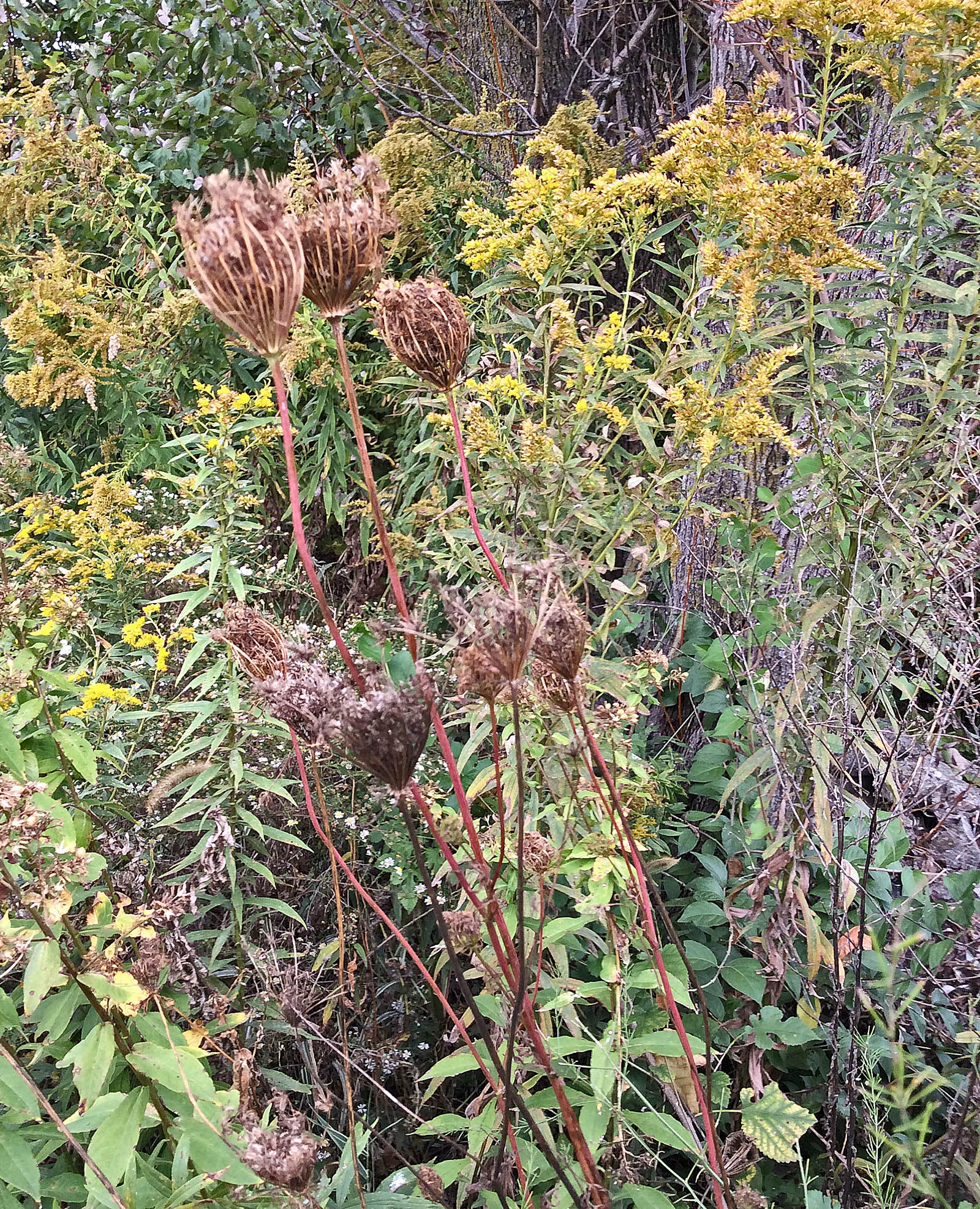
Northern sea oats (Chasmanthium latifolium) is a native grass that loves to self-seed all over the garden. It, too, is a good addition to fall arrangements. Be forewarned: they are short-lived in dried arrangements as the “oats” shatter in 2-4 weeks when in a warm home.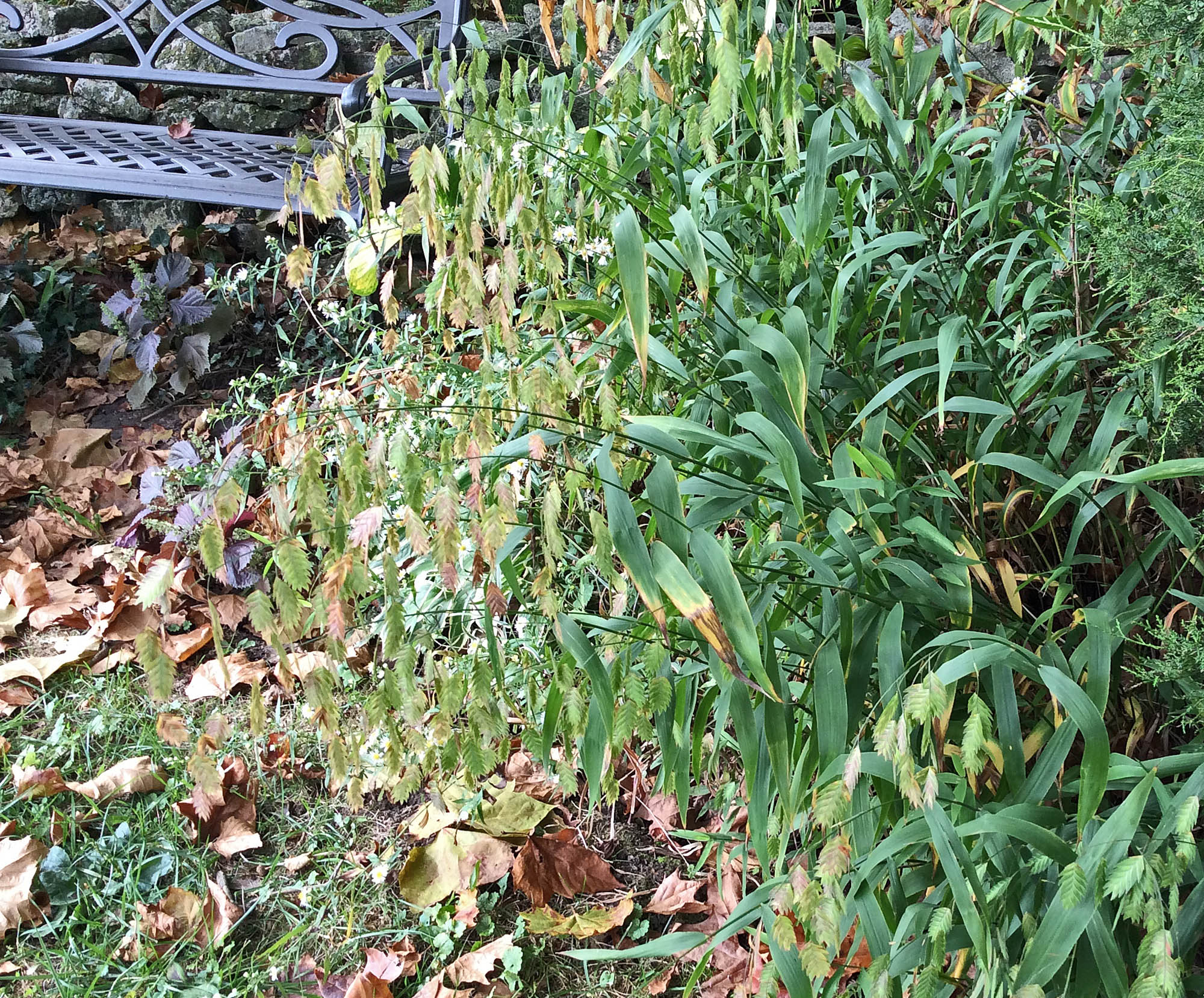
This heirloom seed strain zinnia is a jewel left over from summer. This week’s cold spell may end their reign in the garden. As a native of Mexico, zinnias quickly decline when temperatures go below 40°F.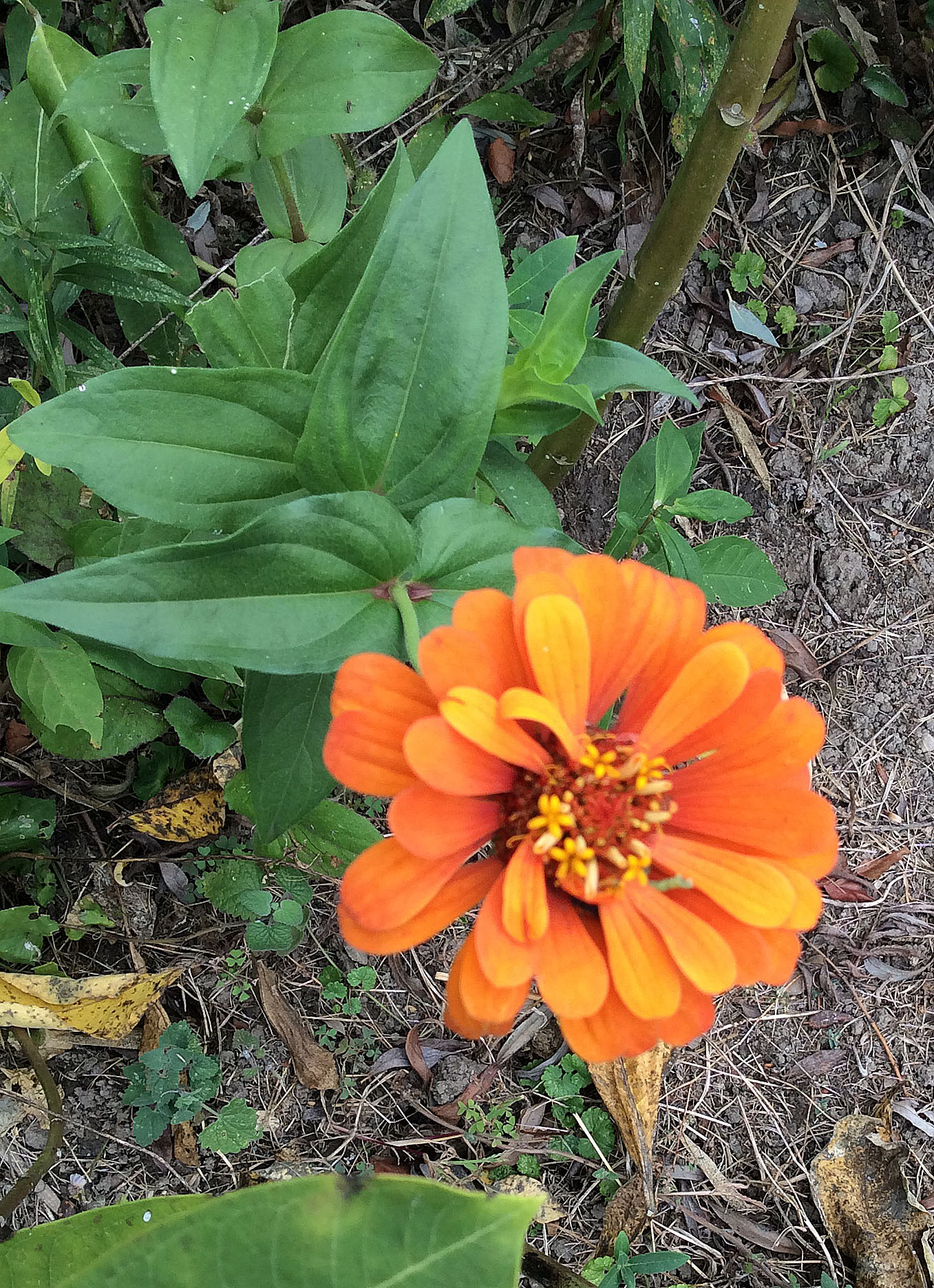
Brown is a beautiful color when contrasted with the sagey-green leaves of false blue indigo (Baptisia australis). The seedpods develop in July and persist into mid-fall. An added bonus: they softly rattle on windy days and add an auditory experience to a garden. Cherry tomatoes are another last jewel of the summer. The cooler temperatures have already slowed fruit maturation and tomato flowers are only a memory.
My blogmates discussing how Michael’s garden is senescing and what may change for next year’s garden. As autumn develops and I watch my own garden, I hear the echo of the famous line from Gone with the Wind: “Tomorrow is another day.”

by GardenLover | Jul 21, 2015 | Garden profile
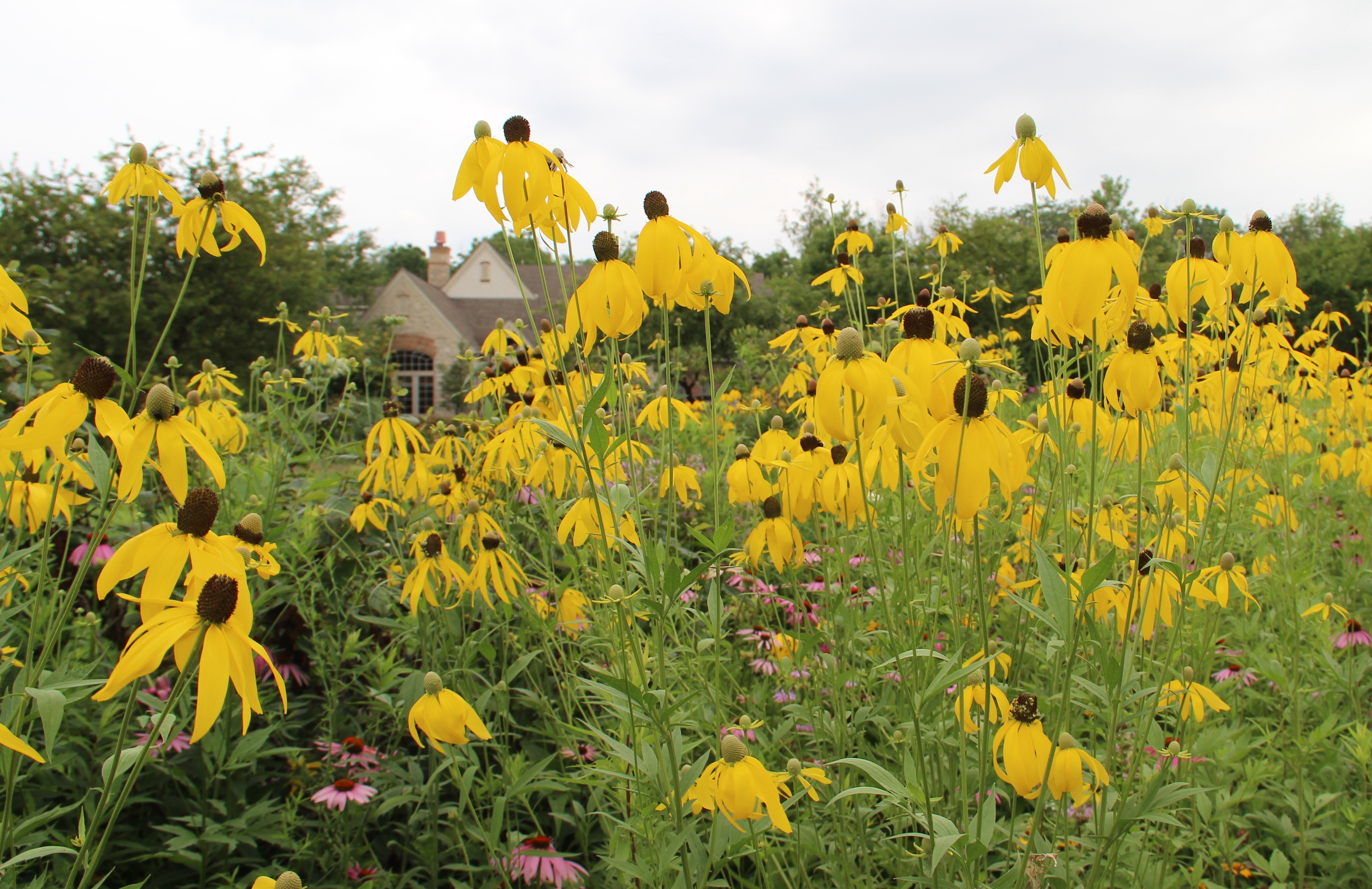 By Debra Knapke
By Debra Knapke
In between light rain showers Michael and I visited Teresa’s garden. Nestled in a conservation area along the scenic Little Darby Creek, Teresa created a haven for wildlife and for herself and her family. Her design is a continuum: formal elements by the house; semi-formal beds further out, culminating in prairie areas by the road. Her gardens reflect not only the natural areas that were along the Little Darby before humans settled here, but also of the food and cutting gardens that came after.
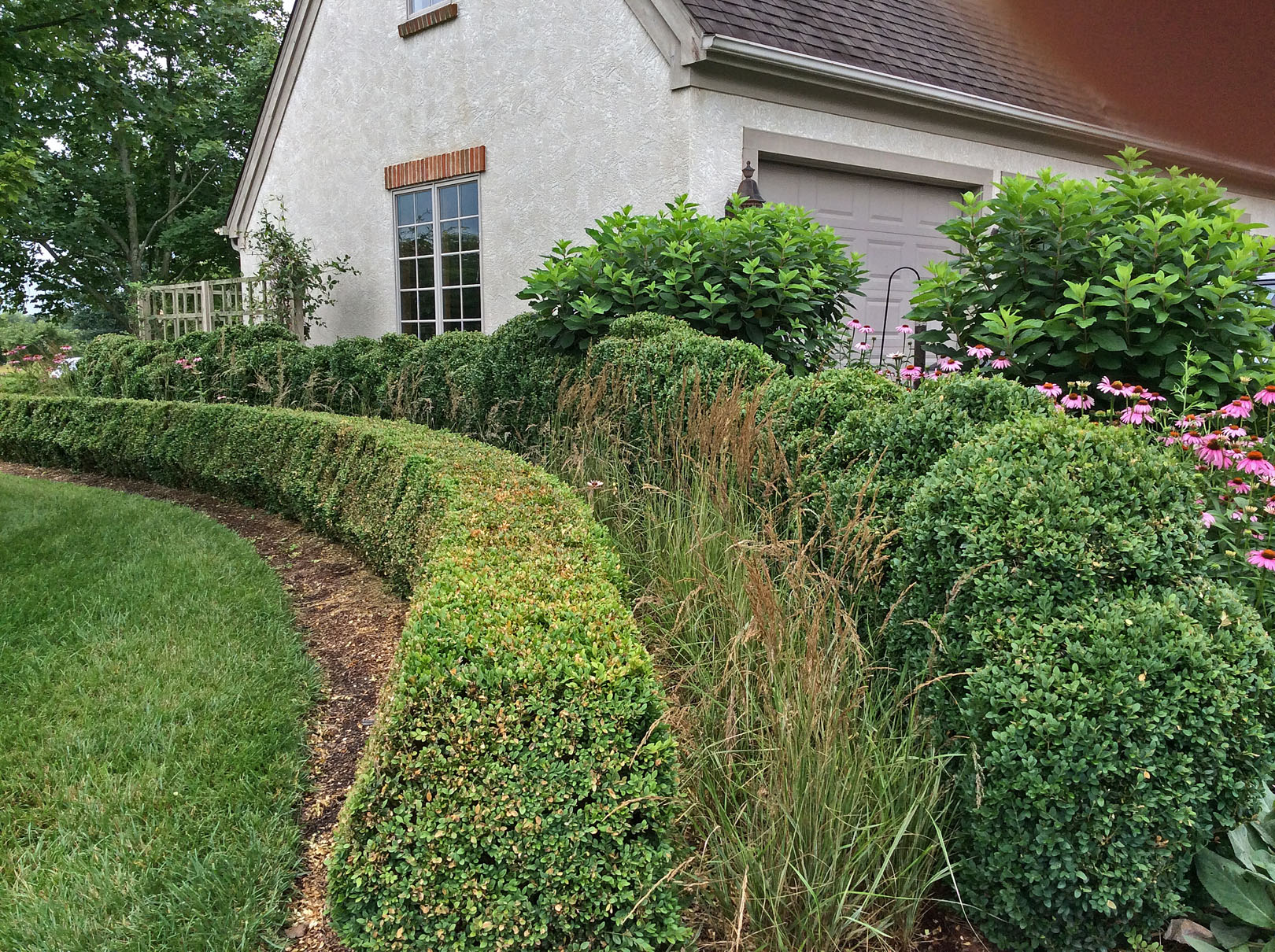
The Midwest is experiencing a record-setting amount of rain for June and July, so Teresa’s gardens are lush. The long prairie areas that line the road are full of bloom as we move into high summer color.
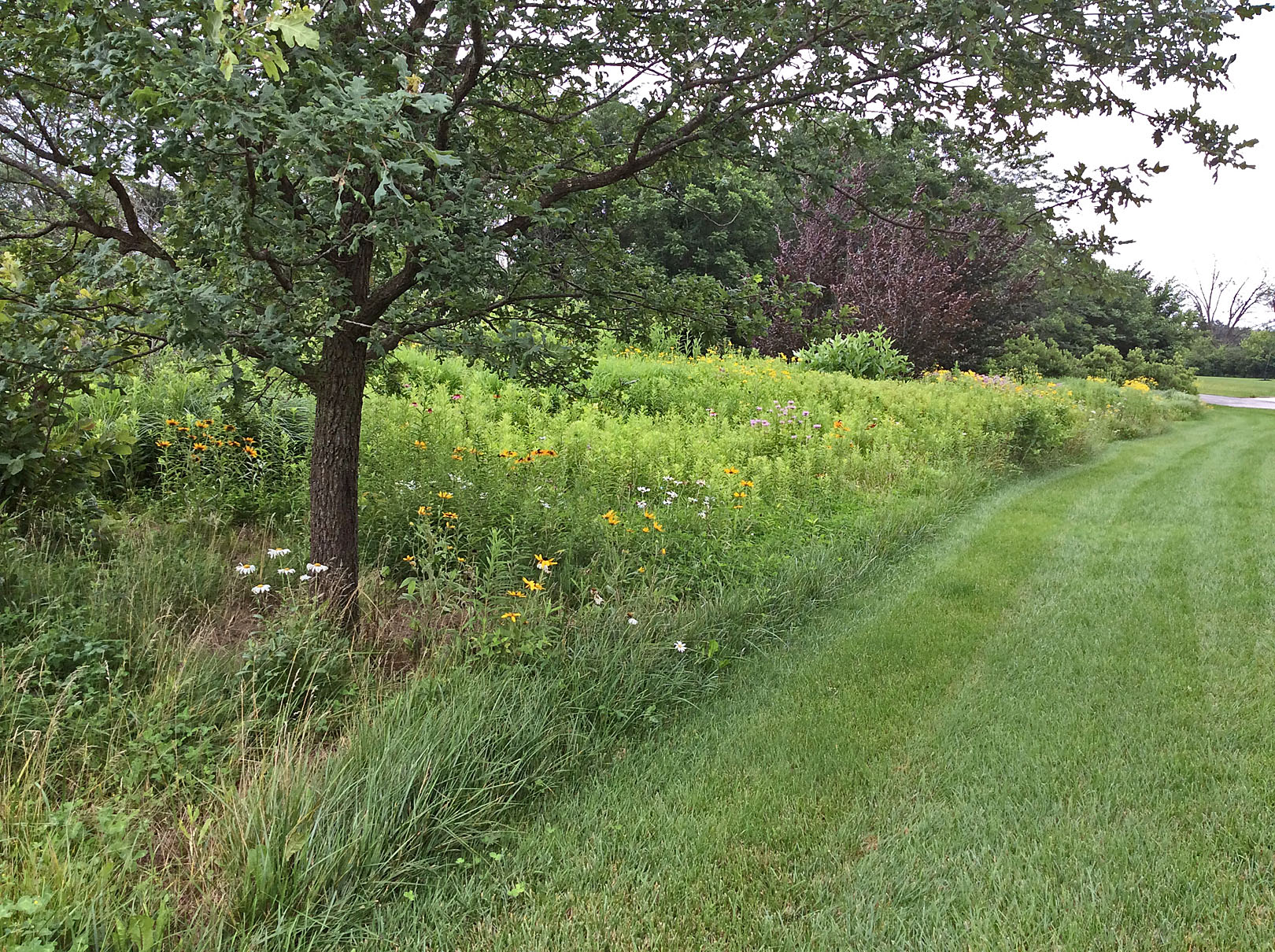 We are greeted at the front door by one of Teresa’s many colorful containers. Her gardens are lovely contrasts of textural foliage punctuated by well-placed blooming plants and artful placements of garden accents.
We are greeted at the front door by one of Teresa’s many colorful containers. Her gardens are lovely contrasts of textural foliage punctuated by well-placed blooming plants and artful placements of garden accents.
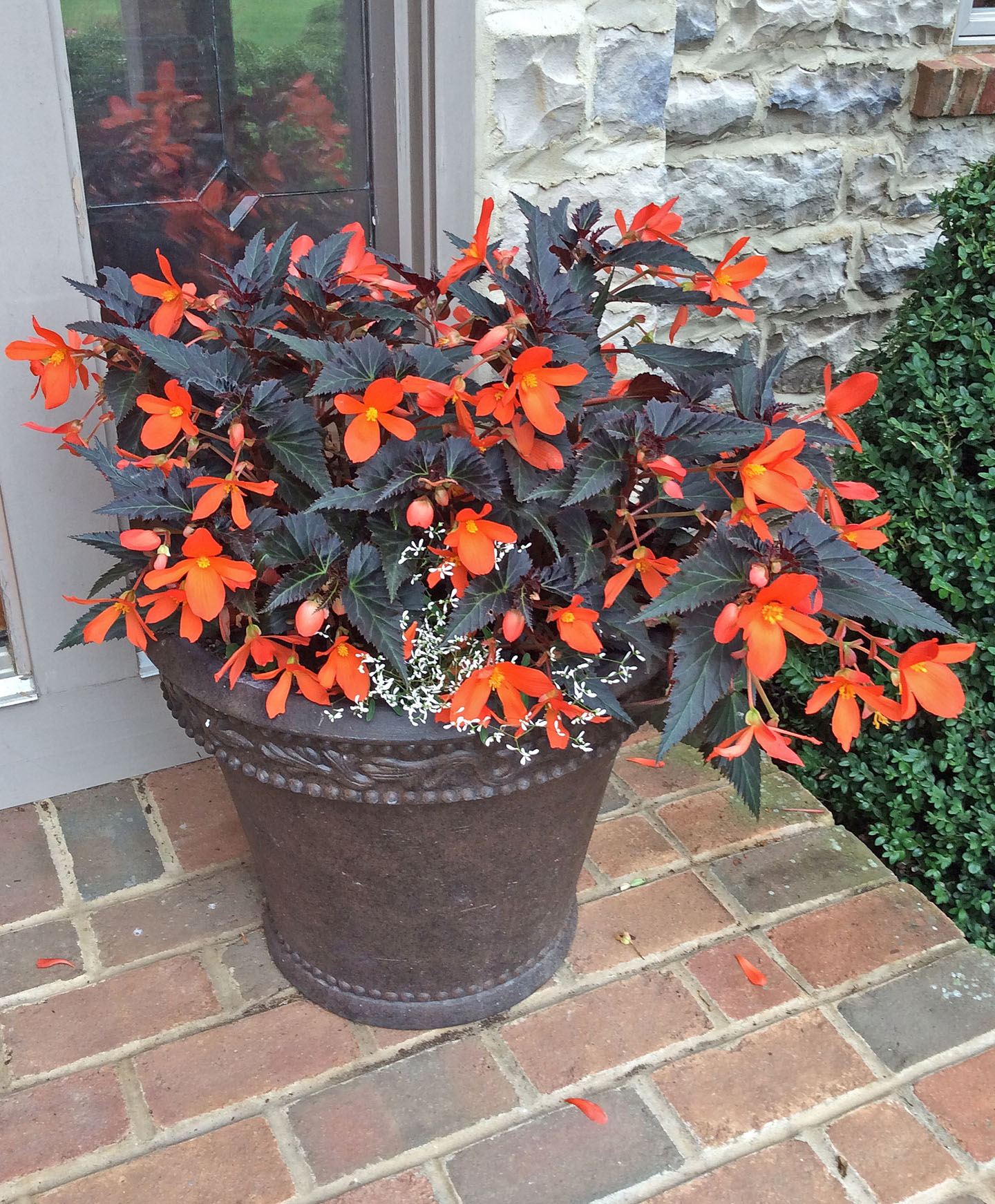
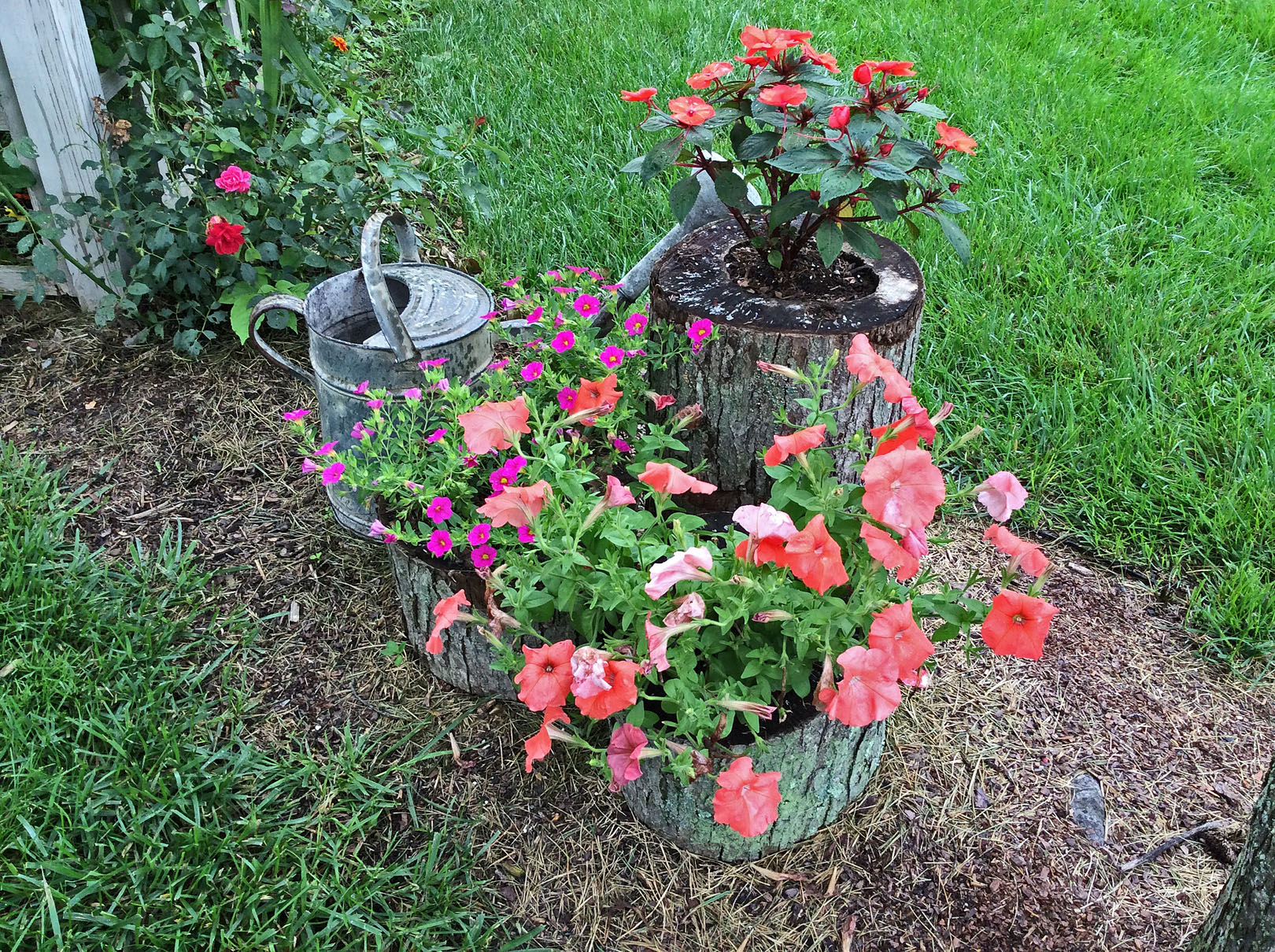
The vegetable-cutting garden is perfectly placed within easy access to Teresa’s workroom. The mass of crocosmia that you see below provided the flowers for a simple arrangement in the kitchen. The garden itself is an interesting interpretation a four-square design. Instead of opting for the traditional, Teresa created a more modern zig-zag design.
We can’t always control where our plants will roam. A volunteer pumpkin has escaped and entwined with butterflyweed. On the other side of the garden, Teresa purposely inter-planted potatoes with asparagus, purple coneflower and kiwi. The sacred Datura (right image; lower left) self-seeds as it will.
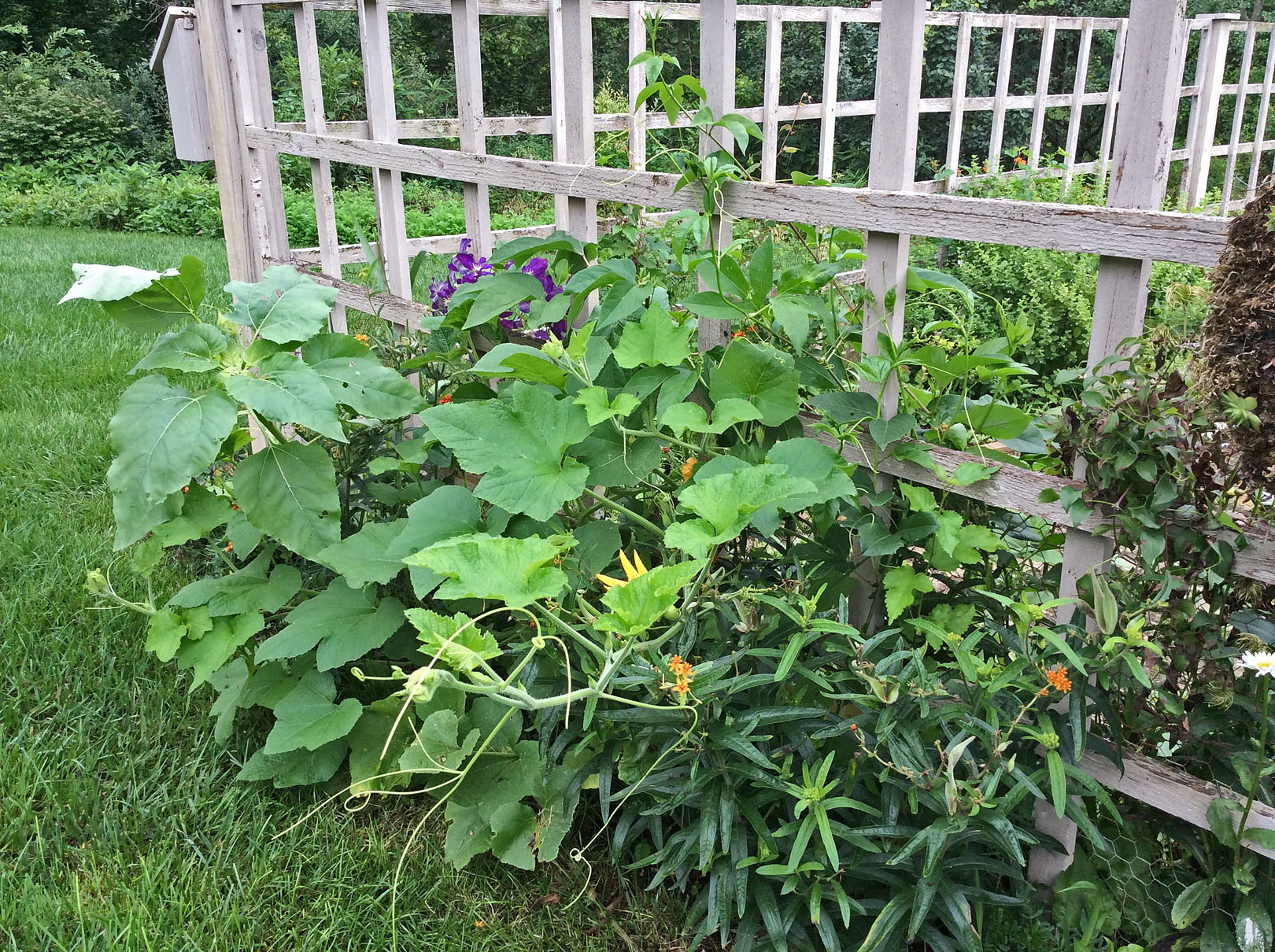
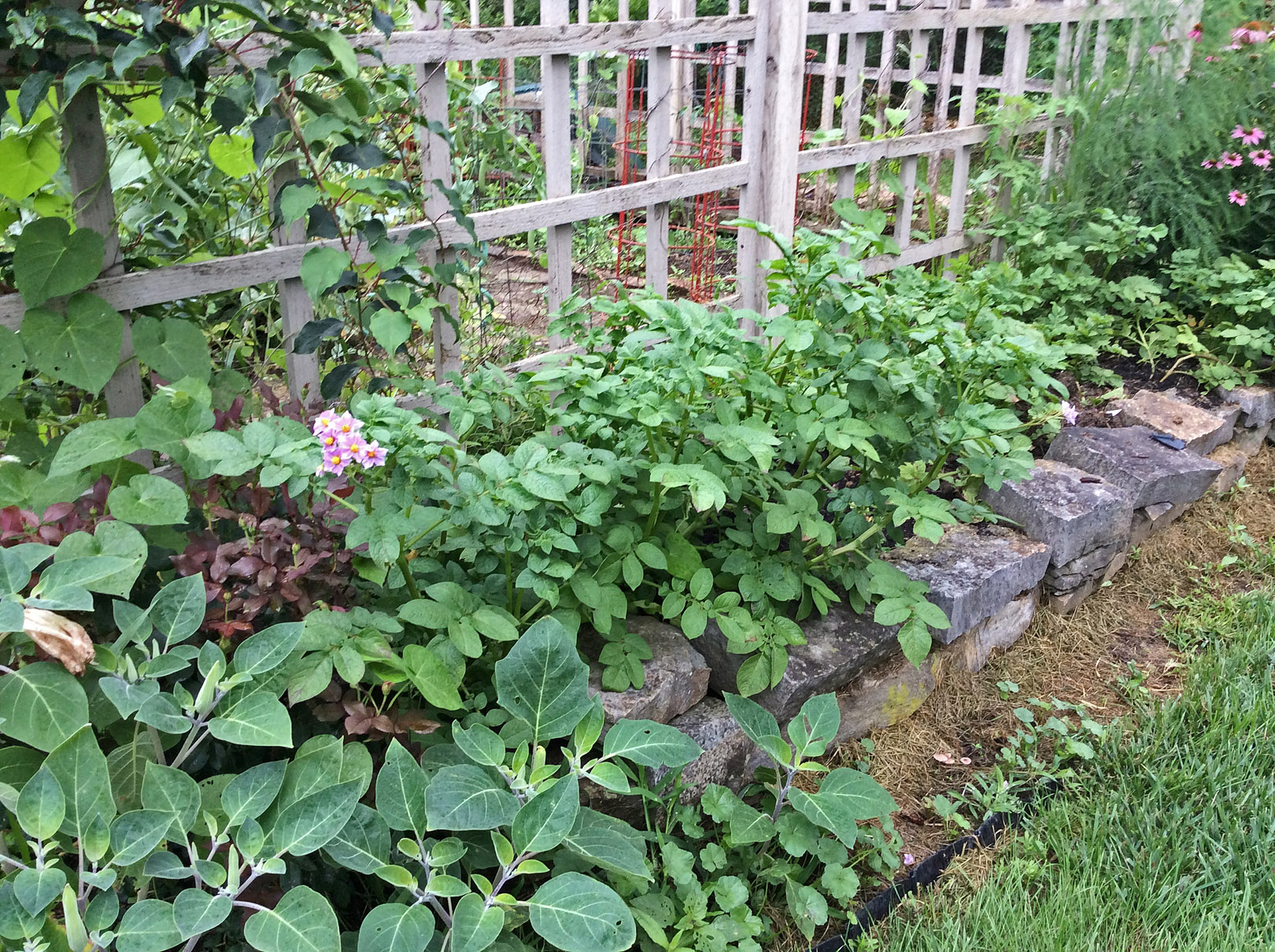
Onto the prairie – A personal favorite is false sunflower (Heliopsis sp.) which has spread along one portion of the prairie area. A close-up of another section reveals the intermingling of other prairie species. The patterns ebb and flow over the years depending on environmental conditions. Because of the rain, there were fewer pollinators present, but I have visited on a sunny day and the prairie was buzzing with a myriad of insects. The goldfinches are already harvesting the purple coneflowers.
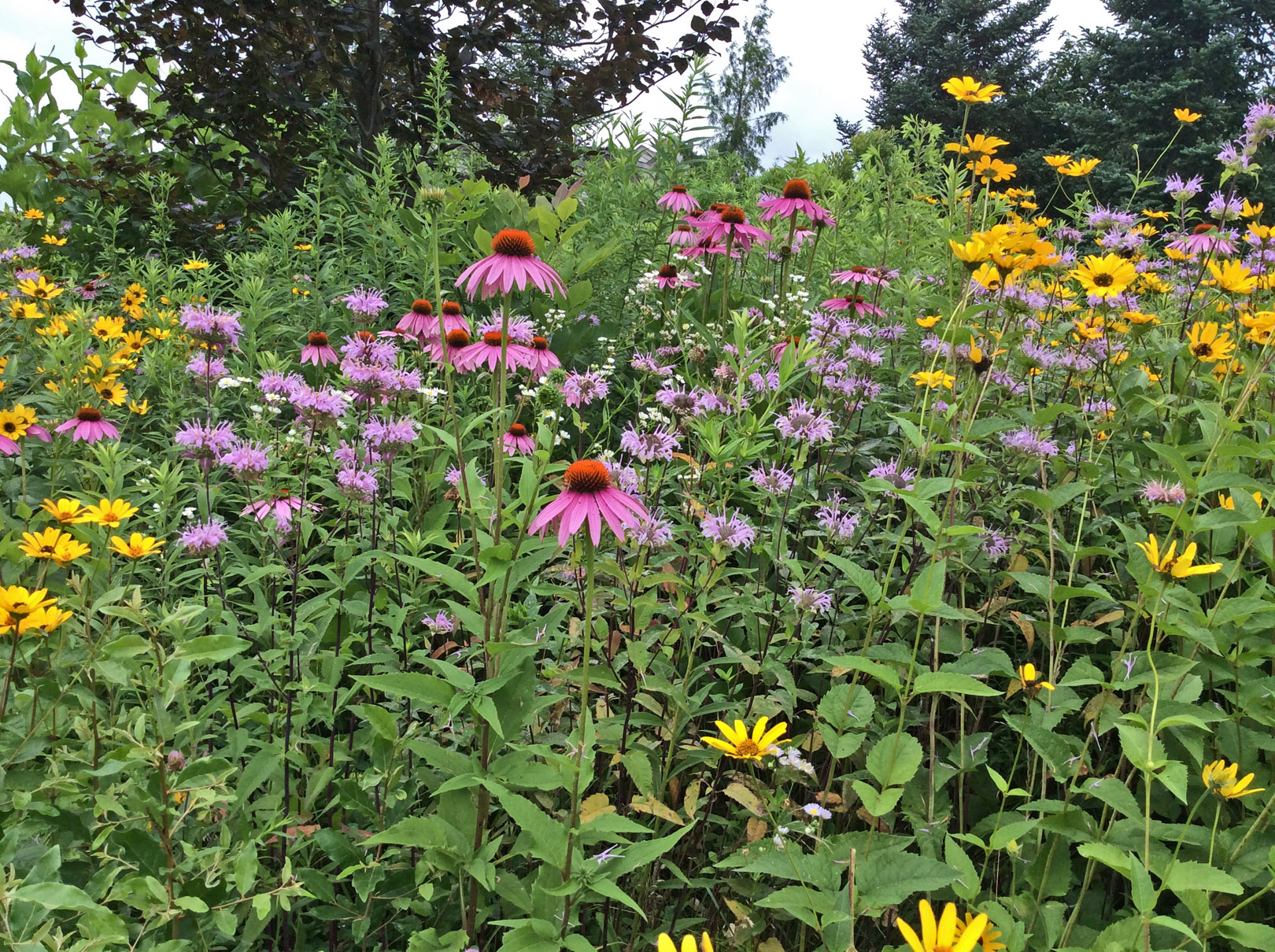
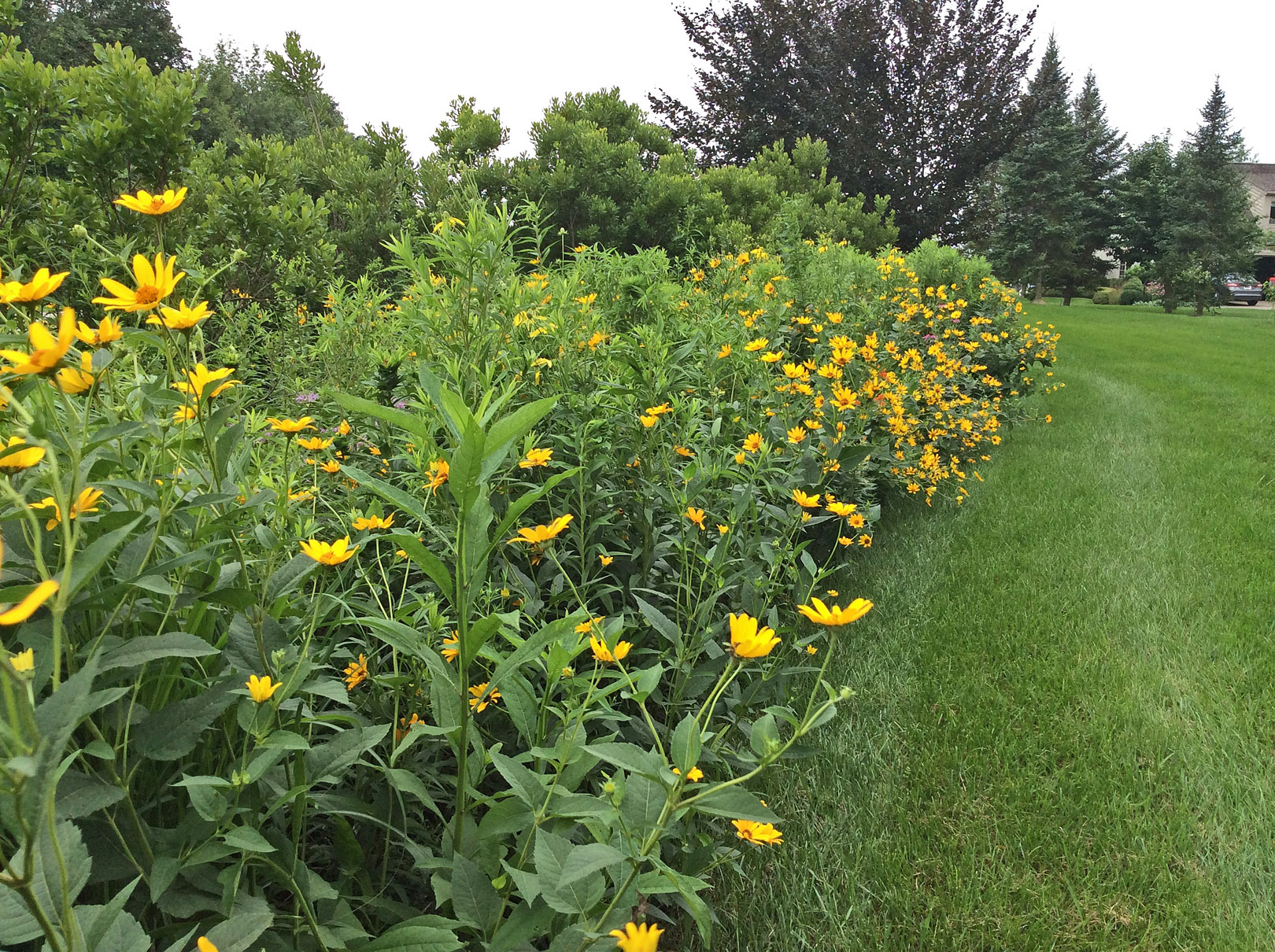
Next stop: visiting Teresa’s woods. Her son Mark installed a zip line and built a small treehouse and has made this part of the yard his own. We decided not to venture into this natural area because the mosquitoes were – quite literally – out for our blood! It was easier to avoid them by staying out in the open, breezy areas.
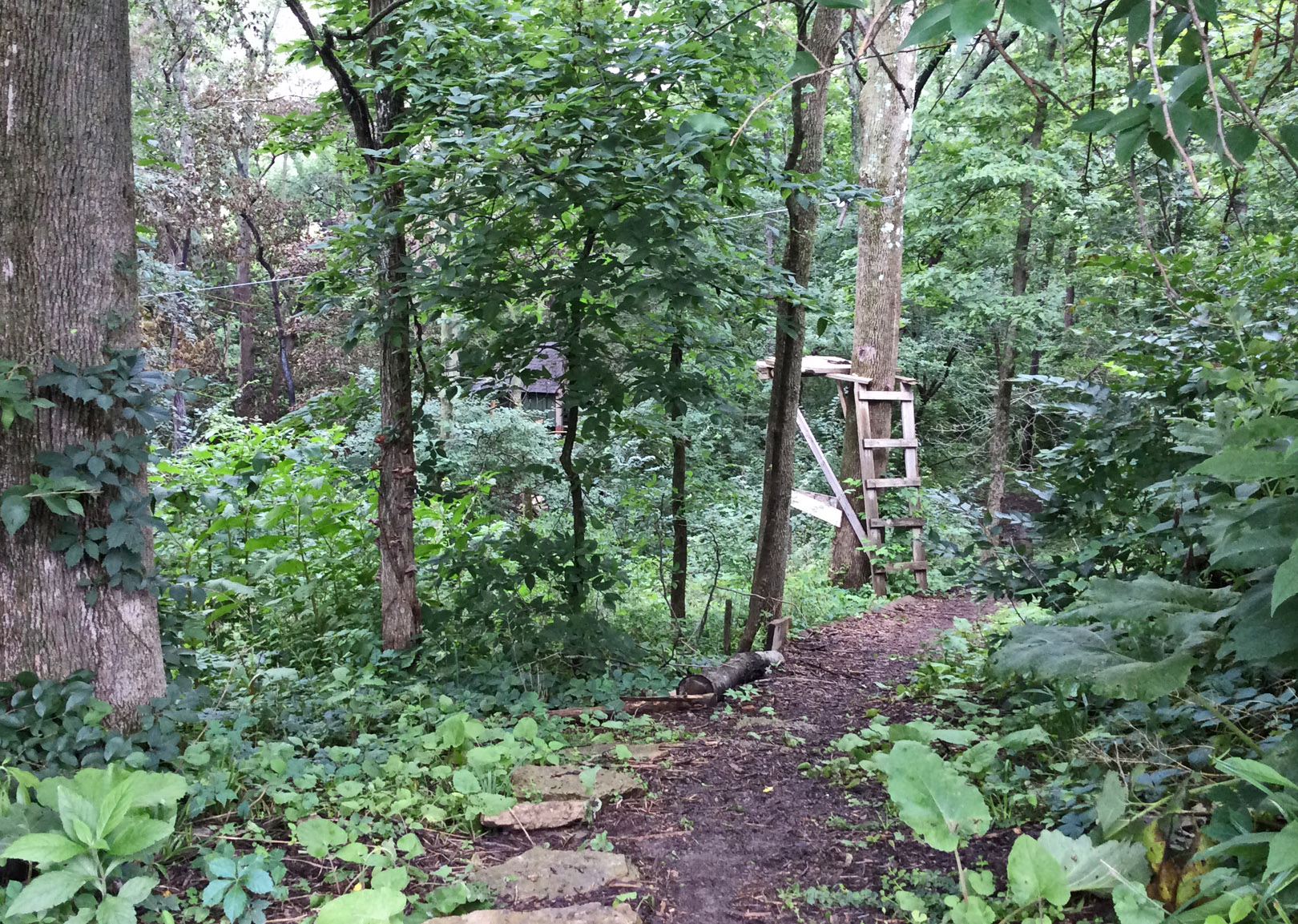
Just off the woods is the backyard terrace area where texture rules. In the lower area, we visited “the girls”. They often roam with Teresa as she works in the garden. I’m thinking how this might be a good addition to my own garden. Where else do you find an insecticide (insects are one of their favorite foods), a fertilizer, a tractor and a food provider wrapped up in one attractive package?
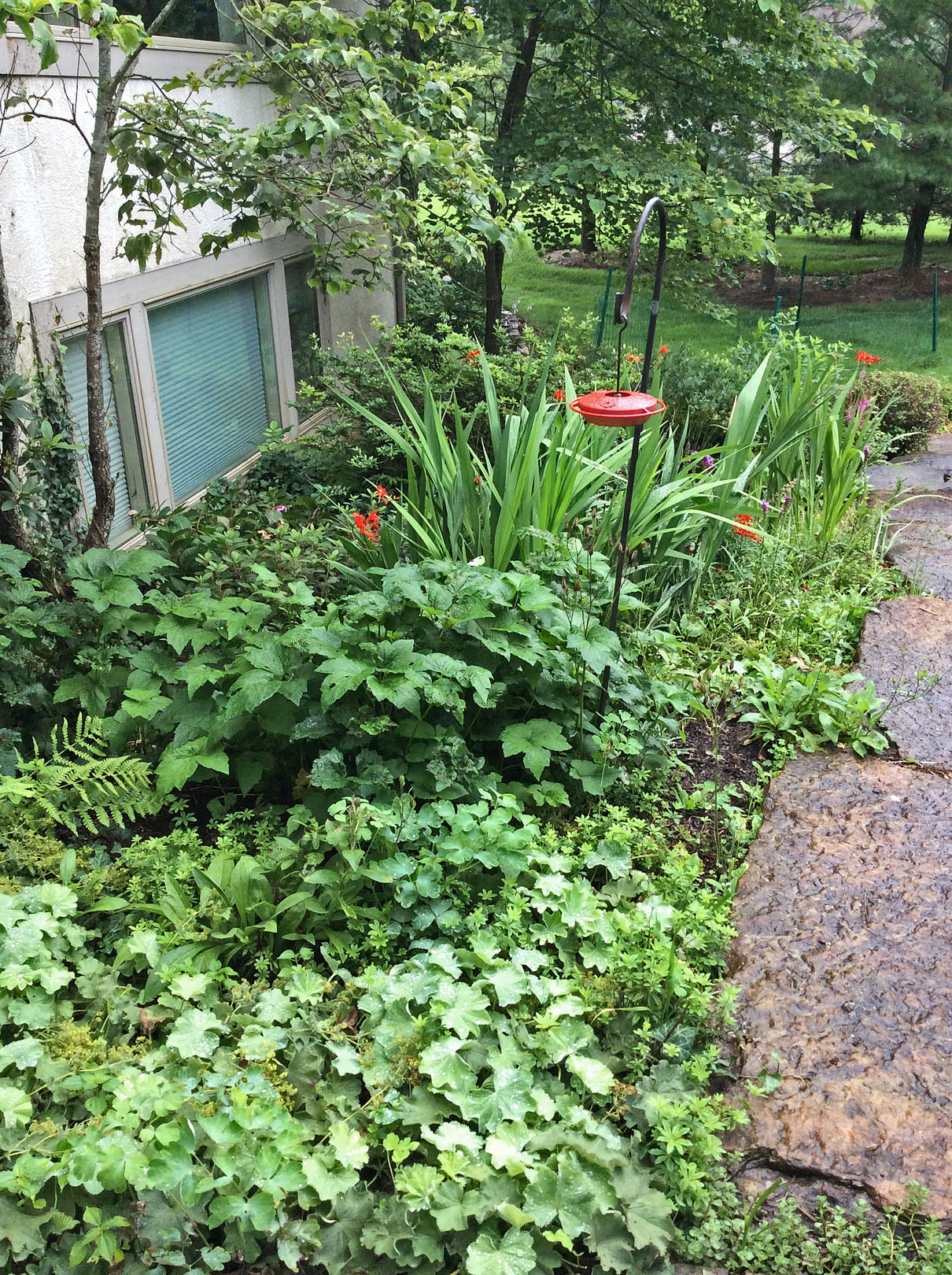
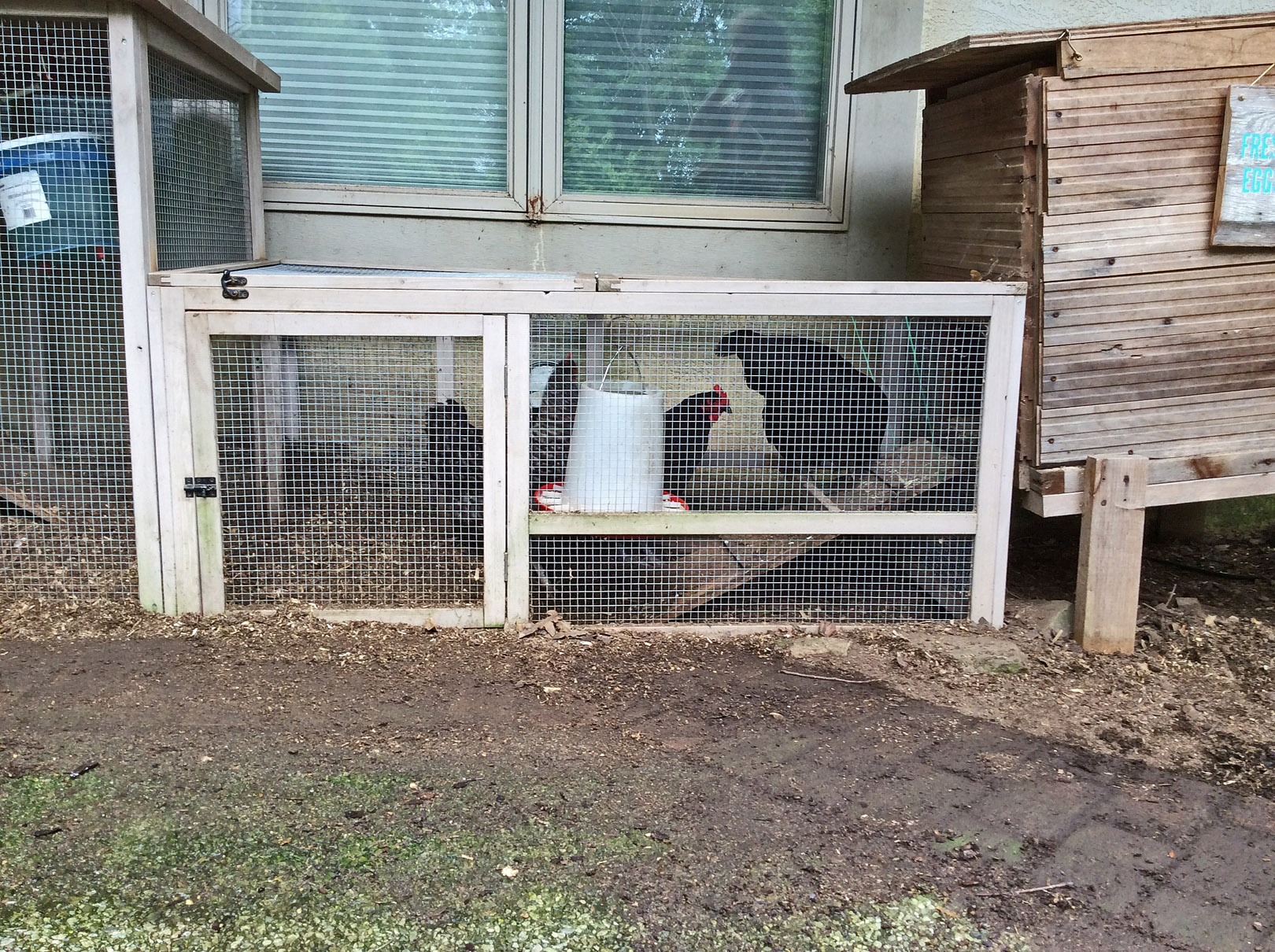
Coming out of the backyard into a semi-formal woodland garden, the rain started again. Time to say goodbye, accept some beautiful eggs, go home and bake.
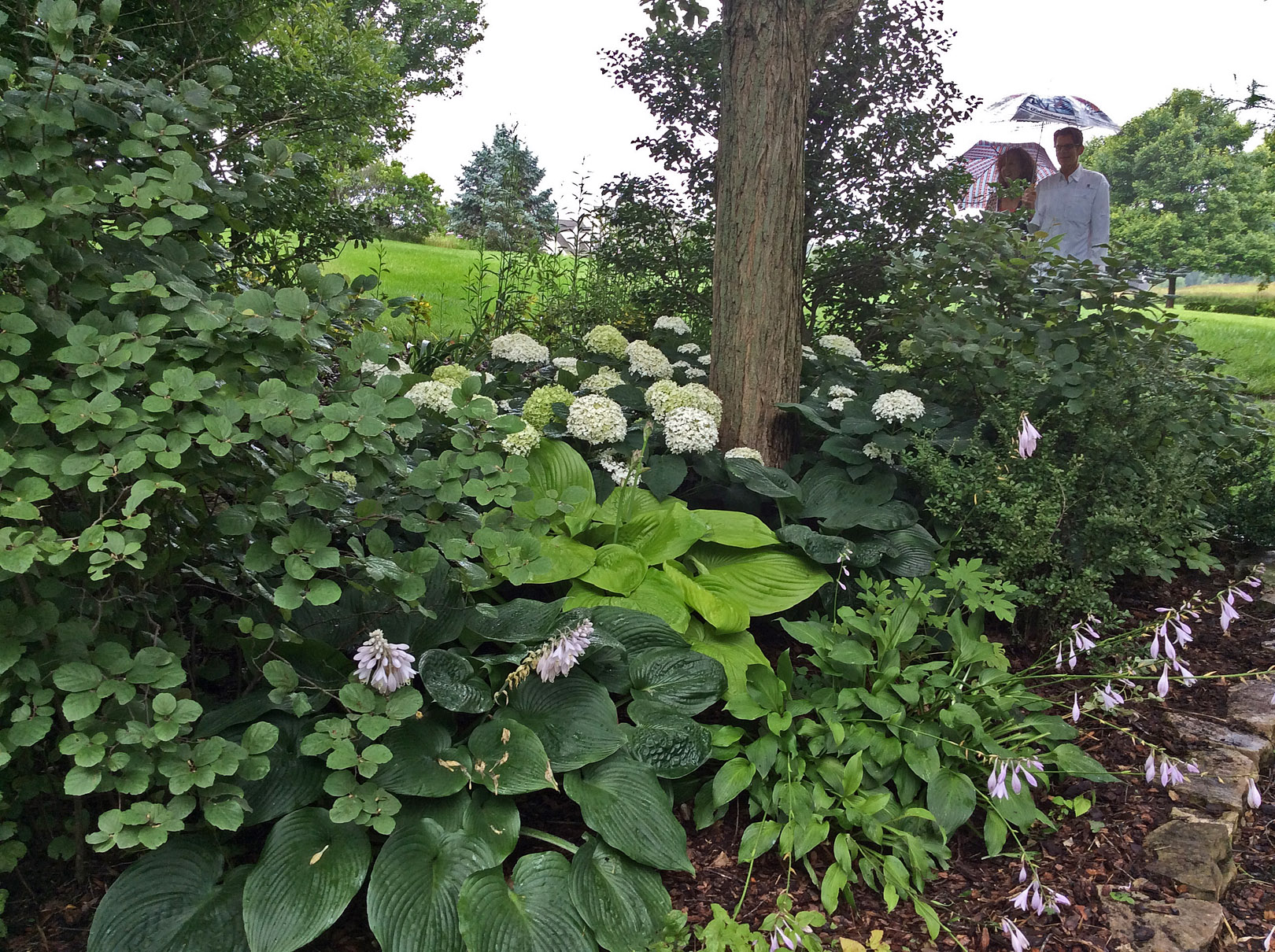
Wishing you beautiful moments in a garden…
by GardenLover | Jun 15, 2015 | Garden profile

By Teresa Woodard
Our fellow blogger Debra Knapke recently invited Michael  and me for a tour of her lovely 2/3 acre in northwest Columbus where she’s gardened for 31 years. As a horticulture teacher, author and lecturer, this “Garden Sage” uses her garden in so many ways. She trials new plants, teaches plant ID to horticulture students, experiments with various gardening techniques, explores nature with her grandchildren and finds much peace tending her treasure trove of plants.
and me for a tour of her lovely 2/3 acre in northwest Columbus where she’s gardened for 31 years. As a horticulture teacher, author and lecturer, this “Garden Sage” uses her garden in so many ways. She trials new plants, teaches plant ID to horticulture students, experiments with various gardening techniques, explores nature with her grandchildren and finds much peace tending her treasure trove of plants.
Can you tell we loved the garden??? Let us count the ways:
#10 Twenty-five hostas ranging from miniature ‘Popo’ to 3-foot ‘Sagae’
#9 Multiple pots of succulents — haworthia, aloe, agave, gasteria, Senecio rowleyanus (string of pearls), opuntia (variegated prickly pear cactus)
#8 A kaleidoscope of heucheras and heucherellas from a new hybrid ‘Berry Timeless’ to an old-time favorite ‘Frosted Violet’
#7 A bounty of Japanese maples and conifers like firs, larch, weeping blue spruce and false cypress
#6 A gallery of sculpture — even an iron sun that she welded with husband Tony
#5 A bounty of edible treats from alpine strawberries and blueberries to peas, tomatoes and an assortment of greens
#4 Collections of herbs, including sage (for the Garden Sage), lavender (her horticulture thesis plant), 15 thymes, parsley, rosemary and multiple mints
#3 Dozens of natives and wildlife favorites — spring ephemerals, bottlebrush buckeye, cup plant, monarda, pawpaws, little bluestem and more
#2 Lilies for granddaughter Lily
#1 One-of-a-kind treasures
Thanks, Debra, for sharing your wonderful plant collections with us!!!
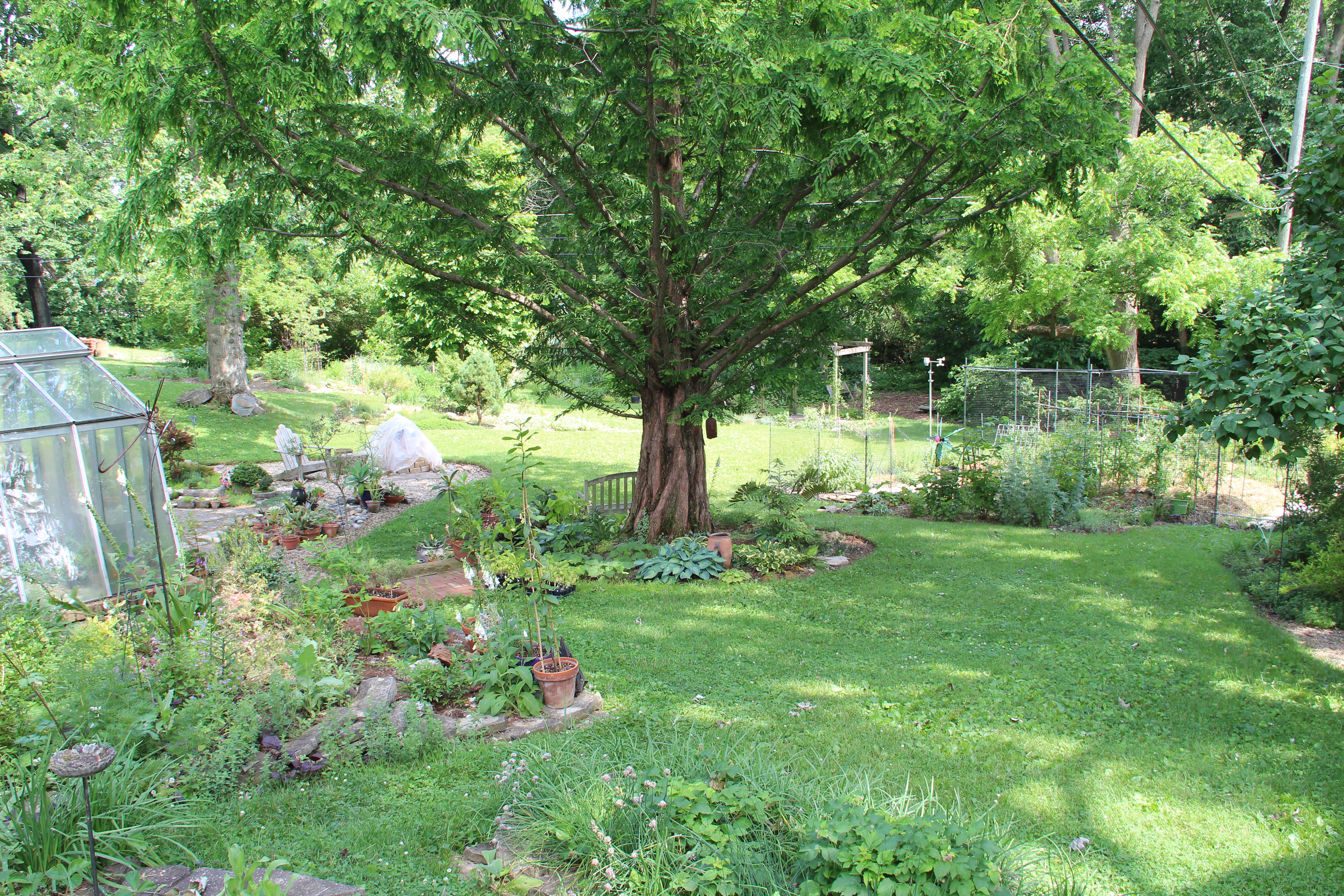
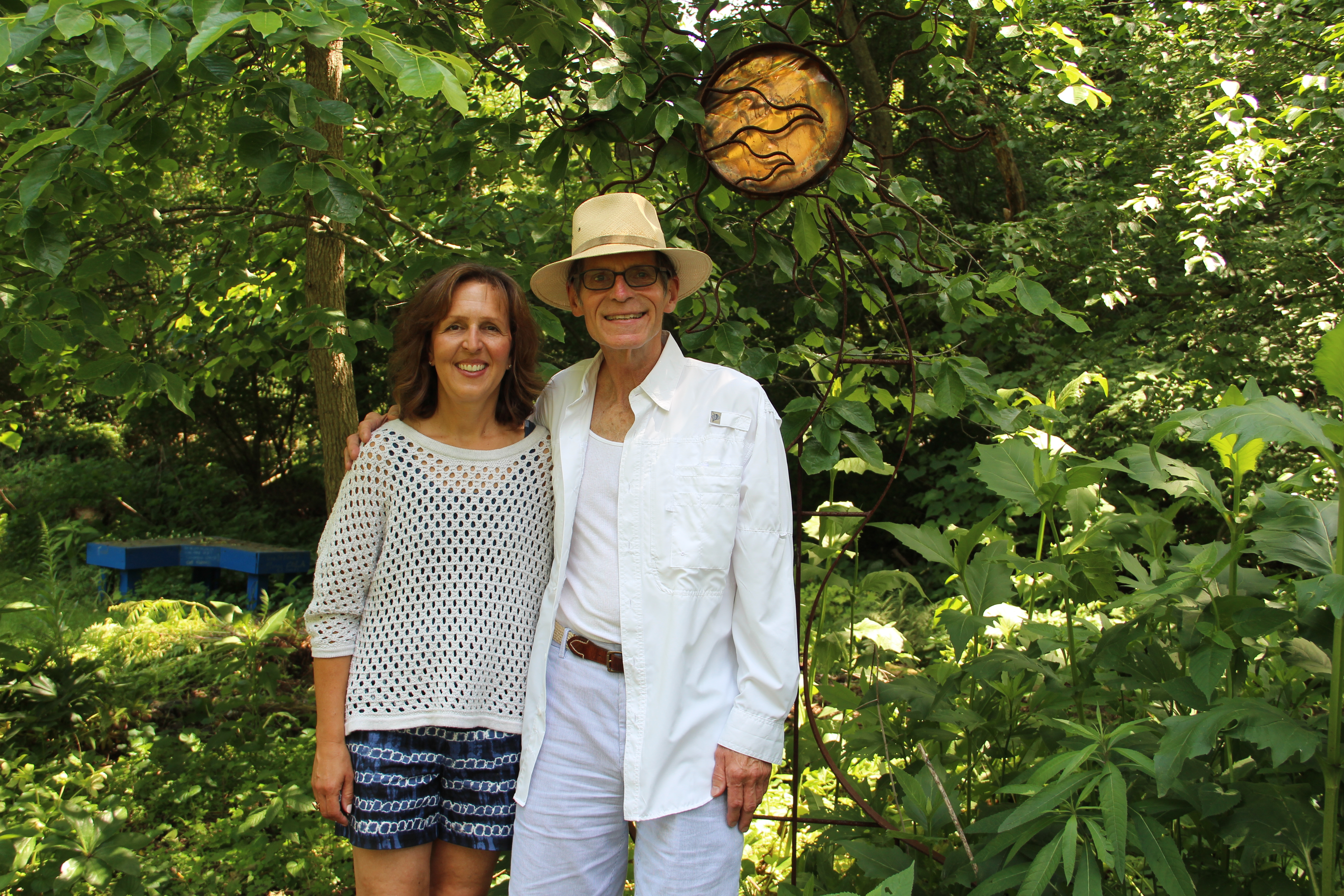

 2) Look for a spot to plant an allee of trees like this one of hornbeams.
2) Look for a spot to plant an allee of trees like this one of hornbeams.














 12) Create a small bog garden and fill it with pitcher plants like these.
12) Create a small bog garden and fill it with pitcher plants like these.












































